Annapurna vs Everest: Your definitive trekking guide
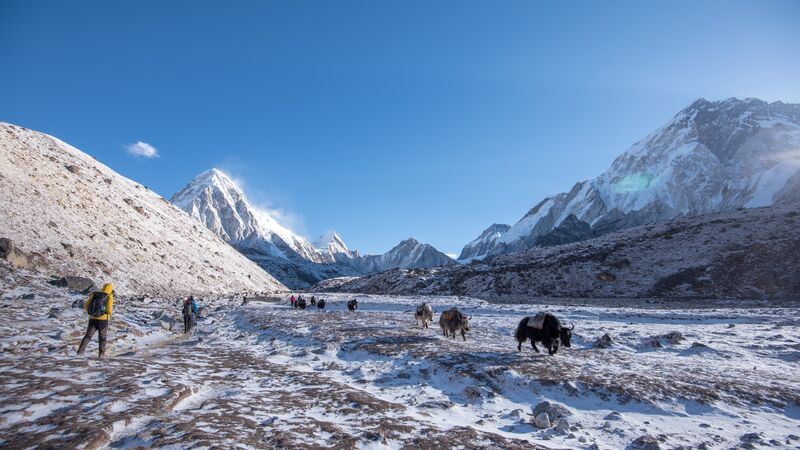
It’s the choice every keen Nepalese adventurer faces eventually: Annapurna or Everest Base Camp ? Most travellers end up trekking both in the end, because Nepal is one of those countries it’s hard to only do once.
On the one hand you have Mt. Everest. It’s world famous, comes with plenty of trek cred, and half your friends will probably assume you’re summiting the thing and planting a flag on the top. On the other hand you’ve got Annapurna: more diverse, less high, with gorgeous rhododendron forests and fewer crowds. Whose scene reigns supreme? It’s a tricky decision…

Everest Base Camp
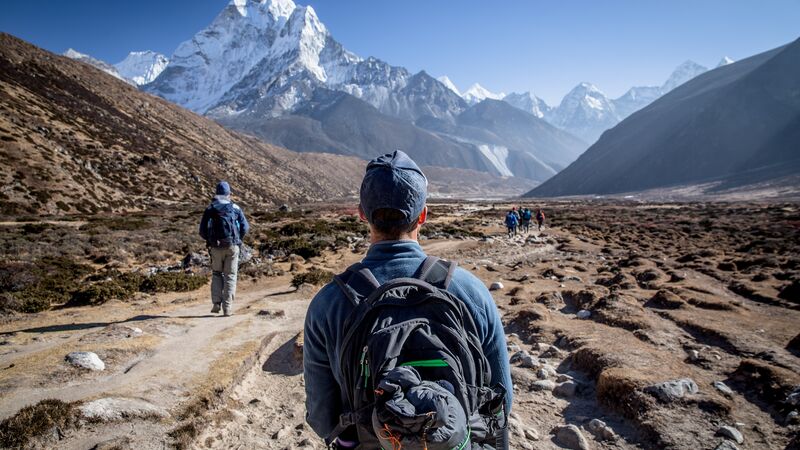
Photo by Lucy Piper.
Trekkers usually hike the Everest trail to get to the fluttering prayer flags of Basecamp, where many expeditions wait until their big ascents in May. The route itself is probably the most classically ‘Himalayan’ option in Nepal. The altitude is higher (you’ll reach 3420 meters in Namche Bazaar on Day 2), and you’re constantly surrounded by knife-like peaks. Gyoko Lakes and the lesser-trekked passes at Cho La are great detours from the usual trail, and Island Peak will get you some of the best views in the Himalayas.
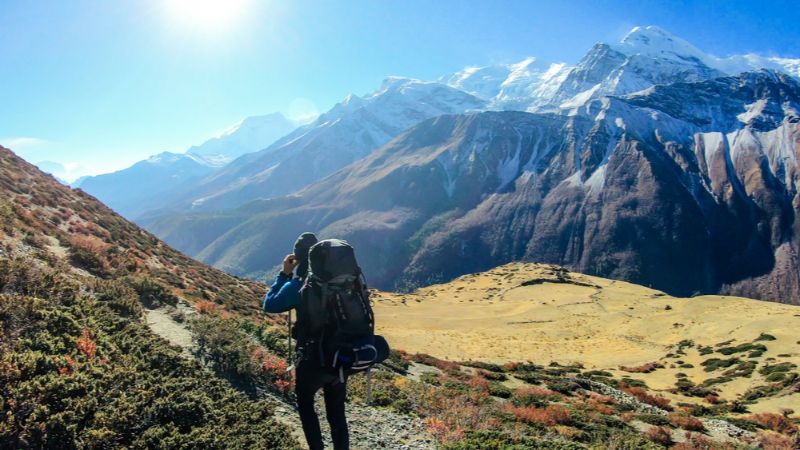
Photo by Christopher Moswitzer.
If you’re unsure of your mountaineering abilities, Annapurna is a slightly less taxing circuit. There are fewer steep climbs and the average altitude is much lower. Plus, instead of being funnelled into the Khumbu Valley on Everest, you can choose from a variety of trails, some of which don’t exceed 2000m in altitude. The descents on Annapurna are also a bit gentler, which can help the knees in the long run. And don’t discount the advantage of a circuit route: trekking new terrain every day without ever retracing your steps.
Getting there
Hillary and Tenzing had to schlep it on foot all the way from Kathmandu in the 50s. No roads existed at the time. These days it’s a little easier, and travellers can take a short (and spectacular) flight from Kathmandu to the tiny airstrip at Lukla. The views on the way in, and the way out, are worth the journey alone.
The gateway to the Annapurna’s is the cool little town of Pokhara, sitting on the shores of the gorgeous Phewa Lake. It’s a laid back place where you happily just spend a week Zenning out with a good book, and you can reach it with by bus or plane from Kathmandu. Easy.
RELATED: MORE THAN MOMOS: A GUIDE TO NEPALI CUISINE
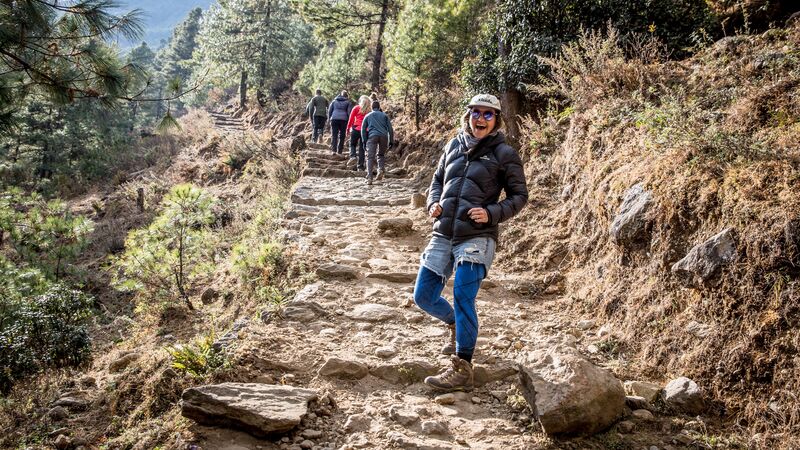
If you’re coming just the mountains, for the biggest, wildest, most precipitous mountains you can find, Everest is the way to go. It’s a high altitude trek through some of the most spectacular scenery in all of the Himalayas. Trekking through the Gyoko Lakes, they literally surround you on all sides. But be aware, you pay for these views with sore calves and aching thighs.
Annapurna is a totally different side of the Himalayas. You still get huge, snow-capped peaks, but they’re more of a constant backdrop. The Circuit begins in the fertile lower foothills, winding through terraced rice fields, oak forests and rhododendrons galore (come in April for the full bloom). And mountain-lovers, don’t worry, there are still the incredible sites of Machapuchare and the 8000m giant Dhaulagiri to keep you happy. Annapurna just has more diversity to go with its stunning views.
RELATED: BEYOND BASE CAMP: 6 AMAZING DESTINATIONS IN NEPAL
Communities
The valleys around Everest are traditionally the home of the Sherpa people and Buddhist monasteries, and you can feel the strong sense of spirituality as you pass through. Tibetan traders still visit the village of Namche Bazaar, as they’ve done for centuries, and in fact word Sherpa actually means ‘east people’ (the Sherpas migrated east from Tibet long ago). If you’re trekking the Everest trail in March or April, you’ll probably come across professional teams looking to make their summit climb in May.
CHECK OUT OUR FULL RANGE OF WALKING & TREKKING ADVENTURES HERE
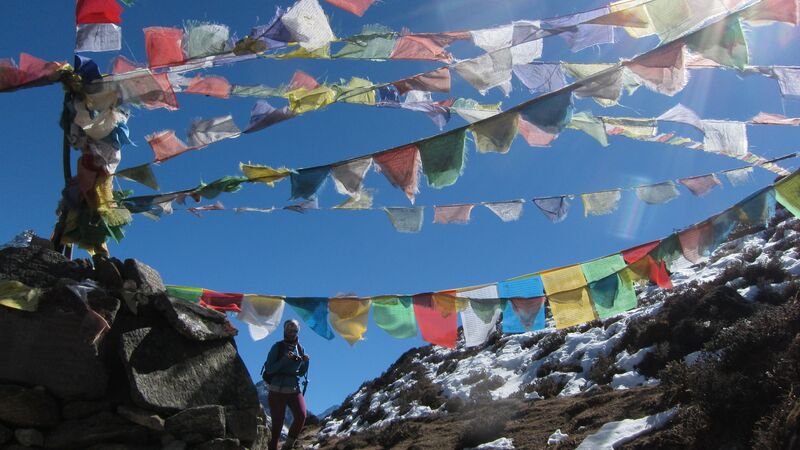
Team Annapurna? Right this way. Or is Everest more your speed? We’ve got that covered too.
Feeling inspired?
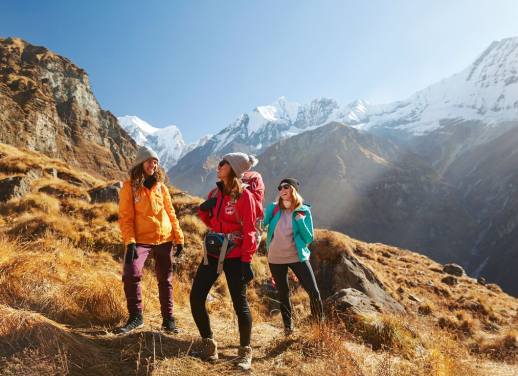
James Shackell
I was born in 1987 and aged from there. I like the sound of pop-rocks and dislike the sound of styrofoam. The length of my forearm is approximately the same as the length of my shin. My favourite Beatle is Ringo. I believe that junk food tastes so good because it’s bad for you and that your parents did the best job they knew how to do. If Johnny Cash wrote a song about my travels it would be called ‘I’ve been to several places but still have many other destinations on my to-do list, man’. Sometimes I have trouble finishing sen
You might also like
Why 2024 is the best year to see..., 6 unique experiences you can have in el..., from delhi to udaipur, here are the five..., cinque terre vs amalfi coast: which destination to..., love at first bite: 10 famous sandwiches from..., galapagos or madagascar which unique destination should be..., central vs south america: how to plan your..., why road-tripping is the best way to see..., lessons learned on intrepid’s sabah adventure, travelling to chile here’s the best time to..., france or italy which european country should you....
I'm hiking Nepal for 3 weeks, do I trek Everest Base Camp or Annapurna Circuit?

Feb 22, 2024 • 3 min read
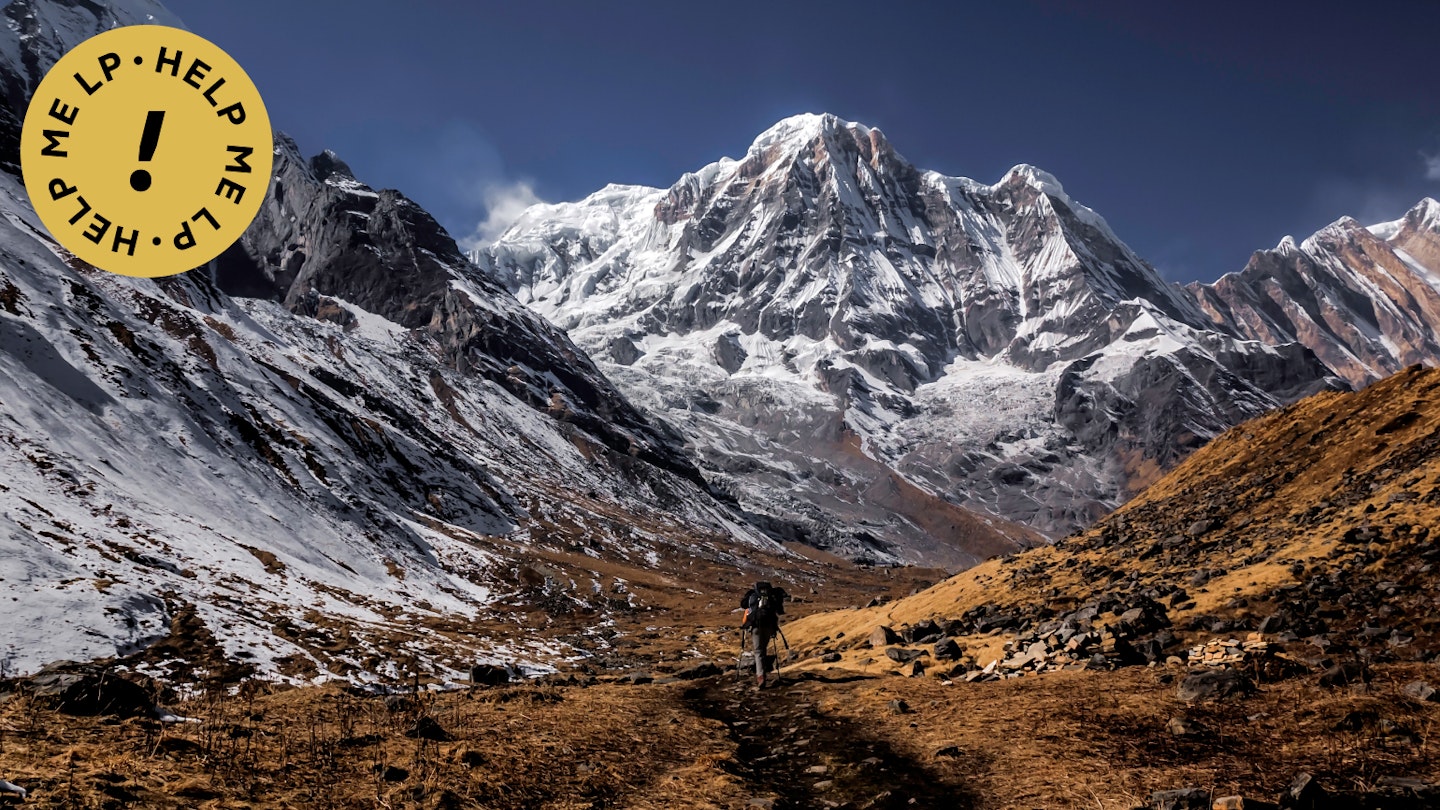
We can help you choose between the Everest Base Camp and Annapurna Circuit treks in Nepal © Russ Nordstrand / 500px
Himalayas specialist Bradley Mayhew, who writes our guidebooks to Nepal, Bhutan and Tibet, answers a question about trekking routes in Nepal.
Question: I have three weeks planned for trekking in Nepal and I can’t decide between the Everest Base Camp and Annapurna Circuit treks. Can you help?
Answer: Ah, so many trails in Nepal, so little time…
Firstly, the Annapurna Circuit and Everest Base Camp treks have some things in common. Both offer excellent lodging in hundreds of trailside teahouses and an infrastructure of shops, bakeries, wi-fi and guides that makes for easy logistics. Both have world-class mountain scenery in valleys flanked by some of the world’s highest peaks, both require acclimatization to altitudes of over 5400m (17,717ft) and both are packed with trekkers in the high season months of October, November and April.
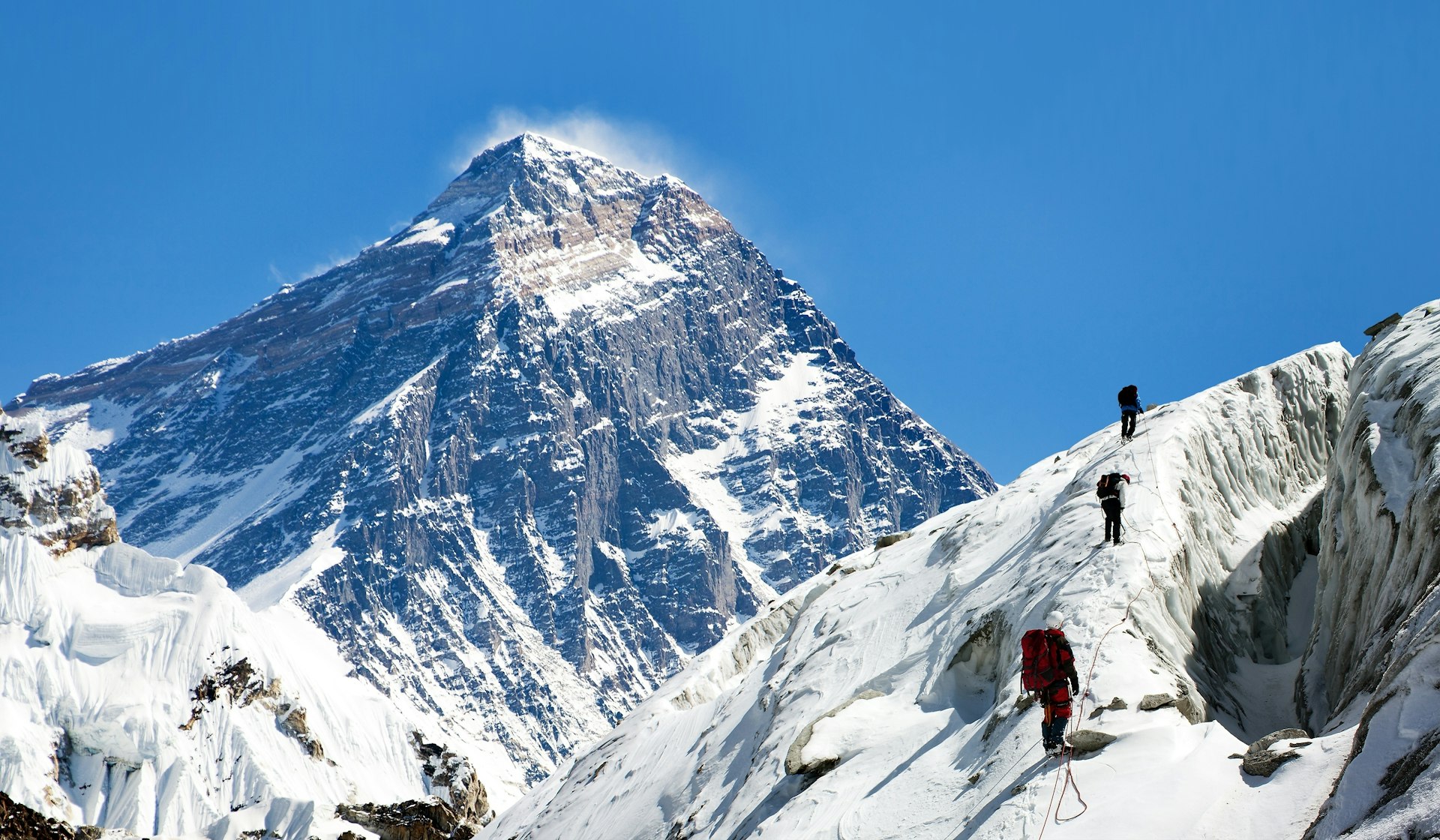
Everest is iconic, but more costly and complicated to reach
There are also differences between the two treks. Everest is a bit more complicated and expensive to reach. Most people fly to the trailhead Lukla and start the trek straight off the runway, which is convenient but expensive (US$430 return) and can present challenges when bad weather grounds flights for days at a time. (Be aware also that during high season flights to Lukla often depart from Ramechhap, not Kathmandu , which adds on a five-hour drive.) The only alternative to flying is a long, punishing ride in shared jeeps, or a weeklong walk (my preferred option, if you have the time).
You need a minimum of two weeks to trek to Base Camp and back, and I would strongly recommend adding up to a week to investigate the quieter but equally stunning side valley of Gokyo. In contrast, the core Annapurna Circuit section to Jomsom can be done in as little as nine days.
Everest has the irresistible lure of the world’s highest peak but you actually don’t see much of it; far more interesting is the climbing literature and the fact that you are walking in the footsteps of the world’s great climbers. The Everest trek gets you closer to the heart of the high mountains than the Circuit, which offers more in the way of traditional village life. Finally, Everest Base Camp is an out-and-back trek, so you’ll repeat some sections, whereas Annapurna is by its nature an A to B loop.

Annapurna's trails are often roadside, but offer greater flexibility
The Annapurna region is a lot more accessible; in fact you can be walking the trails in less than an hour by bus from Pokhara town. The big downside with the Annapurna Circuit (and it’s a big downside) is road construction. A jeep road now reaches as far as Manang on the eastern side, and Muktinath on the western side, which leaves only three days of roadless walking between them. The roads have taken a lot of the charm away from the circuit, so if you do decide to walk it I’d really urge you to read up on the alternative NATT trails that lead you away from most of the dusty road. During the second half of the trek in the Kali Gandaki Valley these side trails and excursions make for some stunning day walks, returning to roadside teahouses. It’s a different kind of walking, but it gives you great flexibility, meaning you can adjust your Annapurna Circuit trek to anywhere between a week and 21 days.
So, which is better?
Both trails offer a fabulous taste of Nepal trekking, but both are busy in high season and reward a bit of research into the excellent alternative trails and side trips which, for me, make these treks stand out. If avoiding the crowds is important to you, consider something different completely: the wonderful Manaslu Circuit teahouse trek, or an adventurous rough-and-ready trek out to the base of Kangchenjunga in the far east. Whatever you choose, your first trek in Nepal will almost certainly not be your last.
Explore related stories
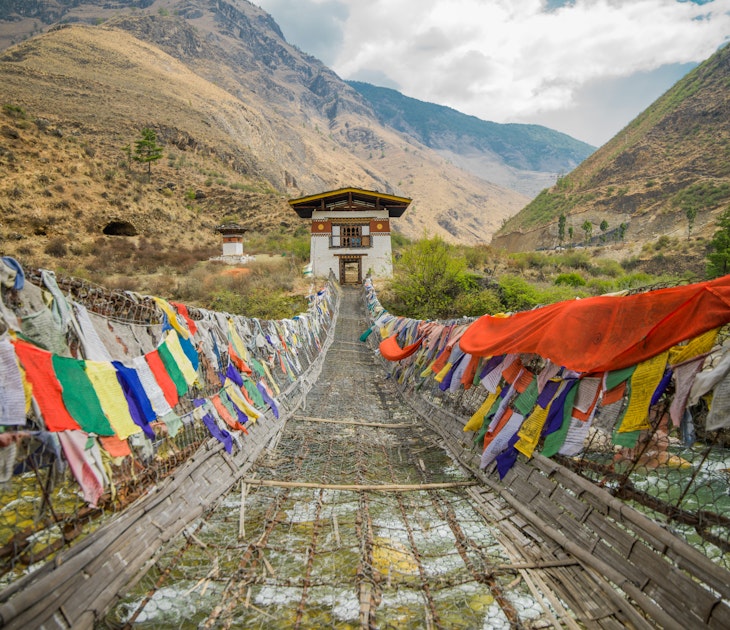
Aug 31, 2023 • 11 min read
When Bhutan reopened after the pandemic, the government raised tourist fees dramatically. Now they are coming back down. Here’s what you need to know.
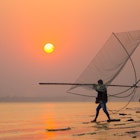
Oct 10, 2019 • 9 min read

Jan 11, 2024 • 4 min read
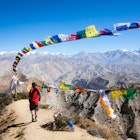
Dec 23, 2023 • 7 min read
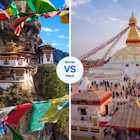
Dec 20, 2023 • 7 min read

Dec 16, 2023 • 12 min read

Oct 15, 2023 • 3 min read
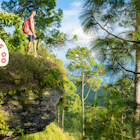
Sep 18, 2023 • 7 min read
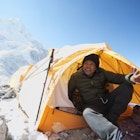
Jun 20, 2023 • 10 min read

Trek To The Clouds

Everest Base Camp vs Annapurna Base Camp: Which One Should You Choose?
Looking to trek in Nepal but can’t decide between Everest Base Camp vs Annapurna Base Camp Trek? This blog helps you compare the two routes, covering everything from scenery to cost.
Hiking in the Himalayas is a dream for many travelers. And two of the most popular treks in Nepal are Everest Base Camp Trek and Annapurna Base Camp Trek . Both offer stunning views, challenging terrain, and unique cultural experiences. However, there are some significant differences between the two treks that you should consider before making your decision.
In this blog, we will compare Everest Base Camp vs Annapurna Base Camp Trek to help you decide which one is the best fit for you.
Table of Contents
Overview of Everest Base Camp Trek
Everest Base Camp Trek is one of the most popular trekking destinations in the world. It is a challenging yet rewarding adventure that offers stunning views of the world’s highest mountain, Mount Everest. The trek takes you through the beautiful Sagarmatha National Park , a UNESCO World Heritage Site , and offers a chance to explore the unique Sherpa culture and their traditional lifestyle.

It starts from the village of Lukla , which can be reached by a short flight from Kathmandu. From there, the trail takes you through various Sherpa villages like Namche Bazaar , Tengboche , Dingboche , and Gorak Shep . The trek passes through beautiful forests of rhododendron, oak, and pine trees, along with the mighty Dudh Koshi River.
The trek is not for the faint-hearted and requires a good level of physical fitness. The high altitude and unpredictable weather conditions make the trek challenging, and proper acclimatization is crucial to prevent altitude sickness. The best time to do the trek is from March to May and from September to November .
Reaching the Everest Base Camp is the most rewarding part of this journey, which is located at an altitude of 5,364 meters. From here, you can witness the majestic beauty of the Khumbu Icefall and the surrounding Himalayan peaks. Another highlight of the trek is climbing to the top of Kalapatthar, which offers stunning panoramic views of Mount Everest and other surrounding peaks.
Overall, the Everest Base Camp Trek is a once-in-a-lifetime adventure that offers a unique blend of natural beauty, cultural experience, and physical challenge. It is a must-do for all adventure enthusiasts and nature lovers who want to experience the beauty of the Himalayas up close.
Overview of Annapurna Base Camp Trek
Annapurna Base Camp Trek passes through Tikhedhunga , Ghorepani , and Chomrong and is a moderately challenging trek that can be accomplished by those with a basic level of fitness. The path winds through thick forests of rhododendron and oak trees, as well as gorgeous waterfalls and streams. The ideal time to undertake this trek is between March and May or from September to November .

The main attraction of the trek is the Annapurna Base Camp , situated at an altitude of 4,130 meters. From here, one can marvel at the stunning beauty of the Annapurna mountain range, which includes Annapurna I , Annapurna South, and Machhapuchhre (also known as Fishtail). Another must-see location on this trek is Poon Hill, which provides breathtaking panoramic views of the Annapurna and Dhaulagiri mountain ranges.
All in all, the Annapurna Base Camp Trek is a diverse and beautiful journey that offers a unique blend of natural beauty, cultural experiences, and physical challenges. It is an excellent alternative to the Everest Base Camp Trek and is a must-do for any adventurer or nature lover who wishes to experience the splendor of the Himalayas.
Everest Base Camp vs Annapurna Base Camp Trek
Both the Everest Base Camp Trek and the Annapurna Base Camp Trek offer unique experiences and stunning views of the Himalayas. However, there are some key differences between the two treks that you should consider before making a decision. Let’s start:
Trek Difficulties
When it comes to difficulty, the Everest Base Camp Trek is generally considered to be more challenging than the Annapurna Base Camp Trek. This is mainly due to the higher altitude and more unpredictable weather conditions in the Everest region.
The Everest Base Camp Trek takes you to an altitude of 5,364 meters, while the Annapurna Base Camp Trek takes you to an altitude of 4,130 meters. The higher altitude of the Everest Base Camp Trek makes it more challenging and requires proper acclimatization to prevent altitude sickness . In contrast, the Annapurna Base Camp Trek is considered to be moderate in difficulty and can be done by people with a basic level of fitness.
In terms of terrain, both treks have their unique challenges. The Everest Base Camp Trek has steep ascents and descents, rocky terrain, and some technical sections. The Annapurna Base Camp Trek, on the other hand, has a more gradual ascent and descent, with some steep sections and uneven terrain.
Both treks require a good level of physical fitness and preparation. However, the Everest Base Camp Trek is more demanding and requires more preparation and training than the Annapurna Base Camp Trek.
Routes Altitude
The altitude is one of the significant factors that differentiate the two treks. The Everest Base Camp Trek is a high-altitude trek that takes you to an elevation of 5,364 meters at the base camp. It is one of the highest treks in the world, and the altitude poses a significant challenge to trekkers. Proper acclimatization is essential to prevent altitude sickness, and trekkers need to spend several days adjusting to the altitude before reaching the base camp.

In contrast, the Annapurna Base Camp Trek is a moderate-altitude trek that takes you to an elevation of 4,130 meters at the base camp. It is a lower altitude than the Everest Base Camp Trek, and the altitude is less of a concern for trekkers. However, trekkers still need to acclimatize properly and take precautions to prevent altitude sickness.
The altitude difference between the two treks also affects the weather and climate. The Everest Base Camp Trek is located in the Everest region, which is known for its extreme weather conditions and unpredictable climate. The Annapurna Base Camp Trek is located in the Annapurna region, which has a more stable and predictable weather pattern.
Also, the Everest Base Camp Trek is a high-altitude trek that requires proper acclimatization and poses significant challenges to trekkers. On the other hand, the Annapurna Base Camp Trek is a moderate-altitude trek that is less demanding and less affected by altitude.
Both the Everest Base Camp vs Annapurna Base Camp Trek are renowned for their breathtaking scenery and challenging trails. However, there are some notable differences between these two treks in terms of the scenery they offer.

The Everest Base Camp Trek takes trekkers through the heart of the Himalayas, offering stunning views of the world’s highest mountain range. The trek starts in the bustling city of Kathmandu and takes around 12 days to complete. Along the way, trekkers will pass through charming Sherpa villages and ancient monasteries, before finally reaching Everest Base Camp at an altitude of 5,364 meters (17,598 feet). The scenery on this trek is characterized by towering peaks, icy glaciers, and snow-capped mountains. Trekkers will also get the chance to witness the famous Khumbu Icefall, which is a natural wonder in itself.
On the other hand, the Annapurna Base Camp Trek is situated in the central region of Nepal and takes trekkers through lush forests, traditional villages, and terraced fields. The trek starts in the picturesque town of Pokhara and takes around 10 days to complete. Trekkers will journey through the Annapurna Conservation Area, which is home to a diverse range of flora and fauna. The scenery on this trek is characterized by lush green forests, cascading waterfalls, and terraced fields of rice and wheat. As trekkers ascend higher, they will be greeted by panoramic views of the Annapurna range and the iconic Machapuchare peak .

Both the Everest Base Camp vs Annapurna Base Camp Trek offer unique and awe-inspiring scenery. While the Everest Base Camp Trek is renowned for its rugged, snow-capped peaks and glacial landscapes, the Annapurna Base Camp Trek is known for its lush forests, terraced fields, and cascading waterfalls.
When it comes to trekking in Nepal, cost is an important factor to consider. Both the Everest Base Camp vs Annapurna Base Camp Trek are popular trekking routes, but they differ in terms of cost.
The Everest Base Camp Trek is considered to be the more expensive of the two treks due to the high altitude and remote location. The cost of the trek can range from $1,000 to $2,500 depending on the type of package you choose. The package usually includes transportation to and from Kathmandu, accommodation, meals, and a guide. If you opt for a luxury package, the cost can go up to $5,000 or more. Additionally, there are additional costs such as trekking permits , flights to and from Lukla , and equipment rental that you need to consider.
Alternatively, the Annapurna Base Camp Trek is generally considered to be a more affordable trekking option. The cost of the trek can range from $500 to $1,500 depending on the type of package you choose. The package usually includes transportation to and from Pokhara, accommodation, meals, and a guide. If you opt for a luxury package, the cost can go up to $3,000 or more. Additionally, there are additional costs such as trekking permits and equipment rental that you need to consider.
It’s worth noting that the cost of both treks can vary depending on the time of year you choose to trek, the length of the trek, and the level of comfort you prefer. Furthermore, it’s important to factor in additional expenses such as travel insurance, visas, and vaccinations.
In conclusion, the Everest Base Camp vs Annapurna Base Camp Trek are two of the most popular trekking routes in Nepal, each offering their own unique experience. The Everest Base Camp Trek is known for its rugged, snow-capped peaks and glacial landscapes, while the Annapurna Base Camp Trek is known for its lush forests, terraced fields, and cascading waterfalls. Both treks have their own challenges and rewards, and the choice ultimately comes down to personal preference.
Planning to embark on either Everest Base Camp Trek or Annapurna Base Camp Trek? It’s crucial to select a trustworthy and knowledgeable trekking agency to ensure a safe and enjoyable experience. This is where CoreTreks comes in – a reputable trekking agency in Nepal that offers a diverse range of trekking packages to fit any budget and preference. With our expert guidance and unwavering support, you can embark on the trek of a lifetime in one of the most awe-inspiring locations on earth. Don’t hesitate, book your trek with CoreTreks today and immerse yourself in the beauty and adventure of Nepal. Happy Travelling!
You may also like...

How to use cell service and internet when traveling in Nepal?

Top 10 Enchanting Reasons to Explore Annapurna Base Camp

Trekking in Nepal resumes from 17th of October

10 Beautiful Place to visit in Tibet
Nepal Trek Booking Open For 2024 2025

( [email protected] )
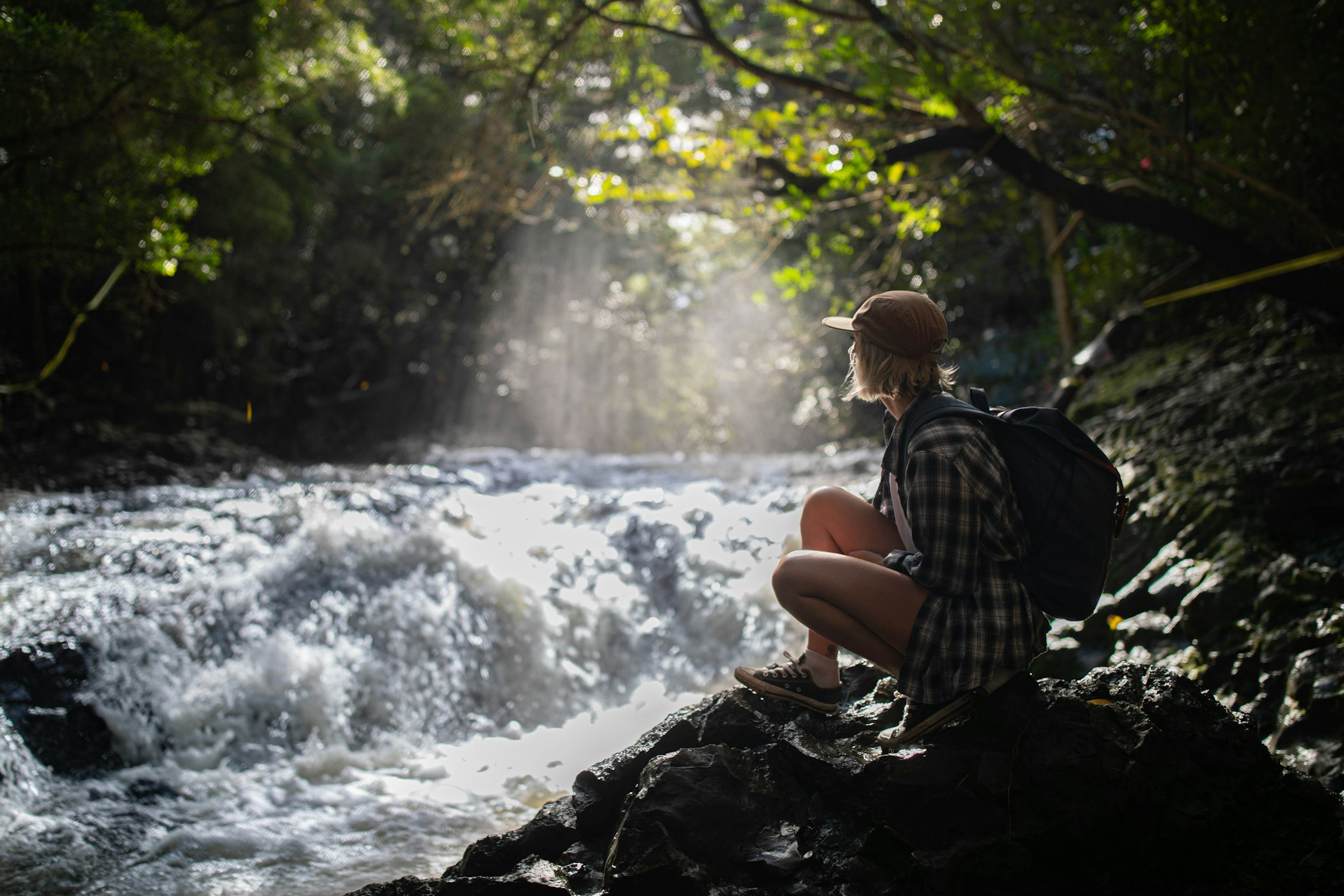
Annapurna Vs Everest Base Camp Trek
Everest base camp and Annapurna base camp both treks are adventurous treks. Every traveler wishes to stand in front of Everest and Annapurna . The wish becomes a dream and leads you toward a destination of EBC and ABC . Both EBC and ABC are wonderful places that you must visit in your lifetime. We hope your visit will repeat a number of times after seeing its attraction and beauty. There are some differences regarding distance, duration, budget, permit, and altitude between the Everest Base Camp (EBC) and Annapurna Base Camp (ABC) trek. An attempt to include details of both the ABC and EBC trek is made in this article with the aim of giving information on both the EBC and ABC trek at once.
Which is tougher Everest Base Camp Trek or Annapurna Base Camp Trek?
Annapurna Base Camp (ABC) and Everest Base Camp (EBC) both are mountain rides on foot. Climbing up and up till you reach the base of the Himalayas is not an easy task. EBC is at the highest altitude than ABC, it takes a long time to reach EBC than ABC. Thus EBC is tougher than ABC . To know which one either EBC or ABC is tough, let’s see separately about the location, altitude, and difficulties of the EBC and ABC trek.
Everest Base Camp Trek Difficulty
THE EVEREST BASE CAMP TREK Location is Solukhumbu district, Province No.1- Nepal in Sagarmatha National Park .
EBC trek duration: Everest (8848m) is the third pole of the world. It is one of the mediums to be on the lap of Everest. EBC treks need minimum 15 days. These 15 days include the total time from arrival in Nepal to departure from Nepal. Day by day you will walk towards hills and downhills enjoying the beauty of the place fascinated by the gorgeous Himalayas, variety of plants and animals, ethnic cultural beauty of Sherpa, monuments, and many more.
EBC trek elevation: In the EBC trek, walking begins from Lukla (2860m) and leads up to Everest base camp (5364m). The altitude rise is very high i.e. 2504m from Lukla to Everest base camp.
EBC trek challenges: This elevation rising with each day trek leads to altitude sickness and tiredness, the food of cold region may not suits you, you may caught a cold and become sick. The rainy days doesn’t give proper visibility, thick fog will decrease the charm of surrounding. Due to lack of internet connection in some places, you will be out of contact from your families. Physical imbalance and atmospheric challenges may leads to an incomplete trek sometime.

Annapurna Base Camp Trek Difficulty
ANNAPURNA BASE CAMP Trek location is Kaski district, Province no. 4 (Gandaki Province) Nepal in the Annapurna conservation area.
Abc trek duration - Annapurna I (8091m) is the 10th highest mountain of the world. It is one of the mediums which guides you on the base of Annapurna massif. ABC trek requires minimum 10 days. If you desire to go Ghorepani Poon Hill trek and Ghandruk along with the Annapurna base camp then you need 14 days. These 14 days include days from arrival in Nepal to departure from Nepal. ABC trek route is not as difficult as EBC trek. Elevation rises day by day but doesn’t comprise more slanted uphills. The waterfall, amazing diversified flora, landscape with a variety of soil texture, Local Gurung culture and hospitality is great part beyond walking.
ABC trek elevation: In the ABC trek, walking begins from Nayapul (1070m) and leads up to Annapurna base camp (4,130m). The altitude difference from the beginning to the destination of the trek is 3060m.
ABC trek challenges: Since ABC lies in low altitude than EBC, there will be less chance of altitude sickness, The path is less steep so walking will be comparatively easier than EBC trek. Due to low elevation than the EBC trek, there will be less chance of suffering from cold and falling sick. Less problem in digestion and in taking food. Chances of an incomplete trek due to bad weather, and physical illness will be less.

When is the best time to visit Everest Base Camp (EBC)?
The best time to visit Everest base camp is spring and autumn season. Spring season – 15th February to 15th May and autumn season- from 15th September to 15th December is the best time to visit Everest because of pleasant weather, clear vision and less risk on path during these months. A cheerful environment, panoramic view of mountains, burble of rivers and stream, blooming rhododendrons energize you with joy and happiness. All hotels remain open, and lots of trekkers on the path will encourage you to complete your journey.
EBC trek in monsoon is not preferred because you could not enjoy your trek due to rainfall. Parasites called leeches spread more on the path and they may bite you. Due to rainfall Path becomes sloppy, chances of falling down increase. You couldn’t see the view properly due to the thick fog and clouds on the mountain.
EBC trek in winter is very dangerous, it is unpredictable whether you can reach Everest base camp or not because of extremely low temperatures. Temperature fall up to -17° C to - 20°C. Most hotels remain closed and proper food will not be available.
What is the best time to visit ABC?
The best time to visit Annapurna base camp is the spring and autumn seasons. It is analyzed by trekkers that in case of low snowfall, Trek is possible in all months of the year even though spring (15th February to 15th May) and autumn (15th September to 15th December) are considered as the best. Because in spring and autumn, the weather remains perfect for trekking, days remain best with pleasant weather. You can take full entertainment with your journey. The view of mountain ranges will be clear, the path will not be wet and dangerous. All teahouses remain open, good food will be available.
ABC trek in monsoon is possible but high risk of the wet path, and rain coverage makes your trek joyless and difficult. You could not enjoy the environment during the trek due to rainfall or even snowfall. The view remains unclear and the mountain will hide inside clouds and fog.
ABC trek in winter is not selective because of low temperatures and snowy paths. It would be very difficult to reach your destination because of cold and snow cover everywhere. Most of the Tea houses remain closed and would be difficult to get a comfortable place to take rest as well.
How much does it Cost for The Everest base camp trek?
EBC trek cost is 1000$ - 3500$ per person. The cost varies depending on the days you want to spend during your trek and the tea house where you stay during the trekking and the rest of the days of your visit.
The EBC trek permit you should pay is the Sagarmatha National Park permit. The cost is Nrs 3000 for foreigners and Nrs 1500 for SAARC nationality. You should also pay 2000 NRS for Pasang Lhambu Muncipility.

How much does it cost for the Annapurna base camp trek?
ABC trek cost is 750$-1850$. Cost depends on the days you spend during the trek and the places you visit. Also on the tea house where you will stay during the trek and your visit.
ABC trek permit you should pay is ACAP permit 28$ and TIMS permit 20$ per person.
(ACAP – Annapurna conservation area permit and TIMS – Trekker’s information management system)
Which is better Annapurna or Everest Base Camp Trek?
To remove confusion on choosing the ABC or EBC trek, we have a tabular representation to compare the ABC and EBC trek.
From the table, it is clear that If you want to go on the highest altitude and spend more time on the Himalayan region then the EBC trek is better for you. If you haven't done any mountainous trek then you should go for ABC trek first. From the view of expenses, the ABC trek is cheaper than the EBC trek. So you can choose ABC trek in case you want to do the cheaper and more adventurous trek. If you are searching more challenging and remarkable trek, then EBC is the best choice cause the EBC trek only can take you on the base of the highest altitude of the world.
How to reach Annapurna and Everest base camp?
The table below gives full information about day-wise activity for Annapurna and Everest base camp trek. It takes 13 days for ABC trek and 15 days for the EBC trek. You should walk 3-7 hours regarding your destination per day in both trek ABC and EBC.
Itinerary for Annapurna vs. Everest Base Camp Trek
Accommodations .
Air pressure reduces with increasing altitude and the amount of oxygen in the air becomes low which causes altitude sickness. To get recovered from altitude sickness your body demands rest for which proper accommodation is essential.
Everest base camp has better accommodations than Annapurna Base Camp. Annapurna base camp has only 4 hotels with seven rooms and GorkShep (Everest base camp) has five hotels with more than 40 rooms in each.
Annapurna trekking site has limited hotels with 7 rooms and four beds each room after Chommrong due to the Annapurna conservation area but the Everest trekking site has many hotels with more than 20 rooms in each. Hotels in Labuche has a capacity of 60-70 person and Gorchep have 100 in each hotel.
Internet and charging facilities are available in hotels/ tea houses of both ABC and EBC trek but you have to pay an extra charge for it. If you are planning a solo or Self trek without Guide to ABC then take the Annapune base camp Trek route hotel number in Advance so it will be easier to book a room in the High season.
Annapurna vs. Everest Base Camp elevation
Altitude variation occurs from step to step in the ABC and EBC trek. The table below shows the altitude of major places of both EBC and ABC trek in comparative form.
Scenic beauty
Everest and Annapurna both are ranges (Mahalangur and Annapurna) of Hindu Kush Himalaya. Both places are fascinated with panoramic view of numerous mountain ranges, rhododendron with alpine vegetation, faunal diversity and ethnic culture of Sherpas, Tibetan and Gurung society. Somewhere you will see rocky mountain, somewhere snow capped mountains and somewhere you will see cold desert. The breathless beauty of EBC and ABC is unexplainable.
Nuptse (7861m), Lotshe (8561m), AmaDablam (6812m), Thamserku (6623m), Mt.Pumori (7161m), Lobuche (6119m), Tabuche (6542m) etc. are seen in Everest base camp trek whereas Annapurna I (8,091m), Mt.Manaslu (8163m), Mt Dhaulagiri (8167m), Annapurna II (7937m), Annapurna III (7555m), and Annapurna IV (7525m), Ghangapurna (7455m), Annapurna south (7219m), Macchapuchre (6993m), Himchuli (6441m) Mardi Himal (5587m), and many more are seen from Annapurna region.
From where do ABC and EBC trek Start?
Everest Base Camp Trek: The EBC trek typically starts with a flight from Kathmandu to Lukla , a small town in the Khumbu region of Nepal. Lukla has a small airport. From Lukla, trekkers usually hike to Phakding and then on to Namche Bazaar, a bustling market town and the gateway to the Everest region.
Annapurna Base Camp Trek: The ABC trek usually starts from the city of Pokhara, which is about 200 kilometers west of Kathmandu. From Pokhara, trekkers drive to Nayapul and then hike to Tikhedhunga. The trek then passes through charming villages, lush forests, and terraced farmland before reaching the base camp of Annapurna. While there is no direct flight from Pokhara to Lukla, many tour operators offer a combined ABC and EBC trek, which involves flying from Pokhara to Kathmandu and then to Lukla.
Video of Annapurna and Everest Base Camp Trek
Here we have a short Annapurna Base Camp Trek Video.
https://www.youtube.com/watch?v=n0p5qvhiqic
Here we have a short Everest Base Camp Trek Video.
https://www.youtube.com/watch?v=itbiuM_T3ig
Basic requirements for ABC and EBC trek
ABC and EBC trek constitute cold climatic zones and snowy pathways. Thus you should be careful on clothing and other trekking gear. Here is a list of trekking requirements you should bring on both EBC and ABC treks.
- Warm jacket – down jacket,
- Water and windproof jacket (alternatively bring a poncho or umbrella)
- Long-sleeved synthetic fleece (windproof material, if possible)
- Thermal underwear
- Hat, a pair of gloves and a scarf
- Comfortable hiking trousers (loose fitting)
- Shorts and trousers, or a skirt
- 2 pairs of warm wool-blend socks
- 2 pairs of running socks or liner socks
- Proper hiking boots
- Running shoes and flip-flops
- 2-3 T-shirts
- Water bottle
- Hiking/trekking boots
Trekking Gear
- Polarizing sun-glass to avoid potential snow blindness
- Backpack and backpack cover to protect against rain and dust
- Trekking map
- Head torch or small torch, plus spare batteries
- Sleeping bag and silk liner water bottle
Miscellaneous
- Toiletries (shampoo & Condition)
- A small lightweight and quick daring towel
- Bar & soap
- First aid Kid
- Water filter or water purification tablets.
- Some Diamox pills against potential altitude sickness
- Toilet paper
A word from Mission Summit Treks and Expedition
Everest base camp and Annapurna base camp trek both are wonderful adventurous trekking. We suggest choosing ABC for beginners because of the easy path and low altitude than EBC. After a successful attempt at the ABC trek never miss the EBC trek because your trekking aspects would not be meaningful until you reach Everest Base Camp – the highest altitude of the trekking trial.
Mission summit treks stand by your side to make your trekking aim successful. Join us, we will change your trekking aim into reality.
RECENT NEWS
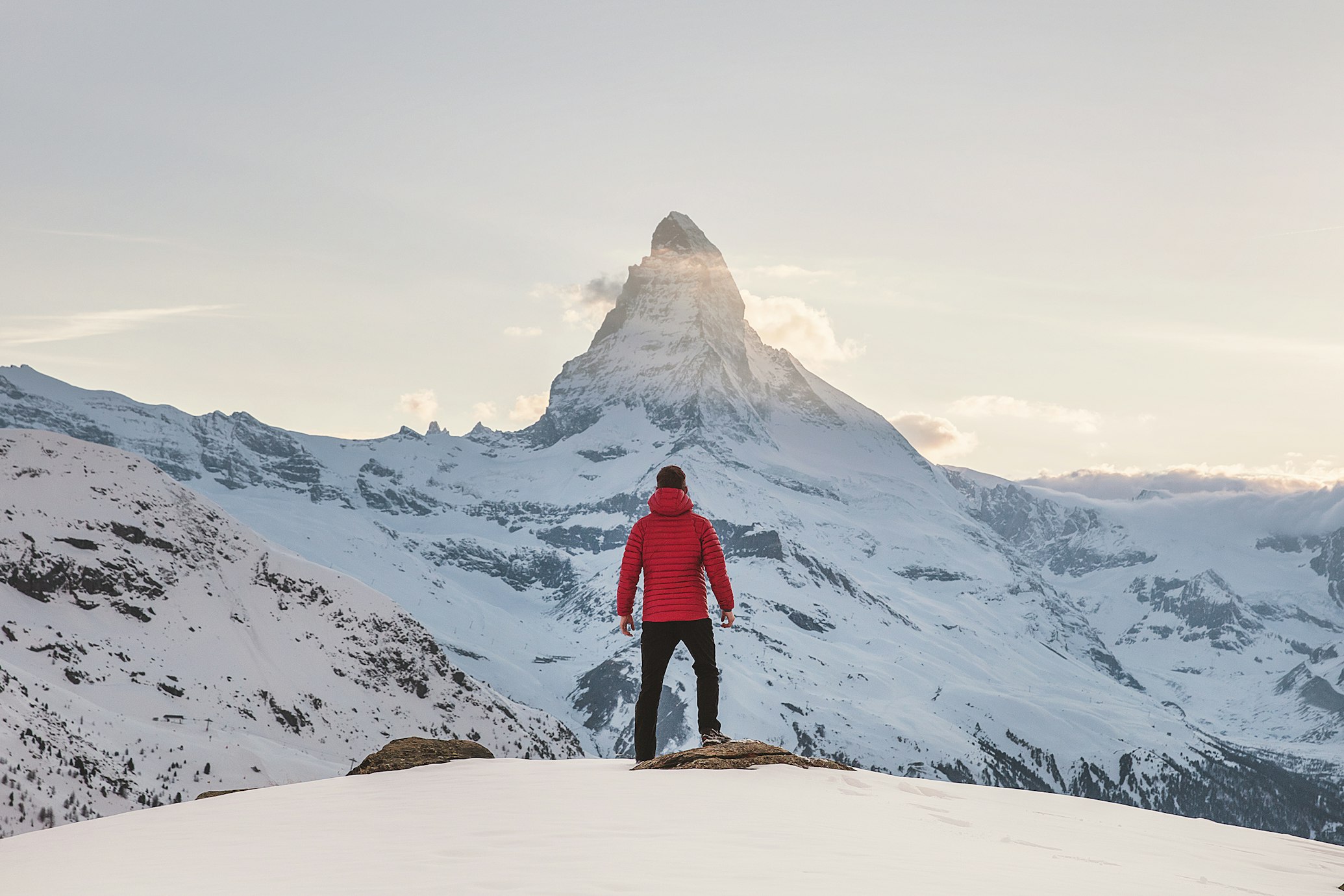
50 Resources And Tools To Turbocharge Amazon Product Scraper
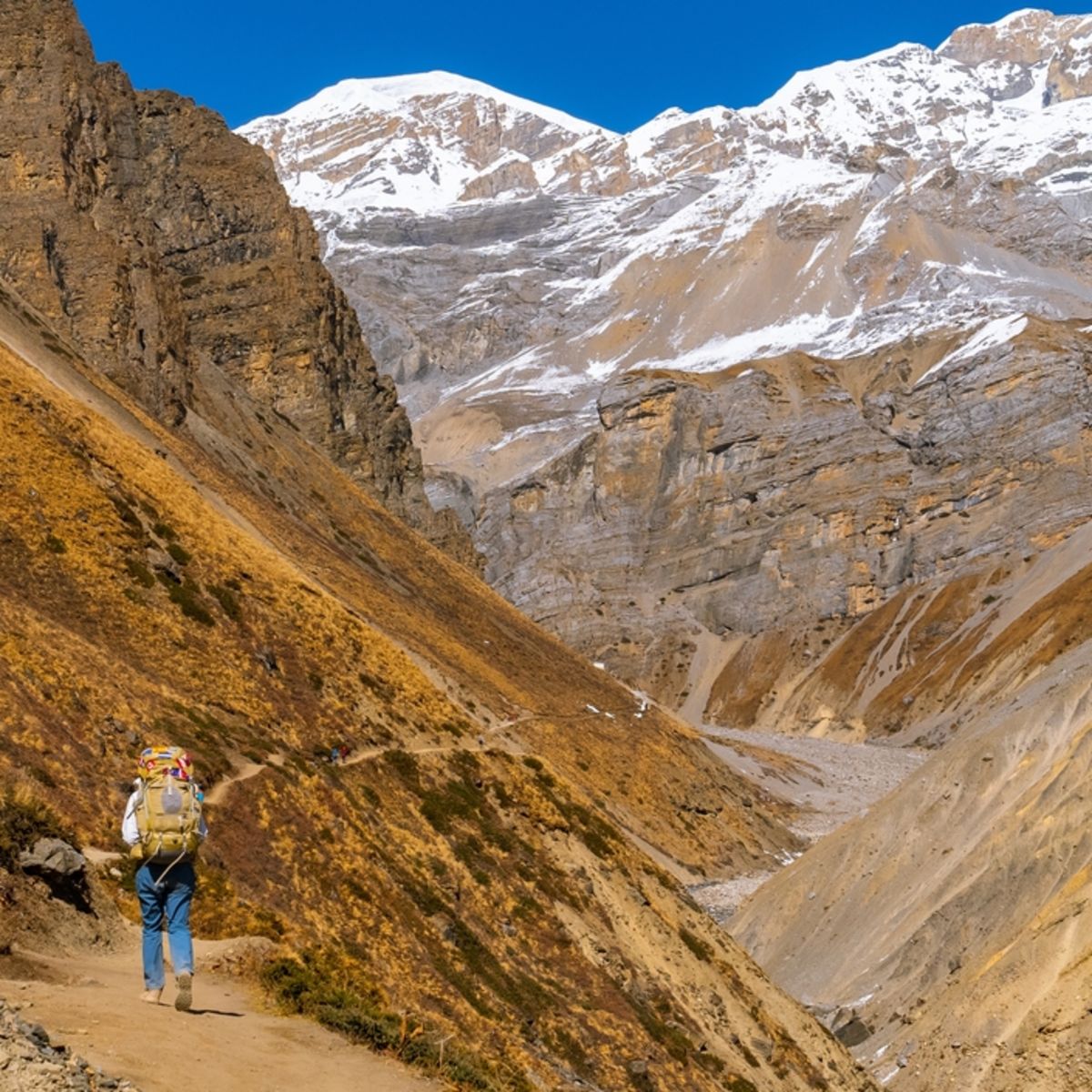
Annapurna Circuit vs Everest Base Camp
So you want to go trekking in Nepal. Wonderful! We want to go with you! But do you hike the Annapurna Circuit or to Everest Base Camp? Helping you answer that question is what this post is all about. We talk trek length, difficulty, weather, cost and more!
A note about route variations
Both the Annapurna Circuit and Everest Base Camp treks have variable routes and itineraries you can follow.
This is because the Everest Base Camp trek route has more than one path leading there and back. And you can also add on some exciting detours.
On the Annapurna Circuit, you can now drive some of the initial trek route, meaning you can decide to skip some or all of the early section if you want. And you can also end the trek in different places.
So as you can see ... variations for both treks are possible!
By the way, if you don't feel like reading any further, but do want to know the differences between the Annapurna Circuit and the Everest Base Camp trek, here's a video to watch instead!
There would be a youtube video here.
Trip duration
At Follow Alice we offer three Everest Base Camp trek routes:
We also offer two Annapurna Circuit trek routes:
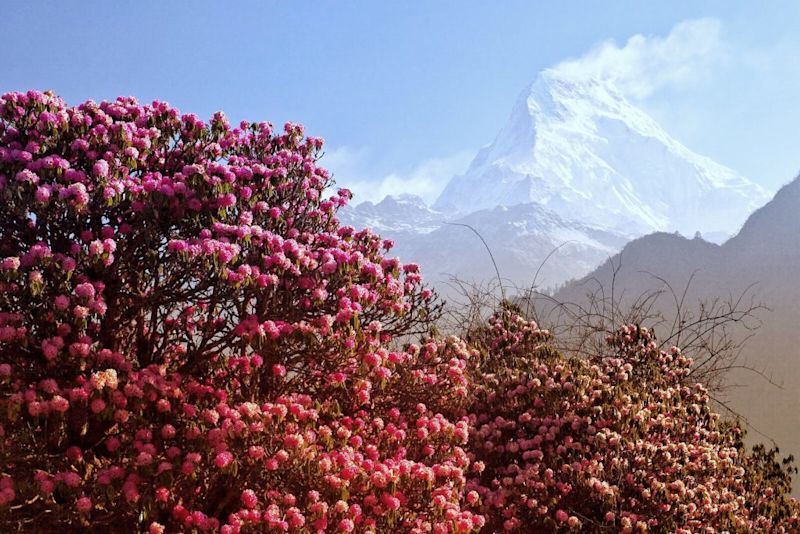
Rhododendrons bloom in the Himalayas in spring
Which one is right for me?
The attractions and pluses of each trek route are many, and it’s mostly your personal preferences which can help you decide if the Annapurna Circuit or Everest Base Camp (EBC) trek is the better trip for you right now.
The topics we discuss to help you decide include:
- How hard you want to push yourself physically
- What sort of sights you most want to see
- How much of Nepal you wish to explore
- When you want to travel
- How much you can afford to spend on the trip
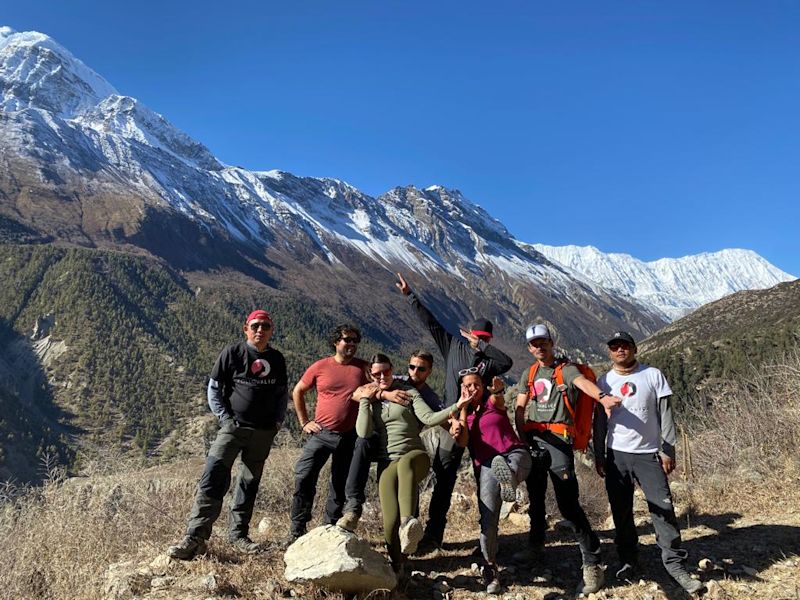
Both the Annapurna Circuit and Everest Base Camp treks take you deep into the Himalayas
Accessibility
The Annapurna Circuit and the Everest Base Camp trek are two very different treks.
Yes, they both take place in the Himalayas in Nepal, and they both involve lots of trekking at high altitude. But they’re incredibly different in many other respects, including the ease with which you can get to them and back again.
The starting point of the Annapurna Circuit trek takes longer to reach than that of the Everest Base Camp trek.
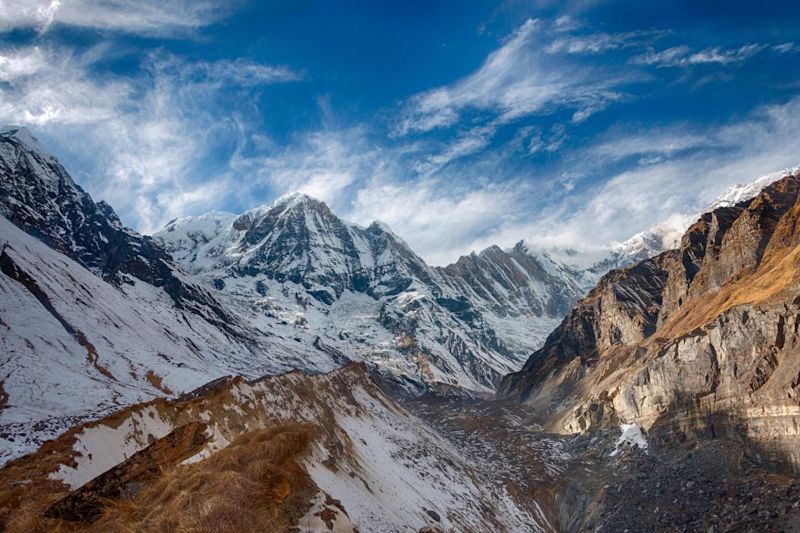
The Annapurna mountains are part of the famous Himalayan range
Getting to the start of the Everest Base Camp trek
For both treks you need to fly into Kathmandu, as already mentioned, as the capital has the country’s only international airport.
Once in Kathmandu, however, those headed to the EBC trek need only take a short 25-minute flight east to the town of Lukla, which is the trek’s starting point.

We fly in and out of Lukla Airport on our way to the Everest Base Camp trek
You could feasibly start the EBC trek the same day you arrive in Nepal! We don’t actually do this, as such rush is unnecessary. Instead, we spend a night in Kathmandu, resting up. Also, a night’s stopover allows some important wiggle room should anyone’s flight into Nepal be delayed.
Important note
As of 2022, you cannot fly directly to Lukla from Kathmandu as airport construction. This is because Kathmandu's airport is undergoing major renovations, and some local flights are consequently not running. This means you need to travel south to Ramechhap and fly to Lukla from there. This adds an extra day of travelling on both sides of the EBC trek.
Lukla is a small town 2,060 m (6,759 ft) above sea level. Its airport has a notoriously short runway. Poor weather conditions also can and do delay flights more than is the norm. For this reason our first day of trekking along the Everest Base Camp route is only 5.5 hours, so a delay into Lukla Airport of a few hours doesn’t derail our itinerary.
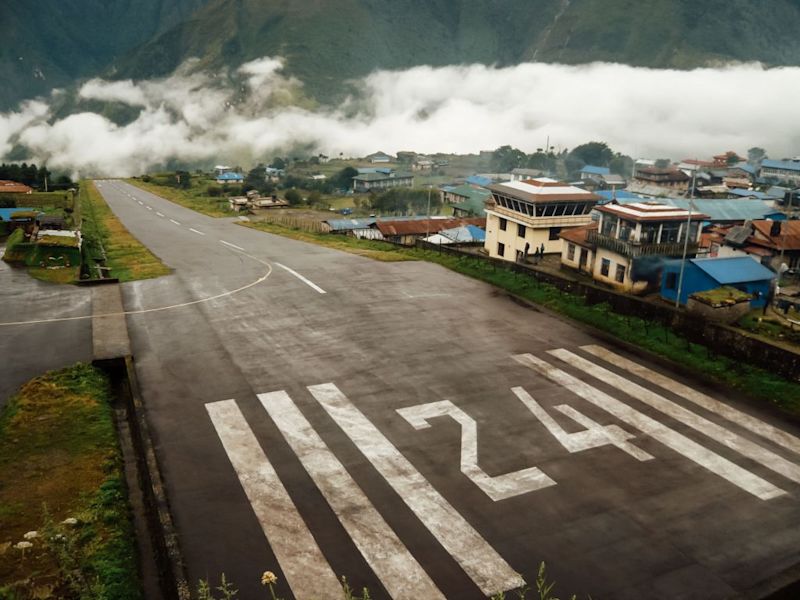
Everyone coming to do the Everest Base Camp trek flies into Lukla Airport
Getting to the Annapurna Circuit
The accessibility of the Annapurna Circuit is a very different matter. After a night in Kathmandu, we have two days of driving in front of us to reach the trek’s starting point. We’ll be driven in a private, air-conditioned vehicle, so it’s nice to know that we’ll be getting there comfortably.
The reason we drive is that you cannot fly to the start of the Annapurna Circuit, as with the EBC trek. While you could fly to Pokhara, a city actually known as the gateway to the Annapurna Circuit, you would still then need to hire transport to drive you a long way to the start of the trail.
With Follow Alice you begin trekking the Annapurna Circuit in Pisang, a small mountain village with incredible views!
Follow Alice trekkers are driven all the way to Pisang before they start trekking.
You don't need to travel this far to start trekking the classic Annapurna Circuit route, but because there are now roads connecting many of the villages lower down on the Annapurna Circuit, we prefer to skip this section. We're not super fond of walking on jeep track and sharing the way with vehicles. The village of Pisang is where the road ends and from there everyone must proceed on foot. So this is where Follow Alice likes to start the trek.
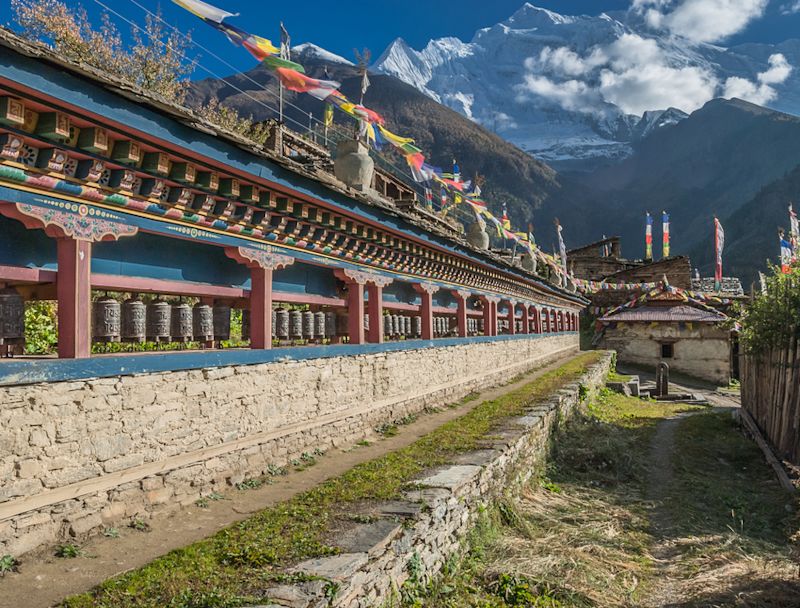
The famous prayer wheel wall in Upper Pisang
Pisang is divided into Lower and Upper Pisang. Lower Pisang is on the south side of the Marsyangdi River, and you must cross a footbridge and climb up a little way to reach Upper Pisang, which is where we overnight before starting to trek the following day.
Getting back to Kathmandu
For Follow Alice trekkers (and many other trekkers), the Annapurna Circuit ends in the town of Ranipauwa in the Mustang District. From here you need to drive south to the airport town of Jomsom. In Jomsom, you catch a small airplane through the staggeringly enormous Kali Gandaki Gorge to the lakeside city of Pokhara.
It's only in Pokhara that you can catch a flight back to Kathmandu.
And so the return journey at the end of the Annapurna Circuit trek involves a day of driving and then two short flights. The flights are on separate days, so there's a stopover night in Pokhara. But trust us, you'll be glad for the chance to explore this beautiful and adventure-filled destination!
Communications
Both the Everest Base Camp trek and Annapurna Circuit route have pretty good mobile phone reception and 3G connectivity. Naturally mobile reception can be spotty in certain of the more remote places. But one of the boons of trekking with a local guide – as we do – is that they’re able to advise you on the best spots for connectivity.
There are Ncell towers throughout the EBC route that even provide connectivity to those climbing Mt Everest. Many people choose to buy a SIM card in Nepal as the cost of the card and data is so cheap. If you decide to do this, we then recommend going with an Ncell card. Along the Annapurna Circuit you should be fine with an Ncell or Nepal Telecom SIM.
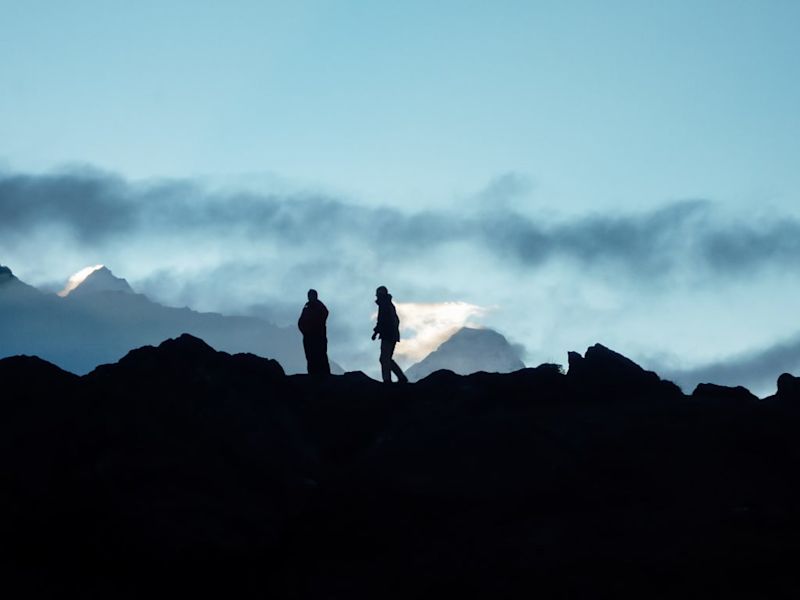
You don't need any special skill to trek the Everest Base Camp or Annapurna routes, but you do need decent fitness
Trek difficulty
Both the Annapurna Circuit and the EBC trek are difficult, but still totally doable if you have reasonable levels of fitness and perseverance. We chat in detail in Is the Annapurna Circuit hard? and How hard is Everest Base Camp? about the challenges of each trek. Below, however, we discuss the relative difficulty of each.
Number of trekking days
Let's talk the number of days you'll actually be walking on each trek ...
Everest Base Camp
If you opt for the Everest Base Camp trek with a helicopter return you're on the trail for seven days . This includes six days of trekking plus one acclimatisation day in the middle (although you could do an exciting roundtrip hike on this day if you choose). Note that the day you catch the helicopter you also do a taxing morning hike up Kala Patthar for an unobstructed view of Mt Everest. A great moment.
For the Everest Base Camp and Gokyo Lakes trek you're on the trail for 13 days . This involves 12 days of trekking, plus one acclimatisation day in the middle (on which you could opt to do a great day hike). So if you do the hike, you have 13 consecutive days of walking.
If you tackle the Everest Base Camp and Three Passes trek , you're on the trail for 16 days . Three of these days could be acclimatisation and rest days if you want, although each also has an epic roundtrip hike that you could top to do. On Day 14, for instance, you can rest, or climb up Gokyo Peak for an incredible panoramic view of the Himalayas!
Annapurna Circuit
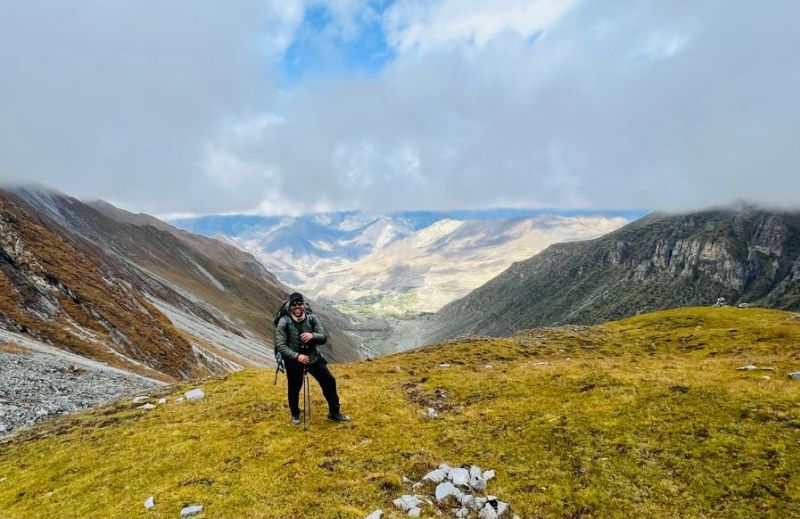
Our client Hala Macknight on the long descent from Thorung La to Ranipauwa
With the Annapurna Circuit , you only spend six days on the trek route. Two are acclimatisation days, but there are beautiful roundtrip hikes you can do on those days that allow you to explore more of the area. So that's six days of hiking.
If you opt for the Nar–Phu and Annapurna Circuit trek , you're on the trail for 11 days . One of these days could be a rest day in the village of Phu, or you can do a five-hour roundtrip hike to Himlung Himal Base Camp that day.
Summary: There are long and short itineraries for both EBC and AC
Depending on the itinerary you choose, you can trek for seven, 13 or 16 days in the Everest region. For the Annapurna Circuit, you can trek for just six days, or opt to be on the trail for 11 days.
Distance trekked
Let's now discuss the distances you hike on each trek ...
On the Everest Base Camp trek with a helicopter return , we follow the classic route to base camp. This is the most direct route and totals 53 km (33 miles) .
However, when you include the optional day hike on your acclimatisation day, as well as the return hike from base camp to Gorakshep, where you overnight, and the roundtrip hike to Kala Patthar the morning before your helicopter flight, you actually hike roughly 65 km (40 miles) on the EBC trek with a helicopter return.
If you choose to omit the acclimatisation day hike, you must cover 59 km (37 km) on the trek.
For the EBC and Gokyo Lakes trek , you cover 112 km (70 miles) in total. This doesn't cover the two optional day hikes (which we totally recommend that you do). With those included, you cover 121 km (75 miles).
We love this route because you see some different scenery on the return trip because we do a loop instead of heading back the same way we came in. You also see a remoter and quieter part of the region.
For the EBC and Three Passes trek , you cover a whopping 124 km (77 miles) , not counting the optional roundtrip day hikes on the three rest and acclimatisation days.
The Annapurna Circuit is a large loop that takes you through the mountains of the Annapurna Massif. It ranges from 160 to 230 km (99 to 143 miles). The longer route is the path that was popularised in the 1970s. Such a trek takes over a fortnight to complete and nowadays many opt to trek just the middle portion of it.
We at Follow Alice have also organised an abbreviated version of the original Annapurna Circuit trek which takes in just the best-preserved, highest, most remote and prettiest portion of the route. This route is 50 km (31 miles) , not counting the optional day hikes on our acclimatisation days.
Our specific route involves trekking around 50 km (31 miles), not counting the day hikes on our two acclimatisation days.
On the Nar–Phu and Annapurna Circuit trek you traverse 119 km (74 miles) , not counting the optional day hike from Phu. This is, as you can see, the far more arduous Annapurna Circuit option.
Summary: There are long and short distances for both EBC and AC
Depending on the trek route you choose, you can trek for about 65 km (44 miles) on the EBC trek or 121 km (75 miles) on the Gokyo Lakes variation or 124 km (77 miles) on the Three Passes variation.
For the Annapurna Circuit, you can trek for just 50 km (31 miles), or opt to tackle 119 km (74 miles) on the Nar–Phu variation.
The paths along the Annapurna trail are generally in good condition. In some places you actually trek along jeep track, as in recent years the Nepalese Government has been enhancing infrastructure in the area to make it more accessible.
Overall, however, the paths are a bit gentler on Annapurna than on the Everest Base Camp trek.
We always have a local guide to lead our trek groups, the number one reason being safety. Along the Annapurna Circuit your lead guide is often Sonam Sherpa, and along the Everest Base Camp trek it's usually Oangdi Gurung.
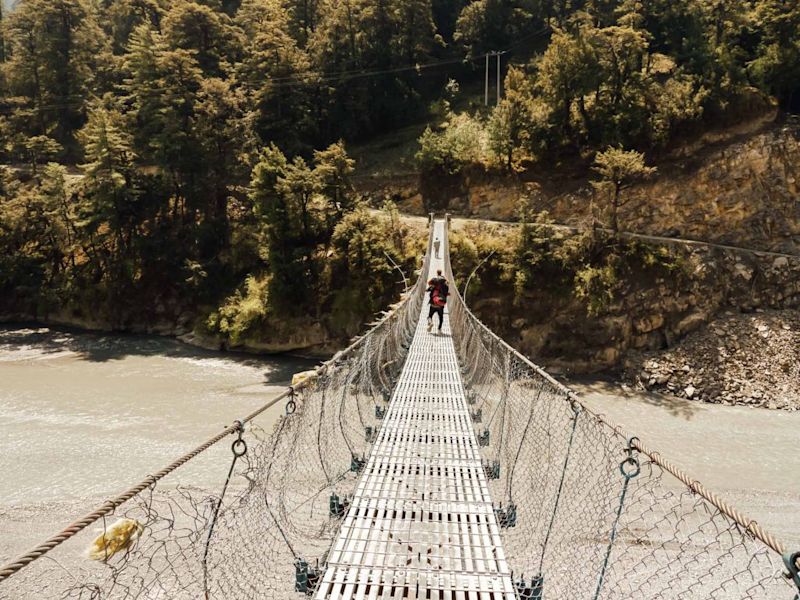
Both the Annapurna and Everest Base Camp trek trails include footbridges of various sizes and design
Elevation reached
Both the Everest Base Camp and Annapurna treks lead you very high into the mountains.
Everest Base Camp elevation
The Everest Base Camp trek starts at 2,860 m in Lukla. Everest Base Camp itself stands 5,364 m above sea level. But base camp isn’t actually the highest point on the trek; we also hike up Kala Patthar (‘Black Rock’), which is 5,643 m above sea level.
That means we ascend a total of 2,836 m during the trek, which is almost three vertical kilometres!
Annapurna Circuit elevation
The Annapurna Circuit requires us to trek to a slightly lower altitude than the Everest Base Camp trek, as shown in the graph below.
The Annapurna trek begins in Upper Pisang, which is a village 3,300 m (10,827 ft) above sea level. Over the next few days we climb to the circuit’s highest point – the mountain pass called Thorung La – of 5,416 m (17,769 ft) above sea level. That’s a climb of 2,216 m (7,270 ft).
After Thorung La, we drop down by 1,161 m (3,809 ft) to the village of Ranipauwa in just one day! So this day can be a bit taxing on the knees.
Summary: The EBC trek involves a bigger jump in elevation
The Everest Base Camp trek route requires you to climb just a little further in elevation than the Annapurna Circuit. If you enjoy figures, you might like to know that you achieve an elevation gain that's 227 m (745 ft) more on the EBC trek than that of the Annapurna Circuit.
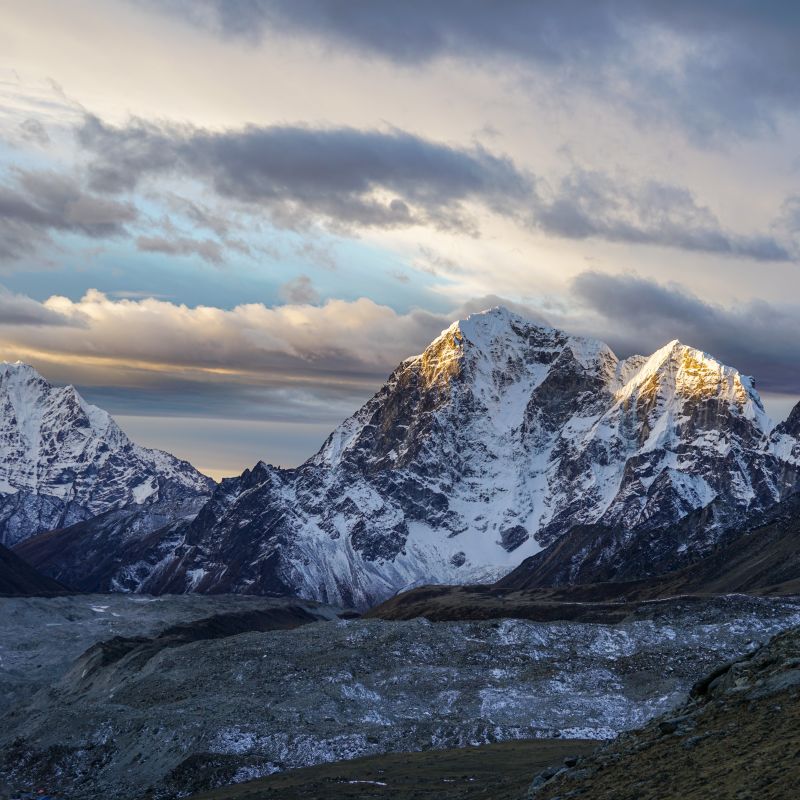
A glorious morning view from atop Kala Patthar
Time spent at altitude
By comparing the above two elevation graphs we can also see that the Everest Base Camp trek involves spending much more time above 5,000 m than does the Annapurna trek route. This means more time in rarified air, where exerting yourself is far more exhausting. The mental and bodily strain of the Everest Base Camp trek is therefore more than that of the Annapurna Circuit.
It’s important to note that the higher you climb, the more chances you have of developing altitude symptoms, such as headaches and dizziness. These aren’t too problematic, and can be medicated to a degree. The only problem is if you develop severe mountain sickness.
When you engage in high-altitude trekking, especially for the first time, it’s important to understand and accept that if you develop severe symptoms you’ll have to abort your trip and descend quickly to a lower altitude.
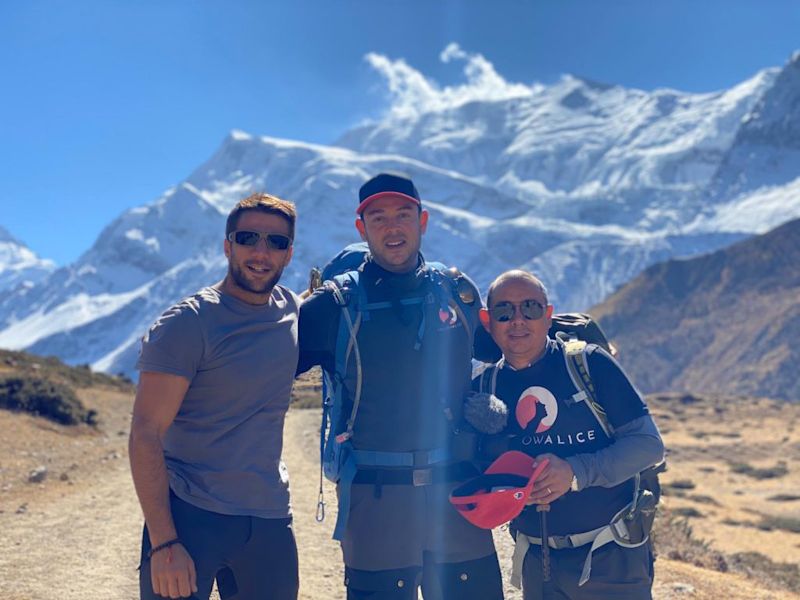
On the Annapurna Circuit you climb well above 5,000 m
The risk of severe altitude sickness
It's very rare for trekkers to develop severe altitude sickness, but it does occasionally happen.
The risk of a ruined trip due to severe altitude sickness is slightly higher on the Everest Base Camp trek than on the Annapurna Circuit, as with the former you climb higher and also spend more time at high altitude. Further, the Everest Base Camp trek allows only one acclimatisation day, while the Annapurna trek has two worked in.
If you’ve never trekked at altitude, the Annapurna Circuit is probably the smarter option.
Firstly, given that you don’t have to climb quite so high on the Annapurna Circuit, the toll on your body from the thin air will be a little less. This trek could serve as a testing ground for you ability to cope with altitude. (Note that altitude sickness strikes randomly, and even the fittest of people can suffer from it.)
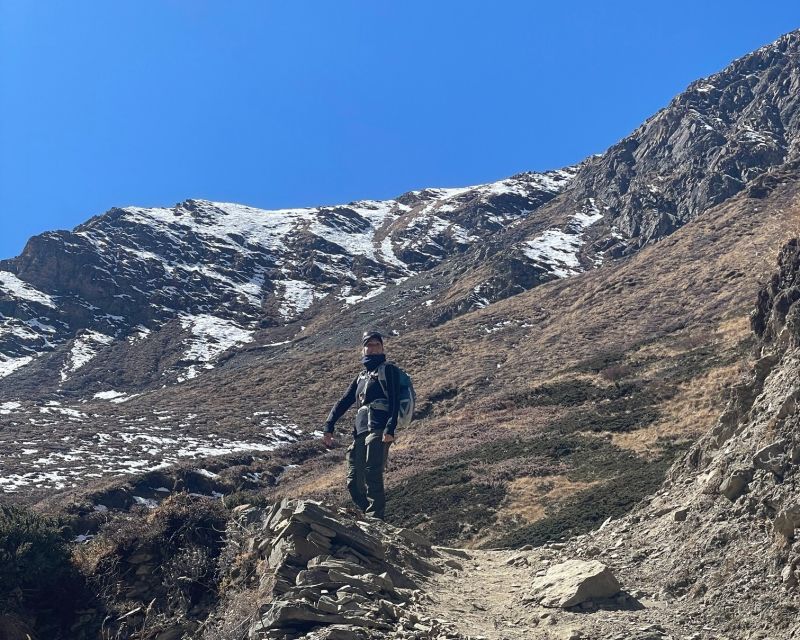
High up on the Annapurna Circuit
Secondly, the Annapurna Circuit is a shorter trek, so if you develop severe symptoms and have to turn back, you’d be missing out on fewer trekking days.
And thirdly, the Annapurna trip as organised by Follow Alice includes quite a few days of travel and sightseeing at low altitude, so even if it turns out that you can’t complete your trek owing to severe altitude sickness, there would still be a lot else to look forward to and enjoy with your travel companions.
Weather is a major deciding factor when it comes to planning any high-altitude trek. It simply has to be.
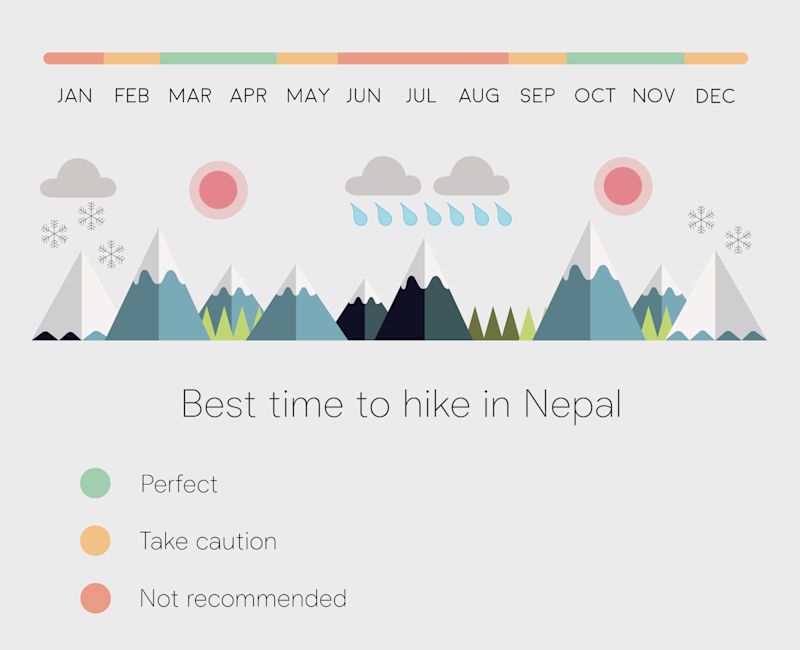
The weather in the Himalayas is both highly variable and at times extremely dangerous. The Everest Base Camp trek is in Nepal’s eastern Himalayas, and the Annapurna Circuit in the central Himalayas. While the weather patterns are similar in both regions, the timing and intensity of the various weather systems affecting them do differ a little.
Learn more about the Best time to hike the Annapurna Circuit and Best time for the Everest Base Camp trek .
Summer monsoon
In summer Nepal is affected by the Indian monsoon , the world’s most prominent monsoon system. The monsoon brings lots of rain, high temperatures and humidity to the Himalayas from June to September. In fact, Nepal receives 80% of its rainfall during summer.
The two main weather systems that we as trekkers have to consider are the summer and winter monsoons.
Very few embark on the Annapurna or Everest Base Camp treks in summer, as the rains make the trails slippery and dangerous, never mind the obvious unpleasantness of hiking in downpours. While parts of both treks take you into the rain shadow of the high Himalayas, the lower parts of the trek routes are very much affected by the monsoon rains and so make summer a bad time for trekking.
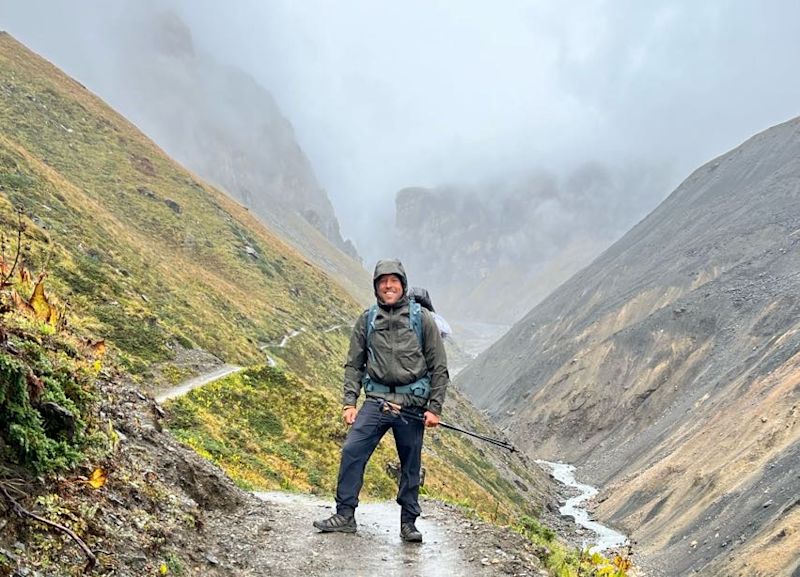
Our client Hala braving the elements on an autumn Annapurna Circuit trek
Winter monsoon
The winter monsoon brings cold temperatures, wind and snow from northern Asia to Nepal between December and February. Some intrepid souls choose to hike the Annapurna Circuit and Everest Base Camp trails in winter, but they are by far the minority.
The trails are certainly much quieter in winter, and the views often crisp, but the temperatures are icy, and night-time temperatures can drop to around –20° C. Also, the wind chill can drop the temperature by a further 10 degrees. Further, the chances of high passes being closed as a result of snowfall mean you can become stranded. Finally, certain passes (like the one to Gokyo Lakes) are routinely closed in winter, leaving only certain routes open to winter trekkers.
For most of us, travelling to Nepal is a major expense and time commitment, and so it’s important to choose a window of time that can best guarantee the sort of weather to make the trek both feasible and enjoyable.
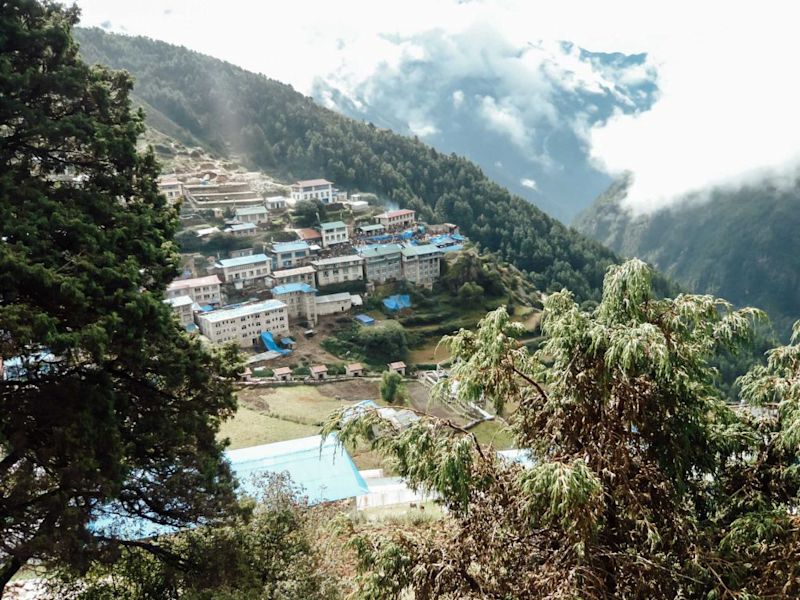
Both the AC and EBC trek routes have sections in a temperate zone
It’s arguably wiser to only take on Everest Base Camp or the Annapurna Circuit route in winter if you’re a very experienced trekker and know that you know you have all the necessary equipment and clothing.
Peak seasons
Peak seasons for both the Everest Base Camp and Annapurna treks are spring and autumn. Seasonal changes reach both regions at roughly the same time.
Everest Base Camp trek peak seasons
Peak seasons for the EBC trek are late March to mid May (spring) and late September to November (autumn).
Many enjoy trekking in spring because this is when Everest Base Camp is an active site, full of yellow and orange tents, mountaineering equipment and excited summitters. Given that the destination of this trek is Everest Base Camp, it’s incredibly special to arrive to the sight of such activity and endeavour.
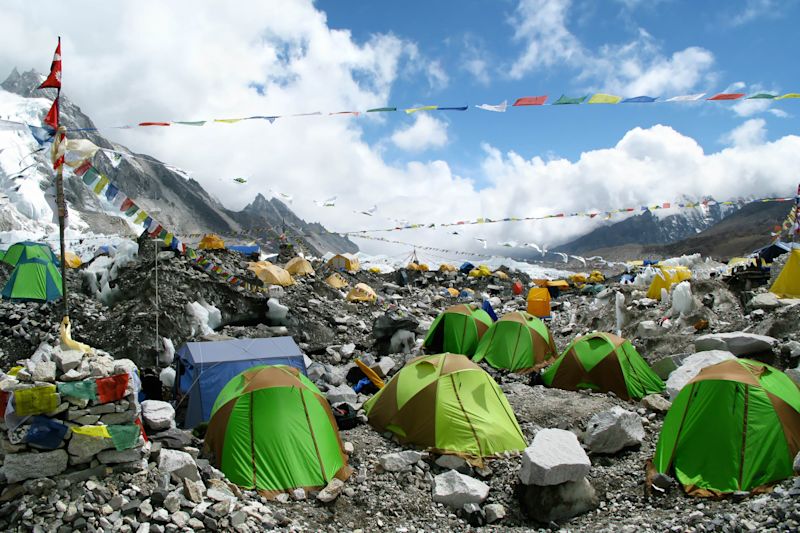
Everest Base Camp in the climbing season
At other times of the year, one’s experience of reaching Everest Base Camp is of approaching an empty expanse that you only know to be your destination because of a sign surrounded by wind-battered prayer flags.
The other peak season – autumn – is the more popular trekking time with many because of the temperate weather and clear views. Many of the flowers will, however, be gone by this time of the year.
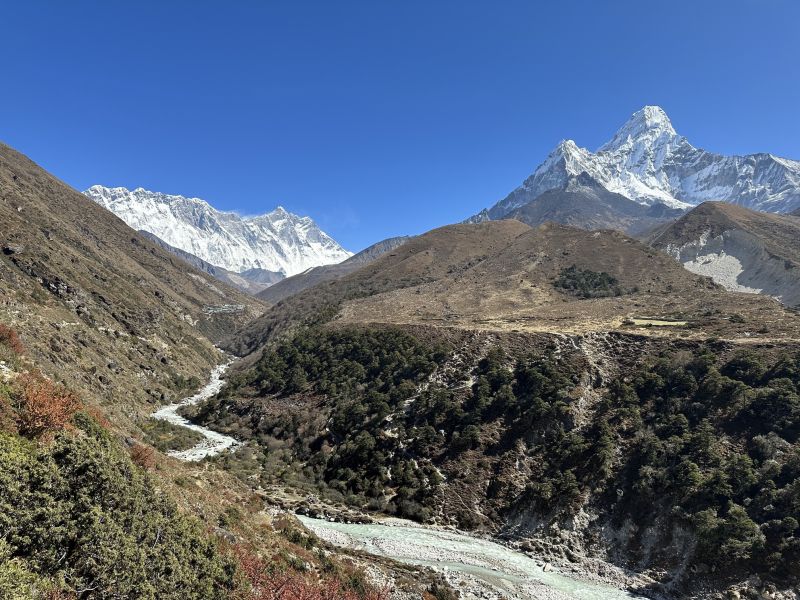
Our client Ross Anker took this pic along the EBC trek in autumn
Annapurna Circuit peak seasons
Peak seasons for the Annapurna Circuit are April and May (spring) and October and November (autumn).
Each peak season has different perks and drawbacks. Spring, for instance, offers beautiful flowers, but there can be a bit of a haze at times. Autumn, on the other hand, offers steadier, warmer weather and better visibility, but you don’t have the spring flowers and fresh greenery along the lower half of the trek route.
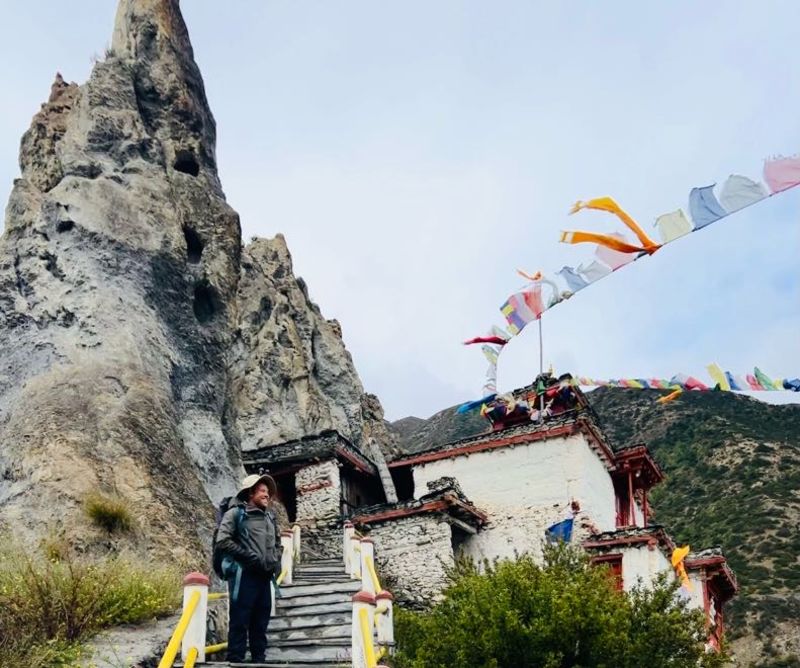
Our client took this snap along the Annapurna Circuit in autumn
Crowds
Both the Annapurna Circuit and EBC treks have grown in popularity in recent decades.
There are pros and cons to this, such as better services and crowded trails respectively. If you choose to go in a peak season, which many do for the better weather, you have to accept that you’ll be sharing the route with many other trekkers.
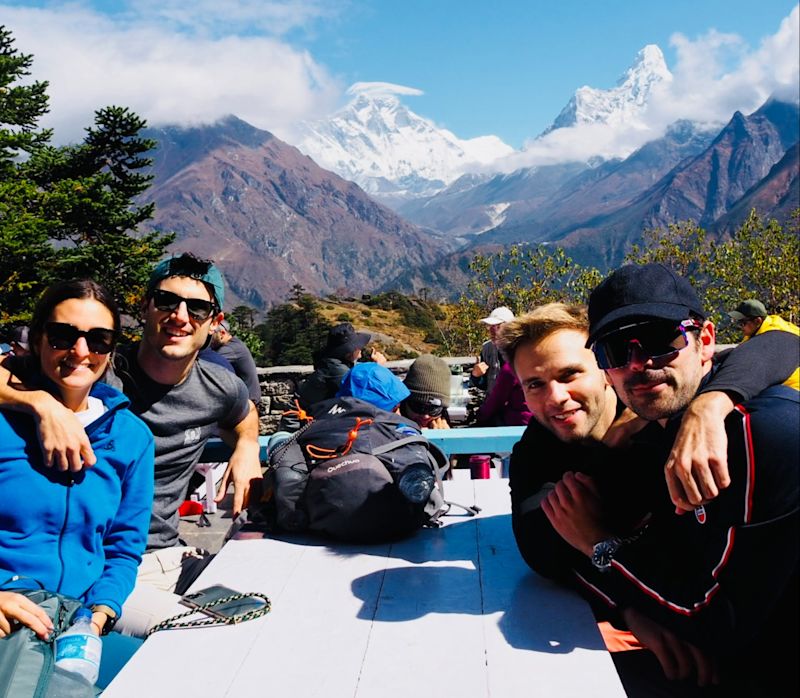
Lunch stop at a restaurant along the EBC trek
Everest Base Camp trekker numbers
According to Nepal Tourism, in 2016 over 45,000 foreigners visited Sagarmatha National Park.
Mt Everest, Everest Base Camp itself, and most of the EBC trek route lie within this park, and there are no roads, so we can take this number as a good indication of combined trekker and mountaineer numbers.
The bulk of EBC trekkers hike the route in one of the two peak seasons. A few hundred trekkers can join the route each day in peak season. Consequently lodges and teahouses along the route can and do fill up over peak seasons and sometimes there are overflow trekkers who have to pitch tents for the night. At Follow Alice we book our accommodation ahead of time to ensure we have enough beds for bodies.
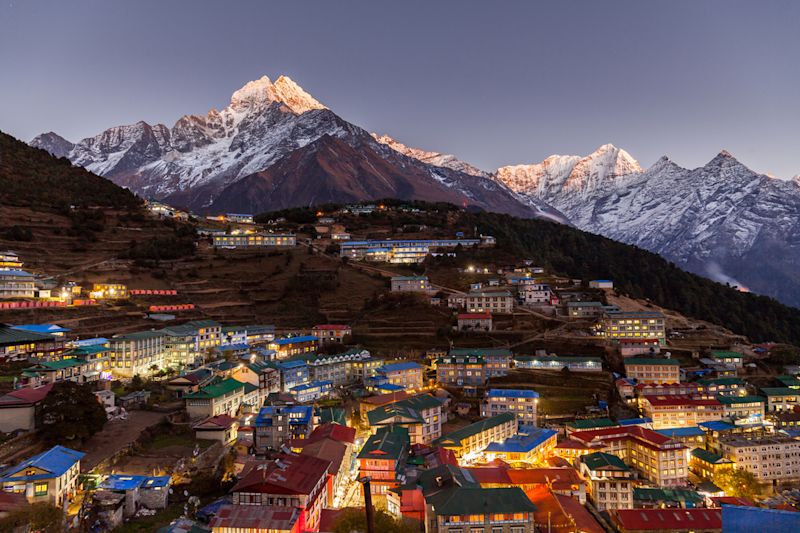
Namche Bazaar is a bustling town along the EBC trek
Annapurna Circuit trekker numbers
According to UNESCO, Annapurna receives about 60% of Nepal’s international trekking visitors , making it the more popular trekking area in terms of numbers.
However, there are no specific trekker numbers for the Annapurna Circuit, as there are other trekking routes in the Annapurna Massif such as the Annapurna Base Camp trek.
While we can’t put a finger on exact numbers, again we do know that lodges and teahouses along the Annapurna Circuit fill up during peak seasons, so we know that a few hundred trekkers can join the route each day in peak season.
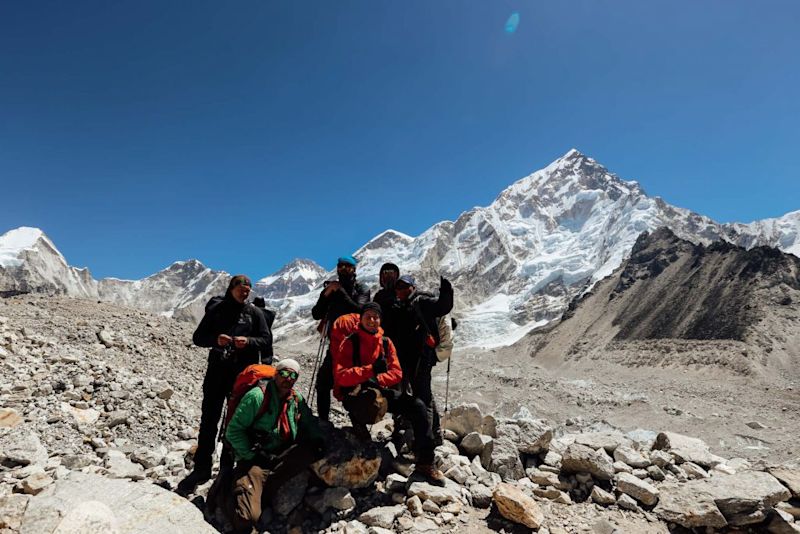
Trekkers on the Annapurna Circuit
As you can see, both EBC and Annapurna have similar peak trekking seasons, as the weather is much of a muchness along both trek routes at any given time of the year. If you choose to embark on one of the trips with Follow Alice – and we hope you do – then you can either check out our scheduled departures, or suggest a date of your own. We're very flexible with dates.
And yes, if you want to be He-Man or She-Ra, you could trek Annapurna and then trek EBC straight after!
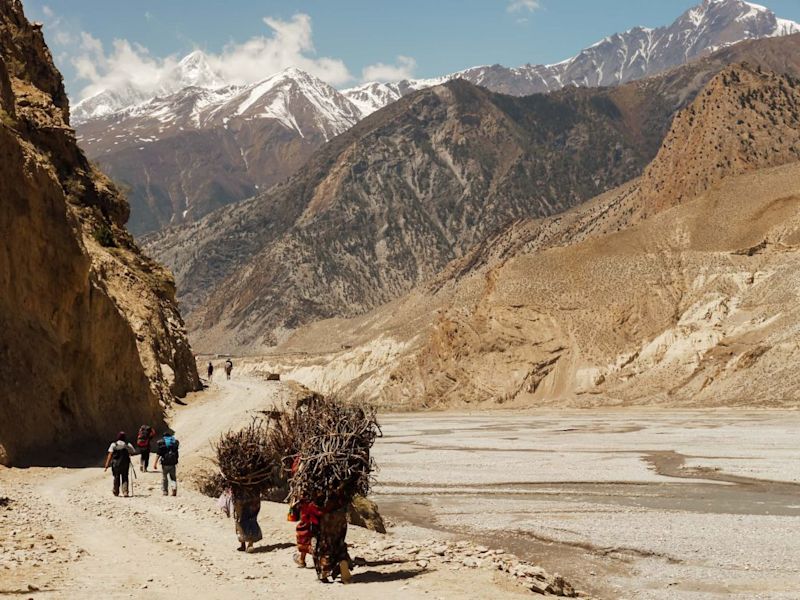
Some of the 'crowds' on the Annapurna Circuit are local people going about their daily business. It's a privilege to see how life is lived in such a different part of the world.
Every holiday requires you to crunch some numbers, including those important money numbers. That said, if you travel with Follow Alice, the maths becomes far simpler, because you only have two main outlays: your flights, and your Follow Alice fee.
If you have limited or no previous experience of trekking, then you may also need to invest in some equipment, which would be another important expense to consider.
International flights
The price of flights will obviously be the same, as you can only fly into Kathmandu, as previously discussed, because Nepal only has one international airport.
Follow Alice fee
There are many good reasons to travel with a tour operator when embarking on an adventure holiday like trekking to EBC or along the Annapurna Circuit. An obvious reason is safety, another that most of the admin and busy work is taken care of for you.
With Follow Alice you pay a once-off package fee that covers almost every single cost you might incur within Nepal.

Oangdi is one of our fabulous Nepal trek guides
The longer the trek, the more expensive it is, naturally. Also, a helicopter flight back from EBC adds substantially to the fee.
For instance, the Follow Alice Annapurna Circuit cost covers all transport within Nepal, all accommodation, nearly all meals, all park and other permits, and the tour guide and porter fees. The Everest Base Camp cost similarly covers all transport within Nepal, all accommodation, nearly all meals, all park and other permits, and the tour guide and porter fees.
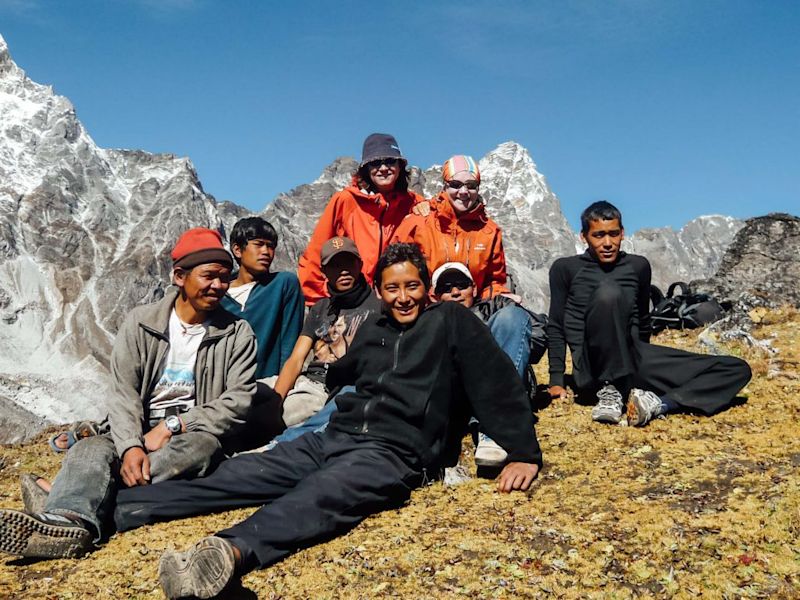
Trekkers taking a load off for a moment along the Everest Base Camp trek
For first-time trekkers, or those who haven’t before trekked at high altitude, there will be a necessary financial outlay in obtaining the gear needed for the cold and harsh climates hiked in the higher parts of both of the treks. Your Annapurna Circuit packing list and Everest Base Camp packing list are however the same, as both require sturdy, warm and waterproof equipment, clothes and accessories.

You need sturdy trekking equipment to hike in the Annapurna Mountains
Many trekkers hire some of the more expensive equipment upon arrival in Nepal. Kathmandu is awash with stores hiring (and selling) everything a trekker might need, like sub-zero sleeping bags and trekking poles.
Famous mountains
One of the primary reasons any of us head to Nepal is to witness the majesty of the Himalayan peaks.
Mountains of the Everest Base Camp trek
The EBC trek has the obvious – and understandable – allure of bringing you into close quarters with the King of the Mountains: Mount Everest. The mythos surrounding this giant makes this trek something of a pilgrimage.
As you likely know, Mt Everest was first summited by the Sherpa Tenzing Norgay and the Englishman Sir Edmund Hillary in 1953 . It’s an incredibly dangerous mountain to climb, and has claimed many intrepid lives.
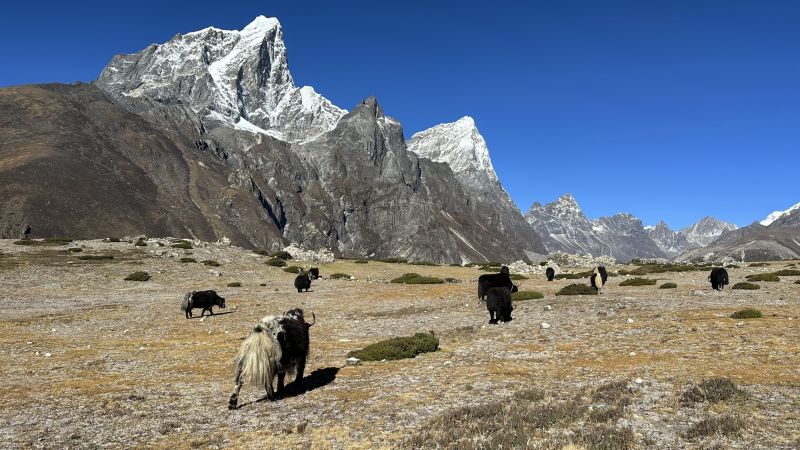
You trek among spectacular mountains throughout the EBC trek
Other noteworthy peaks of the Everest Base Camp trek
The Everest Base Camp trek isn’t only about Mt Everest though. You are also rewarded with views of other significant and beautiful mountains, which include:
- Ama Dablam (6,812 m). This distinctly shaped mountain is a favourite with many Everest Base Camp trekkers because it keeps you company to the right for a few days along the trail. It’s steep faces are dramatic and its sharply jutting peak make it unique and memorable among the rest of the peaks. The ridges on each side of the main peak are said to resemble the arms of a mother protecting her child.
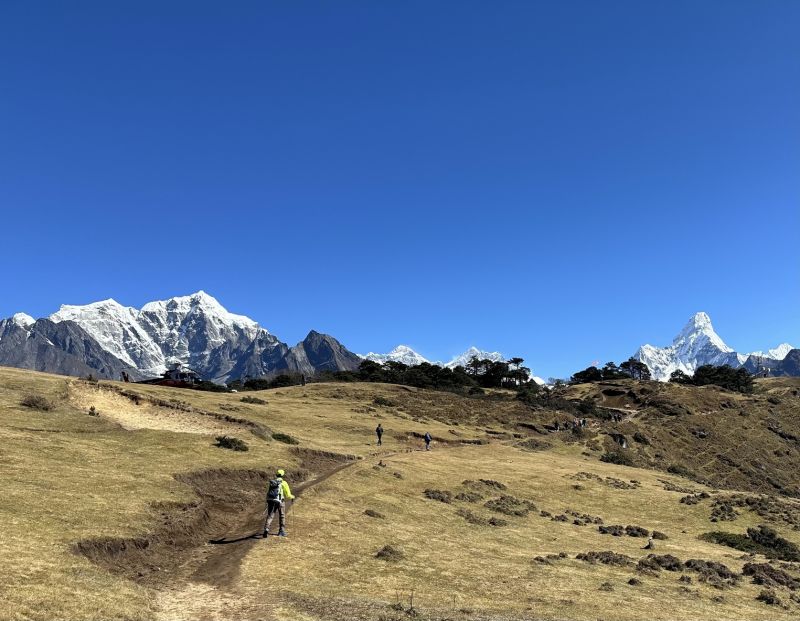
Ama Dablam (to the right) is a favourite mountain with many EBC trekkers
- Cholatse (6,440 m) and Taboche (6,542 m). These two peaks are connected by a long ridge. The Chola glacier slides down the east face of Cholatse, while Taboche towers above Dingboche, where we spend a night on the outgoing trek. When we head back from Everest Base Camp we trek straight towards these two peaks.
- Nuptse (7,861 m). This is a stately mountain when viewed from the south that lies just 2 km west of Everest. Though a thousand metres shorter, it more than holds its own next to its illustrious neighbour.
- Cho La Pass (5,420 m). This pass is special because we actually cross it! The views down to the villages of Dzongla and Thagna are fantastic, not to forget the views out to numerous other peaks.
- Gokyo Ri (5,357 m). This peak sits adjacent to the Ngozumpa glacier, which is Nepal’s largest. We trek to its namesake town of Gokyo on our return route.
There are, of course, many other peaks crowded into the Khumbu region where we do the EBC trek, but we can’t name them all here. It’s best you just do the trek to see them all for yourself!
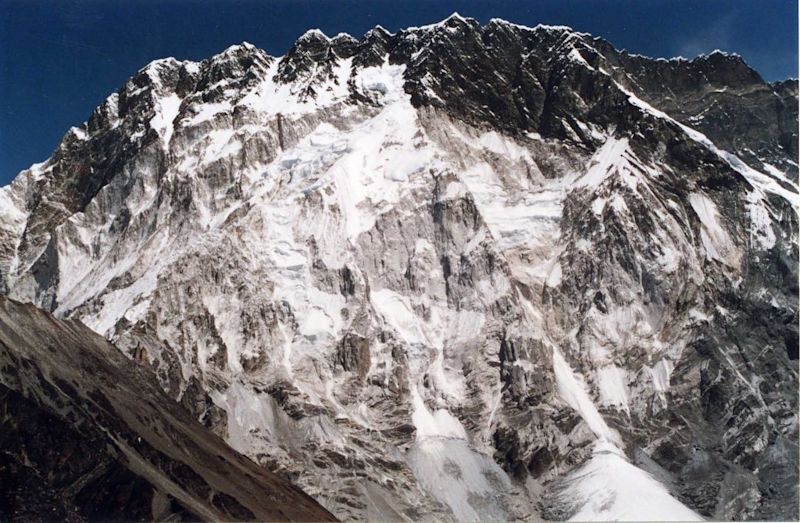
Nuptse, view from Chukhung River
Mountains of the Annapurna Circuit
The Annapurna Circuit also offers up-close-and-personal views of some extremely high and awesome mountains. Because the mountains here are part of the Annapurna Massif, they don’t always rise from such depths, but they still reach amazing heights.
Eight of the 14 tallest mountains in the world are in Nepal!
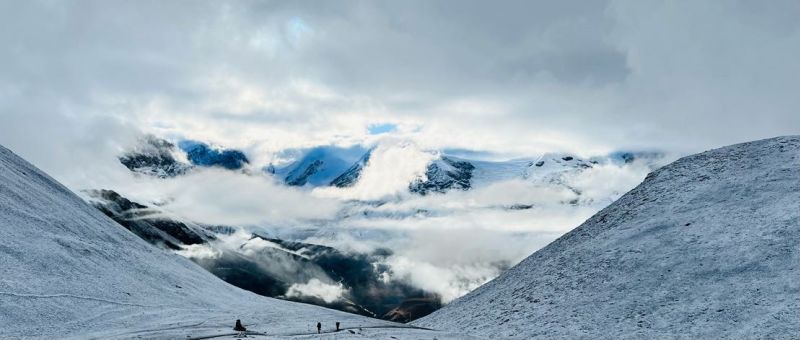
The view from atop Thorung La
Noteworthy peaks of the Annapurna Circuit
Annapurna I (8,091 m), the alpha male of the Annapurna region, is the world’s tenth highest mountain. Other noteworthy peaks on display during the Annapurna Circuit trek include:
- Annapurna II (7,937 m). This is the world’s 16th highest peak. It’s also the easternmost peak of the Annapurna range, so the first one we see when we join the circuit. It’s a stunner.
- Khangsar Kang (7,485 m). This peak is adjacent to the ice lake of Kicho Tal. We hike to the lake while acclimatising for a couple of days in the town of Manang. When at the ice lake we’re surrounded by a glorious 360 degrees of snowy mountain peaks.
- Chulu (6,584 m). This is a popular summiting mountain. If you take binoculars on the trek (a good idea), you might like to look for little ant people ascending it.
- Machhapuchhre (6,993 m). This mountain is off limits to climbers to maintain its shape and health. We’re more than happy with this decision, as its sheer slopes are a thing of true beauty.
- Dhaulagiri (8,167 m). This mountain - the seventh highest in the world! - is to the west of the Annapurna Circuit. Its name means ‘dazzling, white, beautiful mountain’. We see it near the end of our trek when we descend into the Mustang District.
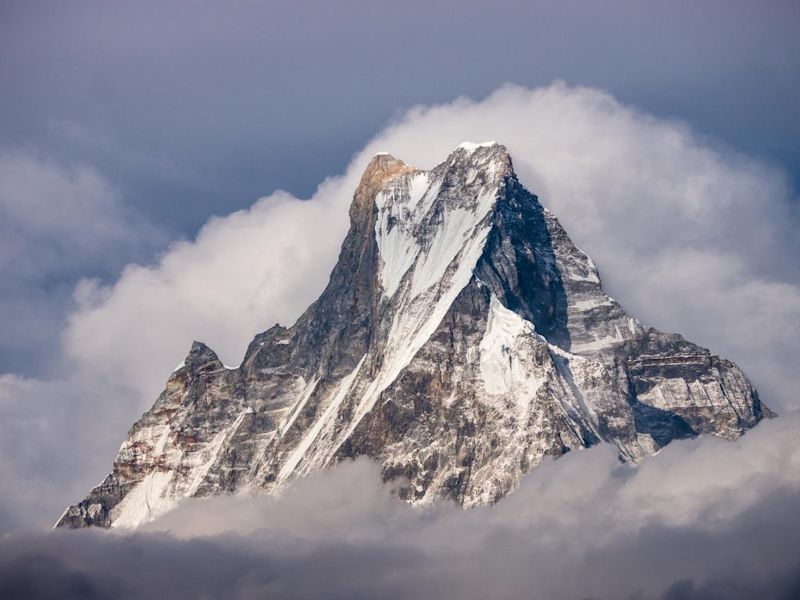
Machhapuchhare viewed from Tadapani
Culture and religion
The Everest Base Camp trek takes place in Nepal’s eastern Himalayas, while the Annapurna Circuit is in the country’s central Himalayan region. There are many similarities between the peoples of the two regions, but also significant differences.
The Sherpa of the Everest Base Camp trek
If you’re someone who likes to immerse yourself in just one area and culture rather than contiki-ing your way through a holiday, then the EBC trek is for you. This part of the Himalayas is home to the Sherpa people. The Sherpa are famous worldwide for their mountaineering feats, which are made possible by how well they cope with high altitude.

A beautiful Sherpa girl with her goat
The Everest Base Camp trek exposes you to the culture of the Sherpas. The Annapurna Circuit exposes you to the cultures of various distinct people groups.
The Sherpa people are mostly Tibetan Buddhist. Buddhism was brought to the area in the late 1600s and largely replaced the animism that previously held sway. The EBC trek exposes you to many colourfully decorated Buddhist buildings and monuments. There are the well-known stupas, for instance, which are hemispherical monuments that mark a significant spot or house relics. These can be found throughout the Khumbu region.
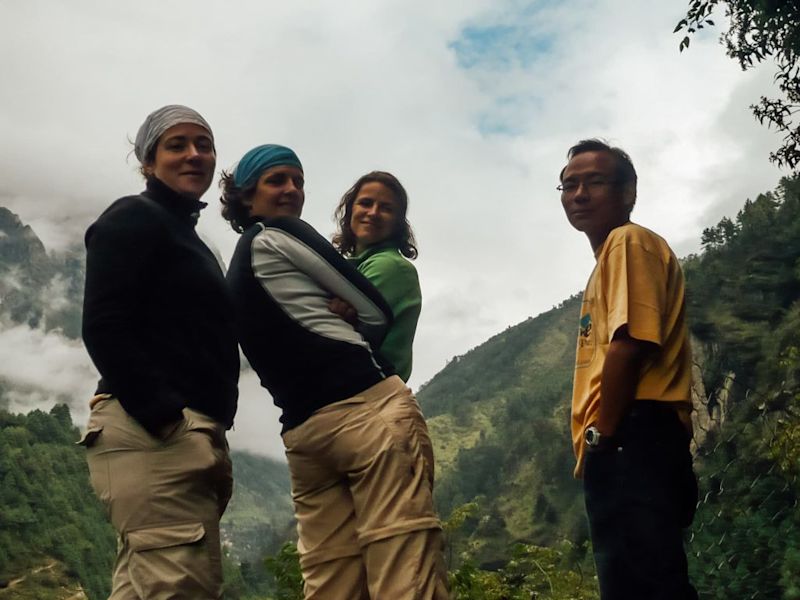
Everest Base Camp trekkers looking pretty pleased with their lot
Different people groups of the Annapurna Circuit
The Annapurna Circuit exposes you to many more cultures and communities than does the EBC trek. It actually gives you a better perspective of the people groups of Nepal. This is because the majority of Nepalese people are of Indian heritage and Hindu faith.
Manang District
The first half of the Annapurna Circuit (the eastern half), takes you through the Manang District of Nepal. In the subtropical, lowland part of Manang you’ll meet the Chhetri people, who migrated to the Himalayas hundreds of years ago from India. The Chhetri constitute over 15% of the Nepalese population. This region is also home to the Brahmins, which is a name many westerners know because priests in the Hindu religion come from the Brahmin caste.
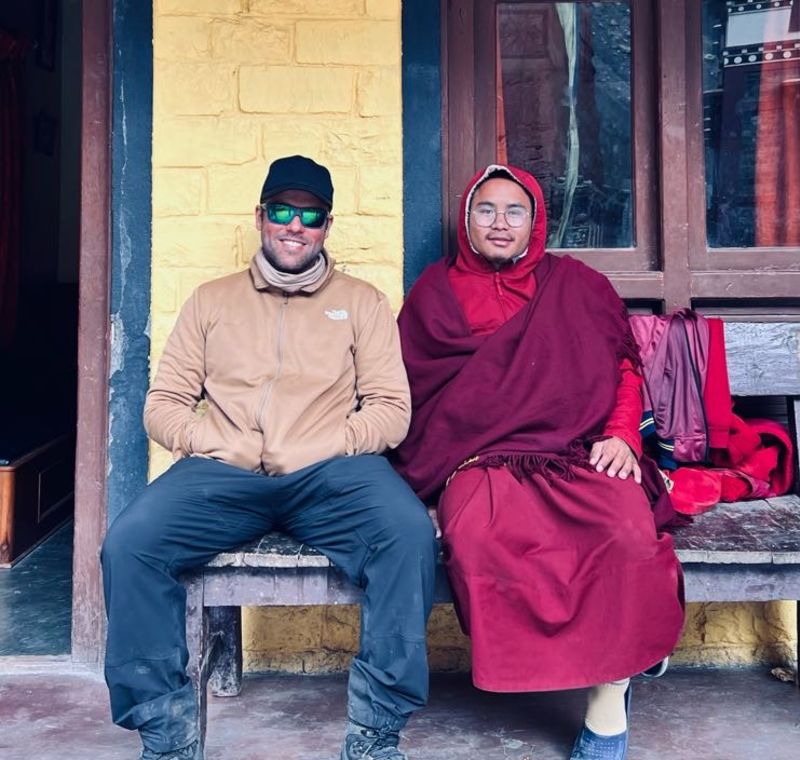
Our client Hala Macknight connecting with a local monk on the circuit
Hinduism is a prominent religion in the Annapurna region. Annapurna is actually the Hindu goddess of food and nourishment. The mountains are named after her as she’s believed to reside there. The fact of the Hindu-origin name is another indicator that the cultural tradition of this central region of the Himalayas is very different from that of the Khumbu, where Tibetan Buddhism dominates.
Hinduism is a prominent religion in the Annapurna region.
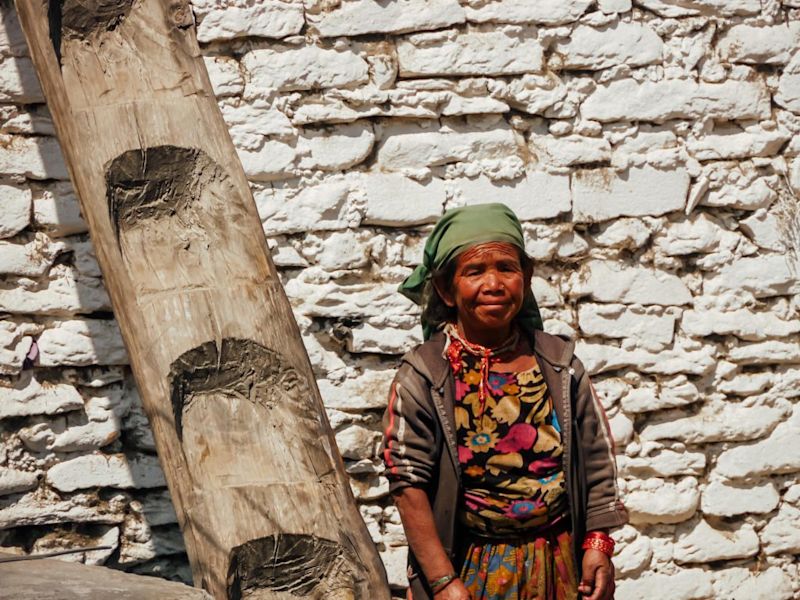
The Annapurna region is home to many different people groups with differing histories, languages and religions
When you climb higher into the Annapurna mountains you start to encounter communities where the inhabitants have stronger ethnic, cultural and religious ties to Tibet than they do to their fellow citizens of Indian descent. The people therefore look different, dress differently, build differently designed buildings, speak different languages, and on it goes. Stupas and other Buddhist structures start to crop up.
Mustang District
During the second half of the Annapurna trek one descends from Thorung La into the Mustang District. This region is home to people like the Manangi, Magar and Thakali. Again, they have their own distinct identities linked to the Mustang region and its history.
Tibetan Buddhism and Hinduism aren’t the only religions followed by the people of the Annapurna region. There are also adherents of Bon, shamanism and animism.
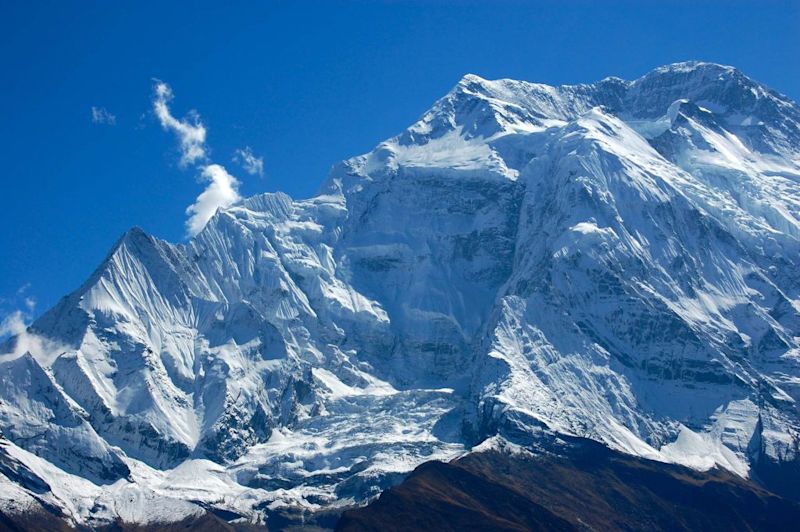
View of Annapurna II from the north, as we see it on the Annapurna circuit trek. Does anyone else see the face in the mountain? Could it be Annapurna herself?
Cultural sites
We can’t mention every village, gompa, monastery and prayer wall that is noteworthy, beautiful and deserving of a mention, so we’ll just mention a few that represent that spectrum. They’ll whet your appetite while keeping some things a surprise. And also perhaps help you in your Annapurna versus Everest Base Camp ponderings.
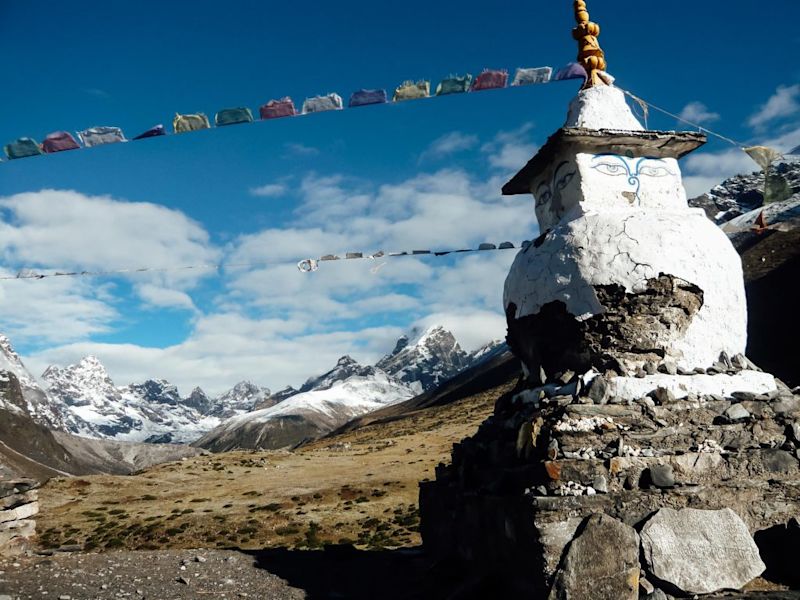
One of many stupas on the EBC trek route
Everest Base Camp cultural attractions
Almost everyone trekking to Everest Base Camp stops over in Namche Bazaar for at least one day to acclimatise. We do the same. Fortunately, there’s plenty of sightseeing to do within Namche Bazaar, not to mention a few great day hikes. We recommend visiting the Sherwi Khangba Center. It has a wonderful Sherpa Culture Museum as well as a Sherpa Culture Photo Gallery.
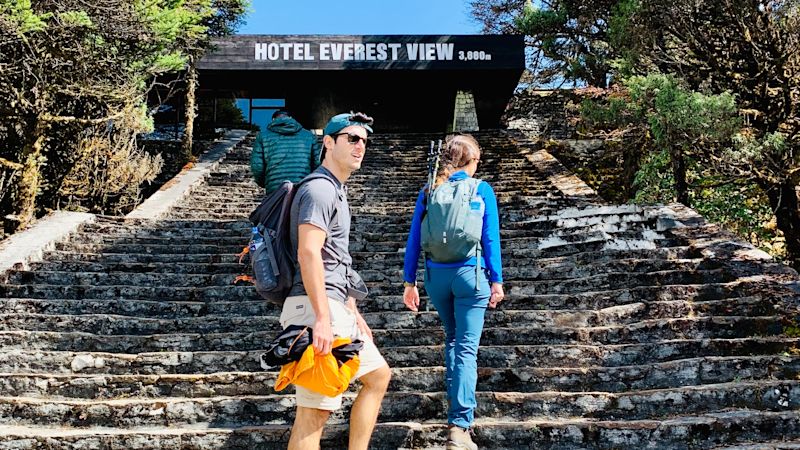
Walking up to Everest View Hotel
If you decide to do a hike from Namche Bazaar, you should definitely stop for a drink at Everest View Hotel. You can enjoy a 360-degree view of the mountains around you at this uniquely placed hotel.
Further along the trail we stop over for a night in the village of Tengboche. Here we have the chance to visit Tengboche Monastery, the largest monastery in Khumbu . The colourful monastery, also known as Dawa Choling Gompa, is home to about 60 Tibetan Buddhist monks. The monks wear the traditional and distinctive maroon robes.

Close up of some of the prayer wheels that make up the Tibetan Buddhist Prayer Wheel Wall of Upper Pisang, a village along the Annapurna Circuit trek
Tibetan Buddhism is a type of Buddhism that developed in the eighth century in Tibet. It involved mixing Buddhism with the indigenous Tibetan religion of Bon. The present-day leader of Tibetan Buddhism, as you likely know, is the Dalai Lama, who lives in exile in India.
Annapurna Circuit cultural attractions
In Upper Pisang, which we visit on Day 4 of the trek, there is the long Tibetan Buddhist Prayer Wheel Wall. This is an oft-photographed site along the trek. It consists of a line of hand-carved cylindrical copper wheels that you roll with your hand.
On our second day of acclimatisation in the town of Manang we recommend a visit to the Himalayan Rescue Association clinic. Established in 1981, the clinic seeks to protect trekkers in the Annapurna region through both education and emergency assistance. You can also learn about the 2014 snowstorm disaster and what was done to assist trekkers during that fateful time.

A suspension bridge near Kagbeni
After the trek we visit the mediaeval riverside village of Kagbeni. Here one finds the Kag Chode Thupten Samphel Ling Gompa, which means Monastery of the Place to Stop and Develop Concentration on the Teachings of Lord Buddha. The monastery was founded in the fifteenth century and is still in use today. It's painted a striking orange and has a desolate mountain dropping scree at its feet as a neighbour.
Prayer flags
Wonderfully, the colourful Tibetan prayer flags we’ve all come to associate with the Himalayas are to be found in abundance along both the EBC trek and the Annapurna Circuit.
On both treks we see prayer flags strung from religious buildings as well as from homes, businesses and bridges. They’re placed where they are to bless the area and promote peace, compassion and wisdom. For many of us, a trek without prayer flags wouldn’t really feel like a Himalayan trek at all. That's how synonymous they've become with the region.
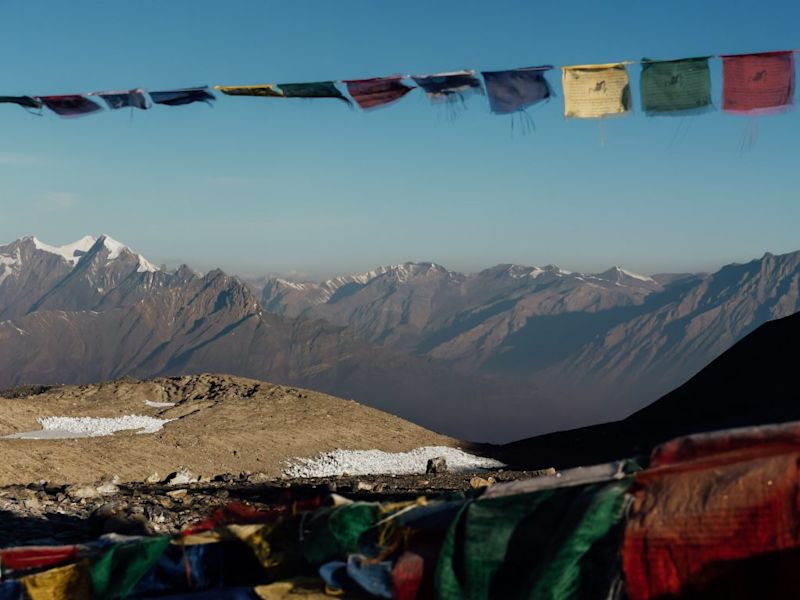
Prayer flags are iconic to the Himalayas
Trek route variety
When it comes to sheer variety, the Annapurna Circuit route beats out the Everest Base Camp route . Not only is the Annapurna region more culturally diverse, as already touched upon, but the landscape, wildlife and trek route offer many more shifts and surprises.
For starters, the Annapurna trail is a roughly circular route . This means you never have to retrace your steps, which for some is important.

Trekkers en route to Thorung Phedi on the Annapurna Circuit
On the EBC trek, the only way into Sagarmatha National Park is through the Khumbu Valley. The start and end days of the trek must therefore necessarily be the same. Unless of course you fly back to the start point via helicopter – there'll be no retracing of steps if that's the case.
Both the Annapurna Circuit and the Everest Base Camp trek have so much to offer in terms of fascinating wildlife, local culture, and religious landmarks.
You can expect dirt footpaths for large parts of both treks. You can also expect foot bridges, uneven steps, rocky paths, and loose rocks and gravel. In places you’ll be walking along narrow contour paths with steep drops.
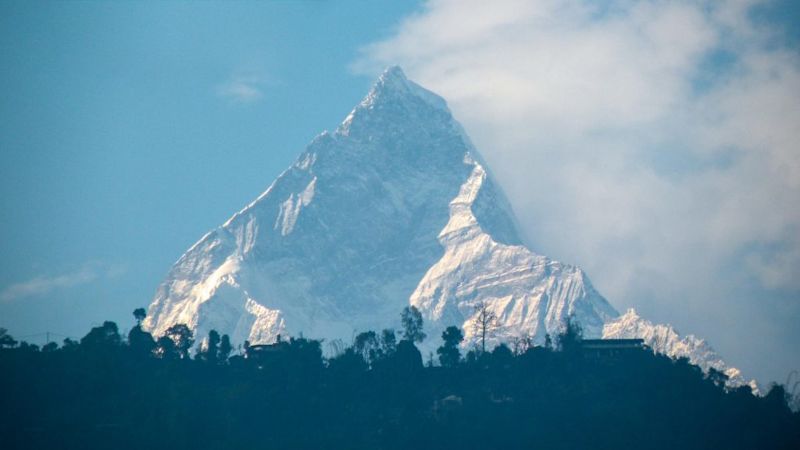
Another view of the magnificent mountain Machhapuchhre
Even if you trek in a typically warmer month, the weather in the Himalayas can be capricious and you can get a dump of snowfall at any time of the year. You should therefore anticipate the possibility of walking in snow .
Natural features
No doubt the main reason you want to go trekking in the Himalayas is to feel small and awe-filled in the midst of such natural grandeur and beauty. Both the EBC and Annapurna treks have so much to share in terms of mighty glaciers, icy lakes, rushing rivers and deep gorges. For the nature lover, these treks are an immersion into Mother Nature’s power and creativity.
Everest Base Camp natural features
Most of the EBC trek takes place within Sagarmatha National Park, one of the largest of Nepal’s dozen national parks. It’s a Natural World Heritage Site. Sagarmatha is also part of the Sacred Himalayan Landscape, a transnational protected space that’s home to some very important landscapes and wildlife.
Within Sagarmatha National Park you’ll encounter two distinct climatic zones:
- The temperate zone of the lower Himalayas
- The arid mountain zone of the higher Himalayas
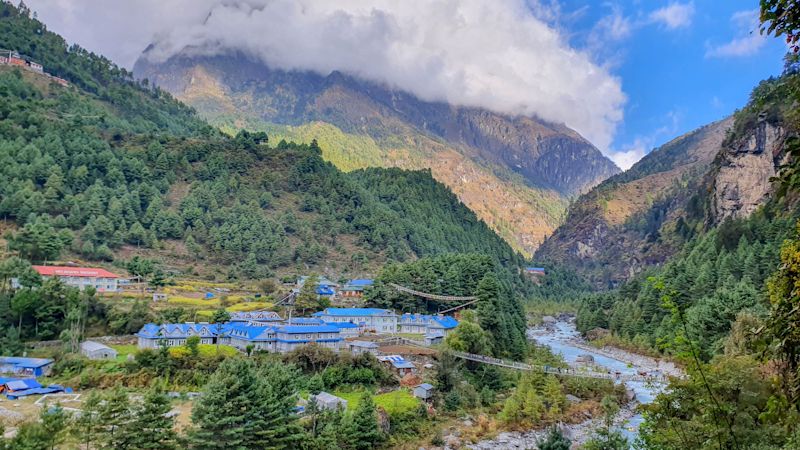
We overnight in the temeperate village of Phakding on the first night of the EBC trek
In the temperate zone you can expect steep, tree-clad valleys, flowers and flowering bushes, gorges and cliff faces, and rushing rivers and waterfalls. When you venture into the higher, arid zone, you’re above the tree line and in the company of boulders, ice patches, barefaced rock and snow-covered mountains.
The Khumbu Glacier
The Khumbu Glacier is the world’s highest glacier.
The Khumbu Glacier has a large icefall known as the Khumbu Icefall on its west end. EBC is situated at the foot of the Khumbu Glacier, and so is a very real goal post to work towards on the trek.
Gokyo Lakes
The Gokyo Lakes, a World Heritage Site, is a true highlight of our EBC and Gokyo Lakes trek itinerary.
Six main lakes make up the Gokyo Lakes, with Thonak Lake being the largest. The lakes are the world’s highest freshwater lake system. They're an otherworldly sight: pale blue water completely surrounded by barren slopes and snow-capped peaks. Or, in winter, pale water surrounded by a world of white.
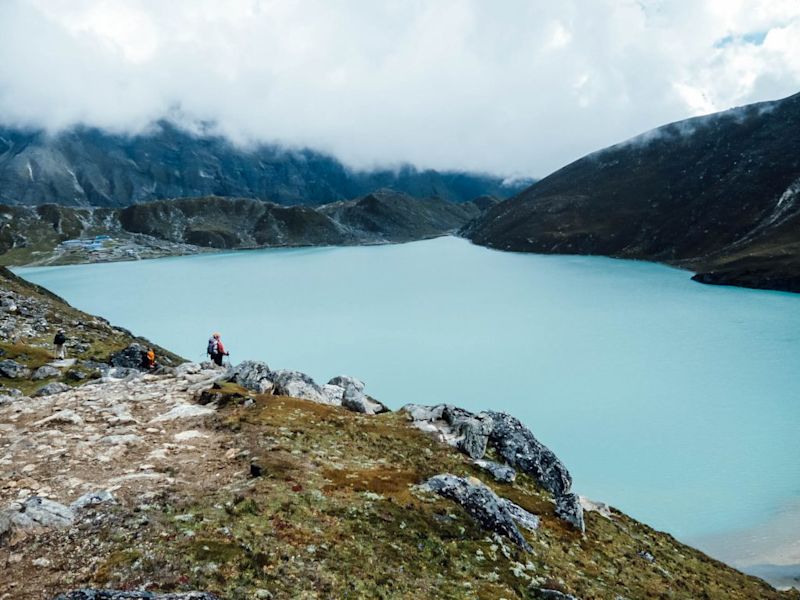
One of the beautiful Gokyo Lakes, where we spend two nights during the Everest Base Camp trek
Annapurna Circuit natural features
The Annapurna Conservation Area (ACA) is by far the largest protected area in Nepal, and is seven times larger than Sagarmatha National Park!
Like Sagarmatha National Park, the ACA also has a temperate zone and cold mountain zone, but it has the bonus of offering a subtropical zone as well.
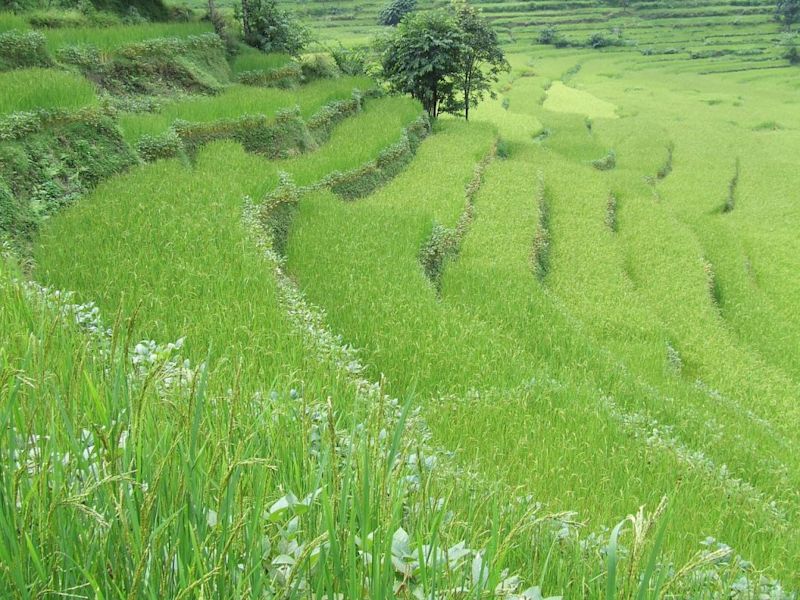
Terraced farms are a common sight along the lower section of the Annapurna Circuit
The forests of the subtropical region receive much more rain and offer dense forests with creepers and lots of undergrowth. The forests of the temperate zone are made up of trees like pine, oak and juniper.
During our first acclimatisation day in Manang, there’s the option of a day’s hike to Kicho Tal (Ice Lake). This is a gorgeous hike to a gorgeous location, so even though the going is steep and tough, we encourage trekkers to try do it. The ice lake is completely surrounded by some of the world’s highest peaks, and also offers one of the quieter spots along the Annapurna as not all make the effort to climb up to it.
The Kali Gandaki Gorge
The Kali Gandaki Gorge (or Andha Galchi) is the world’s deepest gorge. During our short flight from Jomsom to Pokhara on Day 11 of the Annapurna trip, we wind our way through this gorge in a small aircraft, enjoying a plane ride like no other.

The Annapurna Circuit offers the most varied scenery of any classic Nepal trek
Finally, when we’re happily resting our tired feet in Pokhara, we’ll be able to look out over the lovely Phewa Lake. Pokhara sits on the banks of the lake, and is a popular tourist destination in its own right. You might choose to hire a canoe and row about – destination or no destination in mind!
One of the highlights of the Annapurna and Everest Base Camp treks is the animal and birdlife, many species of which are unique to that part of the world. Many of the animals to be on the lookout for can be found in both Sagarmatha National Park and the Annapurna Conservation Area (ACA), given their similar and connected ecosystems.
It’s only the lowest portion of the Annapurna route that offers subtropical wildlife like monkeys, which you won’t find along the Everest Base Camp trek.
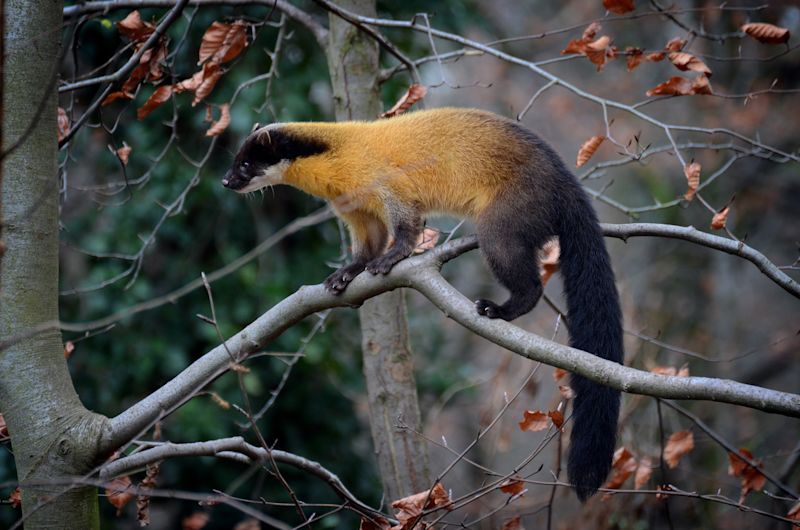
Yellow-throated martens live can be found on both the AC and the EBC trek
Wild animals
Both the ACA and Sagarmatha are home to a variety of very special animals. Probably at the top of most people’s lists would be the endangered snow leopard. You might like to watch this short video on snow leopards by National Geographic to learn about this elusive creature. Did you know that the snow leopard is also called an ounce?
Sagarmatha and the ACA are also home to the endangered red panda. The red panda is not actually closely related to the giant panda, even though its name suggests otherwise. Legend has it that if you see a red panda you go straight to heaven. Okay, we made that up, but to see a red panda in the wild would surely feel rather heavenly.
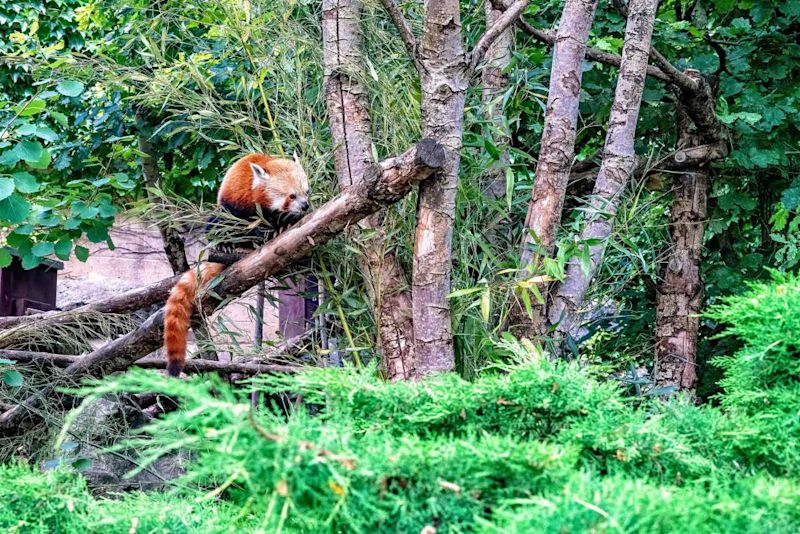
A red panda
Other animals in the two regions include:
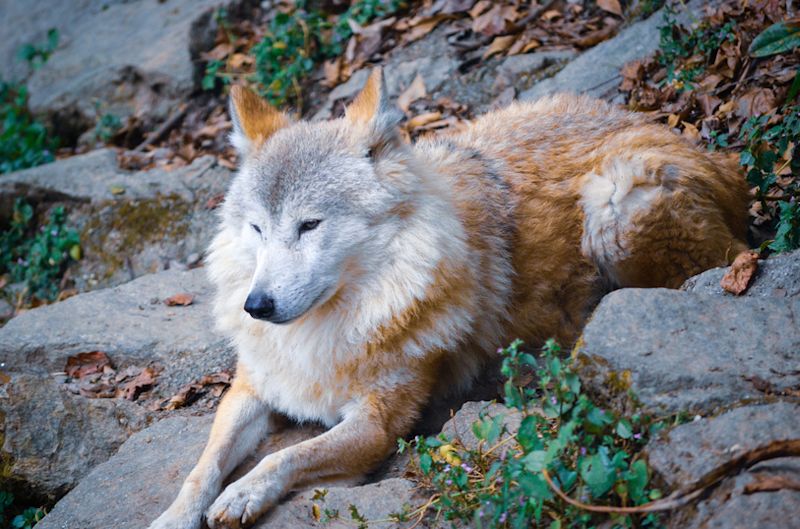
A Himalayan wolf
One of the perks of travelling in a group is having a local tour guide who is trained to spot wildlife.
On both the Everest Base Camp and Annapurna treks we have local guides to lead us along the entire trek route and help us enjoy the time by doing things just like pointing out hard-to-spot animals.
Oangdi is one of our highly qualified and awesome Nepal trek leaders
To learn more about the EBC trek animals and see some pics, please look at What animals will I see on the Everest Base Camp trek?
Domesticated animals
Obviously the wild animals aren’t the only animals you’ll encounter on either of the two trek routes. There’ll also be yaks, cattle, yattle (yak-cow hybrids), donkeys and horses to step aside for on the path, or photograph as they graze in pastures.

Yaks and yattle are seen everywhere in the Nepali Himalayas
Sagarmatha National Park has been designated an Important Bird Area by BirdLife International. It has over a hundred bird species.
The ACA, being seven times larger in area, has even more birdlife to offer: it boasts hundreds of different bird species. If you’re a birdwatcher, look out for beautiful flycatchers, greenfinches, dainty bush chats, griffons, and, of course, eagles. The list really could go on and on.
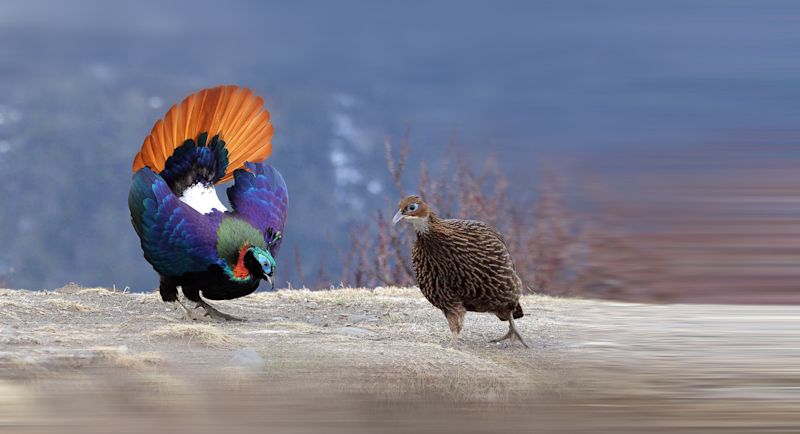
Male and female Himalayan monals
Trees, plants and flowers
One of the joys of travel is seeing beautiful new plants and trees. Many people choose a destination just to see exotic spring flowers or towering trees. We feel them. So in the tradition of rating Annapurna versus EBC: which stacks up better in terms of the flora on offer?
Rhododendrons on the EBC trek
Plants of the Annapurna Conservation Area
If you’re particularly keen to see flowers and other plants, then you’ll likely enjoy the Annapurna Circuit that much more. This is because you’ll pass through a subtropical climate in addition to the temperate and mountain climates that you encounter on the Everest Base Camp trek.
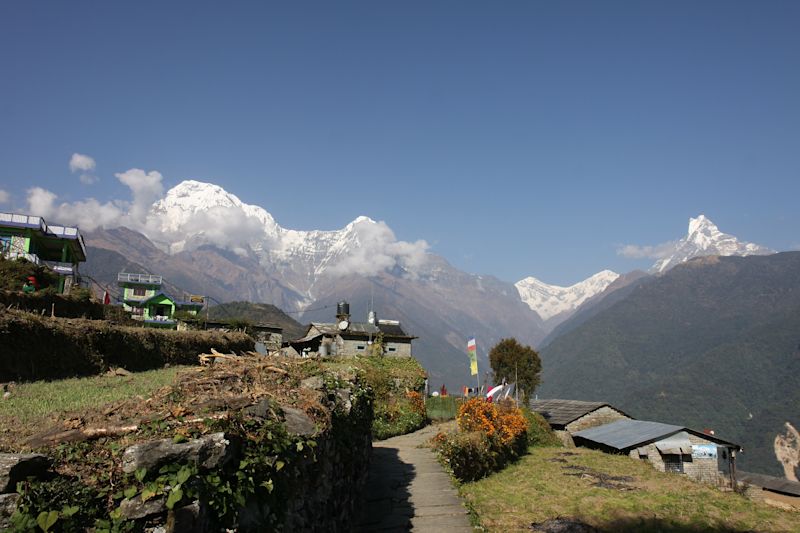
Flowers soften the upper reaches of the circuit
The subtropical zone receives far more rain, which is why farmers can grow rice, buckwheat, beans and other crops reliant on plenty of water. You can also anticipate plenty of beautiful flowers and trees, such as irises, orchids, magnolias and fig trees. The sacred fig, which can be found on the trek route, grows heart-shaped leaves and has significance in Hinduism, Buddhism and Jainism.
In the temperate zone of Annapurna you can expect oak, maple, fir and pine forests. You can also look forward to cherry trees and the region’s signature rhododendrons.
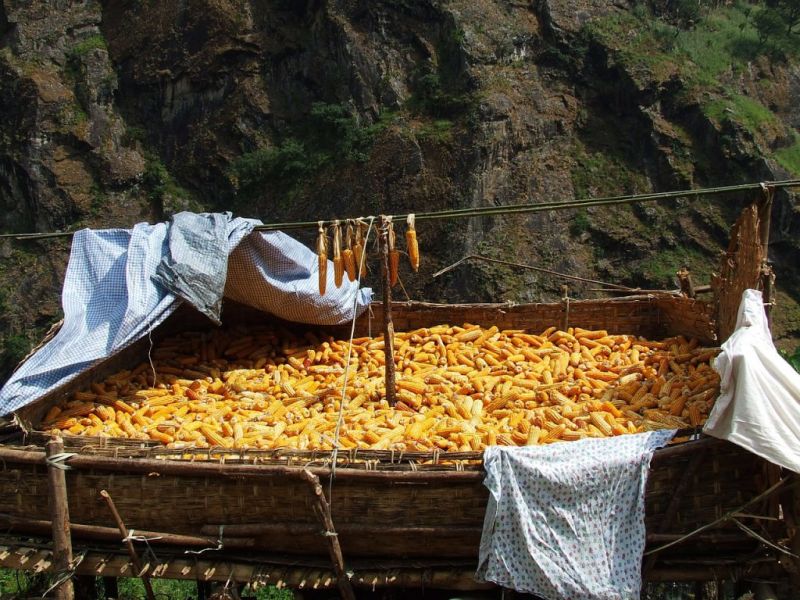
An Annapurna farmer dries his crop of corn
Plants along the Everest Base Camp trek
During the first portion of the EBC trek one sees bamboo, hemlock, juniper, birch, blue pines, silver firs and rhododendrons.
By the time we reach Everest Base Camp, however, we’re above the tree line in the tundra zone. In this zone we're down to mostly lichens, mosses and hardy grass tufts. That’s not to suggest the EBC trail has a paucity of vegetation however! The lower portion of the trek is lush and beautiful, and you’ll be ooh-ing and aah-ing plenty .
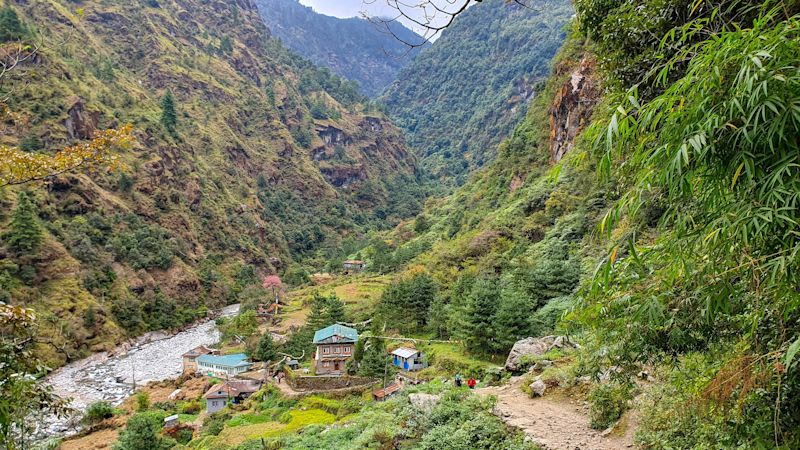
Surke village along the EBC trek route
Making the choice
Are you still struggling to decide between Annapurna and Everest Base Camp? If so, maybe it'll help for us to say this: this is one of those situations where there is no wrong decision!
There's no bad decision here. If you trek to Everest Base Camp, you win. If you trek the Annapurna Circuit, you win. 😉
And if you choose to fly back from Everest Base Camp via helicopter then you get to enjoy the most scenic flight your life! So you also win! There really isn't a bad option!
But most likely you feel confident by now that you know which trek is for you at this time. Please feel free to contact us if you’d like to discuss either of the treks. We’d love to share our knowledge and experiences of these two beautiful, world-class treks with you and help you plan a trip you’ll never forget.
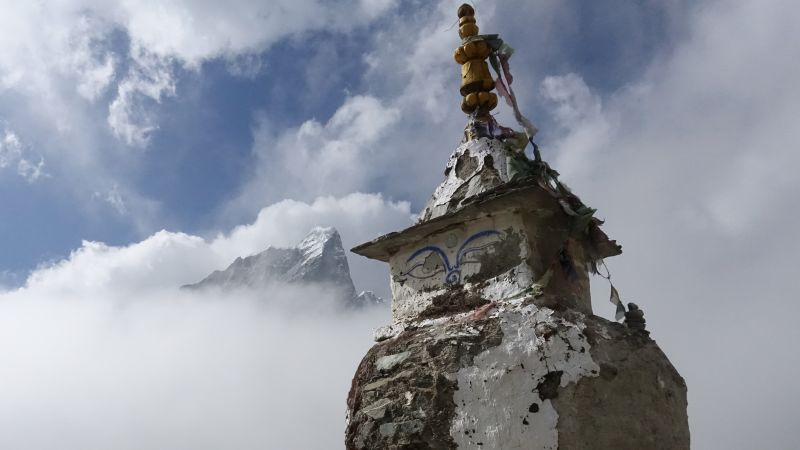
There are many gompas and prayer flags along the trek routes of the Nepal Himalayas
- (+977) 9803397710 Call / WhatsApp / Viber
- [email protected]

- Your cart is empty
Everest Base Camp Vs Annapurna Base Camp Trek: A Comprehensive Guide for first time Trekkers

- October 28, 2023 4:32 pm
In this article we will compare Everest Base Camp Vs Annapurna Base Camp Trek, The most popular trekking destinations in Nepal. Are you a first-time trekker looking to join on an unforgettable adventure in the majestic mountains of Nepal? Look no further! By the end of this blog, you’ll have all the information you need to make an informed decision and begin the trek of a lifetime.

Table of Contents
Everest Base Camp Trek
The Everest Base Camp (EBC) Trek is an epic adventure that takes you to the heart of the world’s highest mountain, Mount Everest . Starting in the vibrant city of Kathmandu, this trek unfolds in the stunning Khumbu region of northeastern Nepal. The journey begins with a scenic flight to Lukla, a Himalayan gateway, from where you’ll traverse diverse landscapes, from lush rhododendron forests and terraced fields to high-altitude Sherpa villages. As you ascend, you’ll cross suspension bridges, follow the Dudh Kosi River, and enjoy the company of the resilient Sherpa people, gaining insights into their culture and traditions. The trek reaches its climax at Everest Base Camp , standing at an elevation of approximately 5,364 meters, where you’ll be treated to close-up views of Mount Everest and surrounding peaks. This trek is known for its challenging terrain and higher altitudes, demanding proper acclimatization. It’s a once-in-a-lifetime experience that combines the thrill of adventure with the rich Sherpa culture and the unparalleled beauty of the Himalayas.
- Close-up Views of Mount Everest and Other Majestic Peaks.
- Trekking Through the Stunning Khumbu Region.
- Scenic Flight from Kathmandu to Lukla.
- Crossing Iconic Suspension Bridges.
- Exploring Traditional Sherpa Villages and Monasteries.
- Rich Sherpa Culture and Hospitality.
- Namche Bazaar, the Vibrant Trading Hub.
- Tengboche Monastery and Ama Dablam Views.
- Everest Base Camp and Kala Patthar for Panoramic Vistas.
- Challenging Terrain and High-Altitude Adventure.
Everest Base Camp Trek Outline Itinerary
- Day 1: Arrival in Kathmandu and trek preparation.
- Day 2: Fly to Lukla and trek to Phakding.
- Day 3: Trek to Namche Bazaar.
- Day 4: Acclimatization day in Namche Bazaar.
- Day 5: Trek to Tengboche.
- Day 6: Trek to Dingboche.
- Day 7: Acclimatization day in Dingboche.
- Day 8: Trek to Lobuche.
- Day 9: Trek to Gorak Shep, and hike to Everest Base Camp.
- Day 10: Early morning hike to Kala Patthar for breathtaking sunrise views, and trek back to Pheriche.
- Day 11: Trek to Namche Bazaar.
- Day 12: Trek back to Lukla.
- Day 13: Fly back to Kathmandu.

Annapurna Base Camp Trek
The Annapurna Base Camp (ABC) Trek is a captivating journey through the heart of Nepal’s Annapurna region, renowned for its stunning landscapes and breathtaking mountain vistas. Beginning in the picturesque city of Pokhara, this trek offers a diverse range of experiences, from walking through lush subtropical forests and terraced fields to immersing yourself in traditional Gurung and Magar villages. As you follow the Modi Khola River and cross suspension bridges, the trek gradually takes you higher into alpine meadows and barren terrain, culminating in the awe-inspiring Annapurna Base Camp . At an altitude of around 4,130 meters, this destination provides panoramic views of iconic peaks, including Annapurna I, Machapuchare (Fishtail), and Hiunchuli. The ABC Trek is known for its moderate difficulty, making it accessible to trekkers of various fitness levels and an ideal choice for those seeking a close encounter with the Himalayan mountains and Nepalese culture.
- Breathtaking Views of Annapurna and Machapuchare (Fishtail) Mountains.
- Diverse Landscapes, from Lush Forests to Alpine Meadows.
- Traditional Gurung and Magar Villages.
- Rich Flora and Fauna in the Annapurna Conservation Area.
- Suspension Bridge Crossings Over Rivers.
- Soaking in Natural Hot Springs at Jhinu Danda.
- Annapurna Sanctuary’s High-Altitude Terrain.
- Annapurna Base Camp with Panoramic Mountain Vistas.
- Moderate Trek Suitable for a Range of Fitness Levels.
- Immersion in Nepalese Culture and Warm Hospitality.
Annapurna Base Camp Trek Outline Itinerary
- Day 02: Drive from Kathmandu to Pokhara by Tourist Bus / Option: Flight (820 m) 6-7 Hrs Drive
- Day 03: Drive from Pokhara to Ghandruk (1940 m) 5 Hrs Drive
- Day 04: Trek from Ghandruk to Chhomrong (2170 m) 5-6 Hrs Trek
- Day 05: Trek from Chhomrong to Himalaya (2920 m) 6 Hrs Trek
- Day 06: Trek from Himalaya to Annapurna Base Camp (4130 m) 5-6 Hrs Trek
- Day 07: Trek from Annapurna Base Camp to Bamboo (2310 m) 6-7 Hrs Trek
- Day 08: Trek from Bamboo to Jhinu Danda (1780 m) 6-7 Hrs Trek
- Day 09: Drive from Jhinu Danda to Pokhara (820 m) 5-6 Hrs drive
- Day 10:Drive from Pokhara to Kathmandu by Tourist Bus / Option: Flight
Location and Scenery:
Both the Everest Base Camp (EBC) and Annapurna Base Camp (ABC) treks offer stunning natural beauty, but they differ in terms of location and scenery:
- Everest Base Camp (EBC) Trek: Located in the northeastern part of Nepal, in the Khumbu region of the Himalayas. The trek starts with a flight to Lukla and takes you through the Sagarmatha National Park, home to Mount Everest.
- Annapurna Base Camp (ABC) Trek: Situated in the western part of Nepal, within the Annapurna Conservation Area. The trek starts from the city of Pokhara and leads into the Annapurna Sanctuary, a glacial basin surrounded by Annapurna and Machapuchare mountains.
- Everest Base Camp (EBC) Trek: This trek offers breathtaking views of the world’s highest peaks, including Mount Everest, Lhotse, Nuptse, and Ama Dablam. The landscape is characterized by rugged terrain, rocky paths, and high-altitude barren landscapes as you approach EBC. You’ll also encounter Sherpa culture and traditional villages along the way.
- Annapurna Base Camp (ABC) Trek: The ABC Trek provides diverse scenery, with lush rhododendron forests, terraced fields, and traditional Gurung and Magar villages in the lower sections. As you ascend, the landscape transitions to alpine meadows, and the trek culminates in the pristine Annapurna Sanctuary with panoramic views of the Annapurna and Machapuchare (Fishtail) mountain ranges.
The EBC Trek is famous for its close-up views of the world’s tallest peaks and challenging terrain, while the ABC Trek offers a more diverse range of landscapes, including lush forests and traditional villages, culminating in a glacial basin with stunning mountain vistas. The choice between them often depends on personal preferences, fitness level, and the specific experience you’re seeking.
Trek Difficulty:
The difficulty of the Everest Base Camp (EBC) Trek and the Annapurna Base Camp (ABC) Trek varies, primarily due to differences in altitude and terrain. Here’s a comparison of the trek difficulty for both:
Everest Base Camp (EBC) Trek:
- Higher Altitude: The EBC Trek involves trekking to significantly higher altitudes. The trek’s highest point is Everest Base Camp at around 5,364 meters (17,598 feet). This elevation presents a greater risk of altitude-related illnesses, and trekkers must take acclimatization seriously.
- Challenging Terrain: The terrain in the Khumbu region can be more rugged and steep, with stone steps, rocky paths, and occasional exposure to high cliffs. Trekkers may also face unpredictable weather conditions and occasional snow or ice, especially during the colder months.
- Longer Duration: The EBC Trek typically takes around 12-14 days, including rest and acclimatization days, to allow for a gradual ascent and proper acclimatization.
- Strenuous Climb: The trek to Kala Patthar (a viewpoint near EBC) is particularly challenging due to the steep ascent, but it offers stunning views of Mount Everest.
Annapurna Base Camp (ABC) Trek:
- Lower Altitude: The ABC Trek is at a lower maximum altitude compared to the EBC Trek. The highest point is Annapurna Base Camp at around 4,130 meters (13,550 feet), making it a less strenuous trek in terms of altitude.
- Varied Terrain: The terrain during the ABC Trek is relatively more diverse, featuring well-maintained trails, forested areas, and terraced fields in the lower sections. The trek offers a mix of ascent and descent, with some steep sections but generally less challenging terrain than the EBC Trek.
- Shorter Duration: The standard ABC Trek can be completed in about 7-12 days, depending on the specific route and pace chosen. It’s a shorter trek overall.
- Moderate Climb: The trek to Annapurna Base Camp involves a gradual ascent, and the highest point (ABC) is not as demanding as Kala Patthar in terms of steepness.
The Everest Base Camp Trek is generally considered more challenging due to its higher altitudes, unpredictable weather, and longer duration. The Annapurna Base Camp Trek is relatively less strenuous, making it suitable for a wider range of fitness levels. However, both treks require a good level of physical fitness, and proper acclimatization is crucial to ensure a safe and enjoyable trek.

Treks Duration:
The duration of the Everest Base Camp (EBC) Trek and the Annapurna Base Camp (ABC) Trek can vary depending on several factors, including the specific itinerary, trekking pace, and the inclusion of rest or acclimatization days. Here’s a comparison of the typical duration for each trek:
- The standard duration for the EBC Trek is about 12 to 14 days, including both the trek to Everest Base Camp and the return journey. This duration allows for proper acclimatization and a gradual ascent to higher altitudes.
- Trekking to EBC can take 8-10 days from Lukla to the base camp, with additional days for acclimatization in places like Namche Bazaar and Dingboche.
- You may also add extra days for side trips to places like Gokyo Lakes or the Everest View Hotel, further extending the trek.
- The ABC Trek typically takes around 7 to 12 days to complete the round trip, depending on the specific route, trekking pace, and the inclusion of rest or acclimatization days.
- A shorter version of the ABC Trek can be done in about 7-8 days, covering the essential highlights.
- Longer itineraries may extend to 10-12 days, allowing for a more relaxed experience and additional exploration of the Annapurna region.
The EBC Trek tends to be a bit longer in terms of the standard itinerary, primarily due to the necessity of additional acclimatization days at higher altitudes. The ABC Trek offers more flexibility in terms of duration, with options for shorter or longer treks to suit the preferences and time constraints of trekkers. However, both treks can be customized to meet your specific needs and interests.
Trekking Season:
The trekking seasons for the Everest Base Camp (EBC) Trek and the Annapurna Base Camp (ABC) Trek are similar in terms of when they are most popular and favorable for trekking. However, there are slight variations in weather conditions due to their geographical locations. Here’s a comparison:
- Autumn Season (September to November): This is the most popular and recommended season for the EBC Trek. During autumn, the weather is generally stable, skies are clear, and temperatures are comfortable. The views of the Everest and other peaks are at their best. It’s the peak trekking season, so trails and teahouses can be crowded.
- Spring Season (March to May): Spring is the second best season for the EBC Trek. The weather is warm, and the rhododendrons are in full bloom, adding vibrant colors to the landscape. However, it can be a bit busier than other times of the year.
- Winter Season (December to February): The winter season is less popular due to cold temperatures, snowfall, and a higher risk of avalanches in some areas. Trekking is still possible, but it’s challenging, and some teahouses may be closed.
- Monsoon Season (June to August): Monsoon season brings heavy rain and is not recommended for trekking in the Everest region. Trails can be muddy, slippery, and leech-infested, and landslides are common.
- Autumn Season (September to November): Like the EBC Trek, this is the prime season for the ABC Trek. The weather is pleasant, skies are clear, and the landscapes are beautiful. It’s a busy time for trekking in the Annapurna region.
- Spring Season (March to May): Spring is another excellent season for the ABC Trek. The weather is mild, and the blooming rhododendrons and other wildflowers add charm to the trek.
- Winter Season (December to February): The ABC Trek is still possible during winter, but it’s colder, especially at higher elevations. Trails can be snowy or icy, and some teahouses may be closed.
- Monsoon Season (June to August): Just like in the Everest region, the monsoon season is not recommended for trekking in the Annapurna region due to heavy rain, leeches, and landslides.
Both treks are best experienced during the autumn and spring seasons, offering the most pleasant weather and clear mountain views. However, the Everest Base Camp Trek can get more crowded during these times. While trekking during the winter is possible, it’s challenging due to cold temperatures and snow. Monsoon season should generally be avoided for trekking in both regions.
Permits and Regulations:
Permits and regulations for the Everest Base Camp (EBC) Trek and the Annapurna Base Camp (ABC) Trek are similar in many respects, as both regions are part of Nepal and subject to national regulations. However, there are some specific permits and differences to be aware of. Here’s a comparison:
- Sagarmatha National Park Permit: To enter the Sagarmatha National Park, where the EBC is located, you need a Sagarmatha National Park Permit. This permit costs around USD 30 per person and is valid for a specified duration.
- Khumbu Pasang Lhamu Rural Municipality (RM) Entry Permit: To access certain areas within the Khumbu region, including Namche Bazaar, Thame, and Khunde, you need a Khumbu Pasang Lhamu RM Entry Permit, which costs around USD 20.
- TIMS Card: The Trekker’s Information Management System (TIMS) card is generally not required for the EBC Trek as of my last update in January 2022. However, regulations can change, so it’s essential to verify the latest requirements with local authorities or your trekking agency.
- Local Regulations: Keep in mind that local rules and regulations may change, so it’s crucial to stay informed about the latest permit requirements and regulations in the Everest region.
- Annapurna Conservation Area Permit (ACAP): To enter the Annapurna Conservation Area, where the ABC is located, you need an ACAP permit. The cost of the permit varies for foreigners and SAARC (South Asian Association for Regional Cooperation) nationals. As of my last update, it was around USD 30 for foreigners.
- TIMS Card: The TIMS card is generally required for the ABC Trek. It comes in two categories: Green TIMS card for organized trekkers and Blue TIMS card for independent trekkers. The cost may vary depending on your trekking style.
- Local Regulations: As with the Everest region, local regulations can change, so it’s essential to verify the latest permit requirements and regulations with the authorities or your trekking agency.
While both treks require permits to enter their respective conservation areas, the specific permits and their costs may differ. The Everest Base Camp Trek requires the Sagarmatha National Park Permit and the Khumbu Pasang Lhamu RM Entry Permit, while the Annapurna Base Camp Trek necessitates the ACAP permit and the TIMS card. Always ensure you have the most up-to-date information on permits and regulations before embarking on your trek.
Accommodation Foods and Facilities:
Accommodation and facilities during the Everest Base Camp (EBC) Trek vs Annapurna Base Camp (ABC) Trek are generally similar in terms of the types of lodging available, but there are some differences in the quality and availability of facilities due to their locations and popularity. Here’s a comparison:
- Teahouses: Along the EBC Trek, you’ll find a network of teahouses or lodges in most villages and trekking stops. These teahouses provide basic accommodation, including private or shared rooms, common dining areas, and simple but hearty meals.
- Accommodation Quality: Accommodation in the Everest region tends to be more basic compared to the Annapurna region. Rooms may be colder at higher altitudes, and blankets or sleeping bags are often required, especially during colder months.
- Common Facilities: Teahouses typically offer shared bathrooms with squat toilets. Hot showers may be available but at an extra cost. Charging electronic devices is also possible, but it may come with an additional fee.
- Food and Water: Meals in the Everest region teahouses are basic, with a focus on dal bhat (lentil and rice), noodles, and simple Western dishes. Safe drinking water can be purchased or refilled with water purification tablets or filters.
- Teahouses: The ABC Trek also offers a network of teahouses, and the accommodation quality is generally better than in the Everest region. Teahouses are more comfortable, with cleaner rooms and better bedding options.
- Common Facilities: Teahouses along the ABC Trek offer shared bathrooms, and you can often find Western-style toilets. Hot showers may be available at some teahouses.
- Food and Water: Meals are more varied, with a broader range of menu options that include local and Western dishes. Safe drinking water can be obtained from purifying taps or bottled water.
- Electricity: Many teahouses in the Annapurna region have electricity and charging facilities in common areas, although it may come with an additional cost.
While both treks offer teahouse accommodation, the quality and comfort of teahouses are generally higher in the Annapurna region. This is because the Annapurna region has been a popular trekking destination for a longer time, and its infrastructure and facilities have developed accordingly. However, it’s essential to note that during peak trekking seasons, accommodations in both regions can get crowded, so it’s advisable to book in advance if possible.
Both the Everest Base Camp and Annapurna Base Camp treks offer unique experiences and breathtaking scenery. The choice between the Annapurna Base Camp and Everest Base Camp trek depends on your trekking experience, fitness level, the kind of scenery you prefer, and the amount of time you have available. Both treks offer stunning Himalayan vistas and unique cultural experiences, but the Everest Base Camp trek is more challenging due to higher altitudes. Consider your preferences and capabilities when making your decision. If you’re a first-time trekker seeking a moderate yet awe-inspiring adventure, the Annapurna Base Camp trek is an excellent choice. On the other hand, if you’re up for a more challenging journey that takes you to the iconic Everest Base Camp, then the Everest Base Camp trek is the way to go.
No matter which trek you choose, always remember to trek responsibly, respect the local culture, and ensure proper acclimatization to prevent altitude sickness. Prepare well, pack wisely, and get ready to embark on an unforgettable trekking experience in the majestic mountains of Nepal.
I love your blog in detail about everest base camp and annapurna base camp trek.
Leave a comment Cancel reply
Save my name, email, and website in this browser for the next time I comment.
Sign me up for the newsletter!
Enter the e-mail address associated with the account. We'll e-mail a link to reset your password.

Nepal Trek Booking Open for 2024/25 (Note: From March, the Lukla flights will be from Ramechhap)
0 RESULTS FOUND!
Annapurna Base Camp trek vs Everest Base Camp trek
Nepal is home to some of the most incredible Himalayas in the world. Just consider the fact that Nepal is home to eight of the ten highest peaks in the world. Most people recognize Nepal as the home of Mt. Everest - the highest mountain in the world. However, Everest is just one of the 866 named mountains in Nepal. Undoubtedly, Annapurna Base Camp and Everest Base Camp treks are the most popular treks in Nepal. Discovery World Trekking has been conducting treks to Everest Base Camp and Annapurna Base Camp for over a decade.
Though Annapurna Base Camp and Everest Base Camp have their own identity and strengths, in this article, we will look at the similarities and differences of these treks, including trek duration, cost, difficulty level, highlights, preparation, food, culture, etc.
.jpg)
Accessibility This one is quite obvious. You can travel to the Everest region or Annapurna region on land, but it is not practical to reach Everest Base Camp via land. Almost everyone flies from Kathmandu to Lukla, start their trek from Lukla, and gradually ascends to the Everest Base Camp. The flight lasts around 40 minutes. If you are short on time or physically unprepared, you can always book a helicopter tour to EBC.
The Annapurna region is very accessible on land. From Kathmandu, you can take a bus to Pokhara. The bus follows Prithivi Highway and will take roughly seven hours to reach Pokhara. However, you can also take a 20-minute flight to Pokhara from Kathmandu. Pokhara is the tourist capital of Nepal, and the city is much larger than Lukla or even Namche Bazaar in the Khumbu region.
Trip duration The standard Annapurna Base Camp Trek length is 110 km, while the Everest Base Camp is 130 km. So, the Annapurna Base Camp is shorter compared to Everest Base Camp. However, you can complete both of these treks through different routes, which can alter the number of days you will require to complete these treks.

The classical Everest Base Camp trek lasts fourteen days, but if you choose, you can finish the Everest Base Camp trek on a helicopter. During these days you can witness breathtaking views of Ama Dablam, Mt. Lhotse(8,516m), Cho Oyu(8,201m), and Mt.Makalu (8,463m). You have the option to visit the incredible Gokyo Lakes.
In the case of the Annapurna Base Camp trek, you can complete the hike in as little as seven days or as many as twenty-seven days. Longer Annapurna Base Camp treks include other notable paths in the Annapurna region. The path can include Annapurna Circuit and other highlights such as Tilicho Lake and Muktinath.
Difficulty level Annapurna Base Camp (ABC) lies at 4,130m. This is also the highest altitude you will reach during the ABC trek. However, Everest Base Camp is at 5,364m, and the highest point of the EBC trek is 5,555m at Kala Patthar Viewpoint. Most trekkers reach Kala Patthar to enjoy the fantastic early morning views. Generally, treks above 5,000m are regarded as challenging.
Hence, Everest Base Camp treks are much more challenging than the Annapurna Base Camp trek. Higher altitudes mean lower oxygen levels and hikes become very exhaustive. The temperature also falls at higher altitudes.
Cost differences How much you spend on your treks depends upon personal preferences. However, as EBC treks are more remote and last longer, you can safely assume that the ABC trek is relatively cheaper. As a rule of thumb, the higher you get, the more the cost of food and accommodation. The exact trek cost also differs according to the trek group size. If you have a bigger group, you can get higher discounts.
Trek regions Everest Base Camp treks start at 2860m and reach 5,364m at Everest Base Camp. So, by flying to Lukla, you will have gained a substantial height. But, as Annapurna Base Camp treks start at Pokhara (820m), you will enjoy the landscape and vegetation change as you trek higher.
In ABC treks, you will see the subtropical forests gradually, giving way to alpine terrain. You can see the dense jungles and multi-ethnic villages on the way. You can see how the Magars, Gurungs, and Thakali villages differ. Hence, if you love diversity and want to get a peak into what typical Nepal is all about the Annapurna Base Camp treks should be more appealing to you.
The Everest region is comparatively less diverse. You will mostly be visiting the Sherpa settlements. The climate and the vegetations are less varied compared to ABC treks.
In terms of wild animals, you can find yaks in the Everest region, which are absent in the Annapurna Base Camp regions. Both of these base camps are in protected regions. ABC lies in the Annapurna Conservation Area, while EBC lies in the Sagarmatha National Park. Annapurna Conservation Area is much larger compared to Sagarmatha National Park.
The thrill If you are an adventurous person seeking the adrenaline kick, you should choose the EBC treks. We suggest you pick the three-high passes trek , which is quite challenging. Since the paths will elevate a lot, you will find more thrill factors in the Everest Base Camp treks.
Altitude sickness

Both of these hikes are high-altitude treks, so there remains a small chance of catching altitude sickness. Since the ABC treks take place at a lower altitude, the chances of getting altitude sickness are less in the ABC treks compared to EBC treks.
Comfort Though you do not have to stay in camp tents during your EBC or ABC treks, the services available will differ. The Annapurna Base Camp lies near Pokhara, one of the affluent cities of Nepal. So, if you prefer comfort, then ABC treks are more suitable, with numerous hotels and lodges catering to a wide range of trekkers' preferences.

Popularity After you have finished your trek, when you return to your country and tell your friends you have reached Everest Base Camp, they will understand where you have been. But, if you tell them you completed a trek to Annapurna Base Camp, you will probably need to introduce them to the Annapurna mountain.
ABC and EBC treks have their own distinguishing features and are equally attractive. However, personal preferences might differ. In this article, we have captured the differences between these treks, making it easy for you to choose your next trip. However, it is always better to experience both of these treks.
For hassle-free and rich trek experiences, call us at 977-9840055491 or email [email protected] . Trek booking is open for the year 2023/2024.
The major cultures prevalent in the Nepali Himalayas
The forbidden mountains - mt. khumbila & machhapuchhare, thorong la pass: the highest pass in the annapurna circuit, trekking jomsom: adventures in nepal's windy valley, tatopani: wellness amidst the himalayas, our history in service excellence, we are associated with:.
Discovery World Trekking is the trademark name of Discovery World Trekking Pvt. Ltd. Our name, logo, and slogan are registered in Nepal. Our Nepal Tourism Board trekking and travel company license number is 1495.
We’ll Plan You a Custom-Made Trip
This site uses cookies to optimize your user experience. By using this site, you are consenting to our use of these cookies. Check out our Privacy policy .

Annapurna Circuit vs Everest Base Camp – Which should you trek in Nepal?
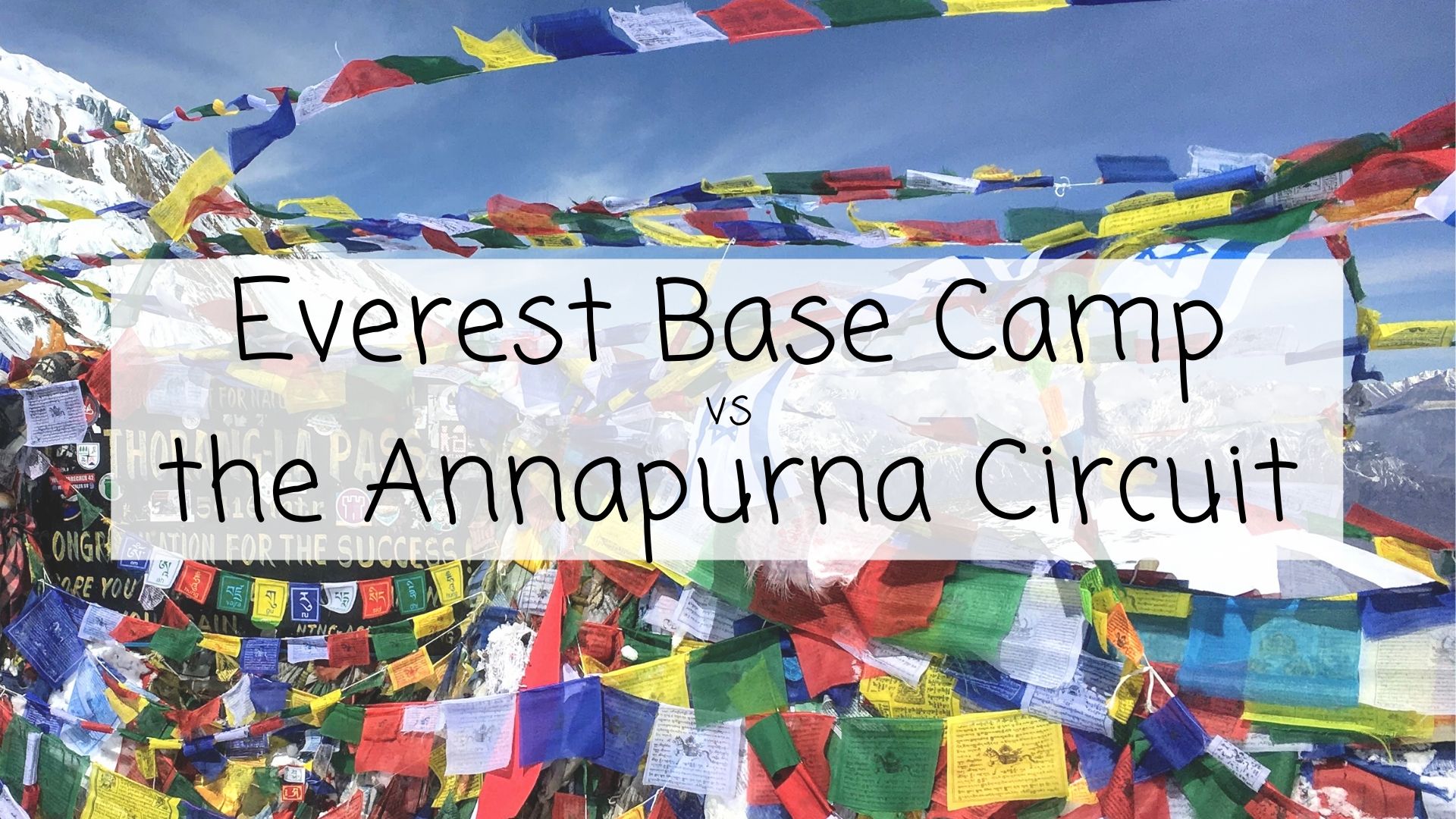
The Annapurna Circuit trek and Everest Base Camp trek in Nepal are two bucket-list hikes that take you through the Himalayan mountain range. Both take 2-3 weeks of village to village trekking to complete. For people traveling to Nepal for less than a month, it can be a grueling choice to pick just one trek: the Annapurna Circuit or Everest Base Camp.
Both the Annapurna Circuit and Everest Base Camp take you on incredible, challenging journeys through the tallest mountains in the world, and both will leave you breathless (literally and figuratively).
I hiked both during a two-month stay in Nepal and good part is, you can’t go wrong with either trek. You will absolutely adore whichever trek you choose.
Here’s a run-down that puts these two iconic treks side by side so you can decide for yourself which is better for you: the Annapurna Circuit vs Everest Base Camp Trek .
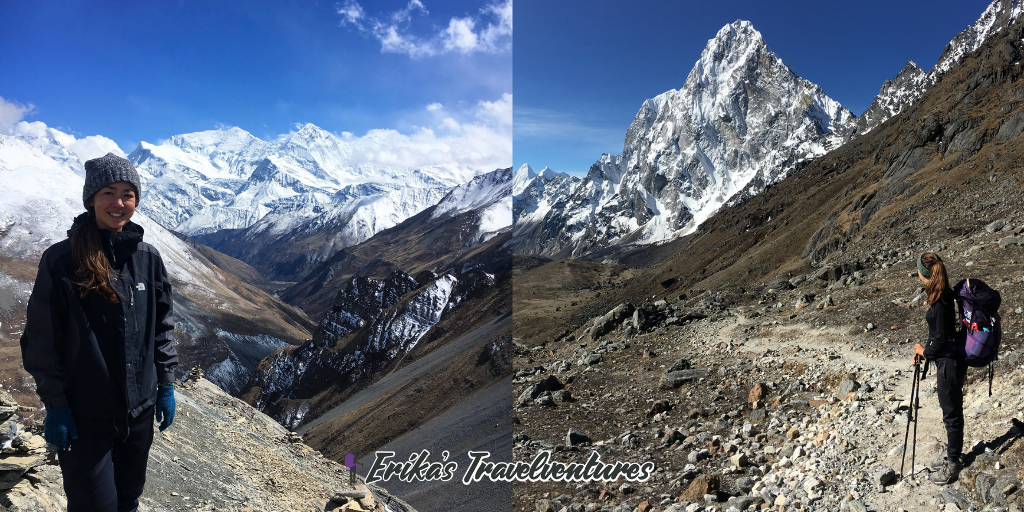
Annapurna Circuit vs Everest Base Camp: General Information
Best time to visit .
The best time to visit both the Annapurna Circuit and Everest Base Camp is during the shoulder months of March-May, and October-November . These months are considered the best time for trekking because of nice weather and clear views of the Himalayas.
The monsoon season in Nepal occurs between June-August, and snow blocks many of the trails and passes between December-February.
Number of Days to Complete
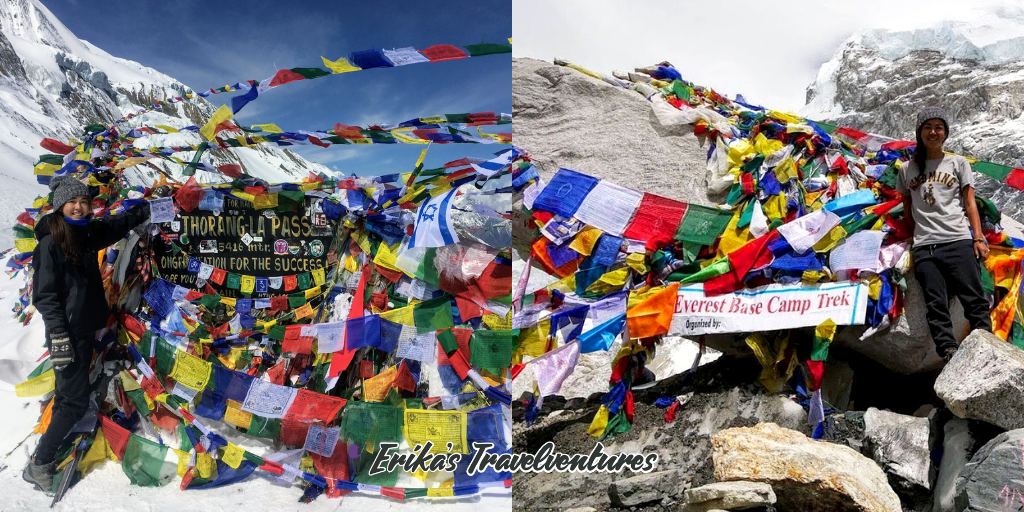
Whether you choose the Annapurna Circuit or Everest Base Camp, check out my trekking in Nepal Packing List !
How i compare the annapurna circuit vs everest base camp.
These are the categories that I’ll explain in more detail, comparing the Annapurna Circuit vs Everest Base Camp treks. Details about the Annapurna Circuit I’ve written in blue.
- Accessibility
- Comfort/Facilities
- Cultural Experiences
- Itinerary Certainty
- Navigability
- Prowess (bragging rights)
1. Accessibility - Annapurna Circuit vs Everest Base Camp
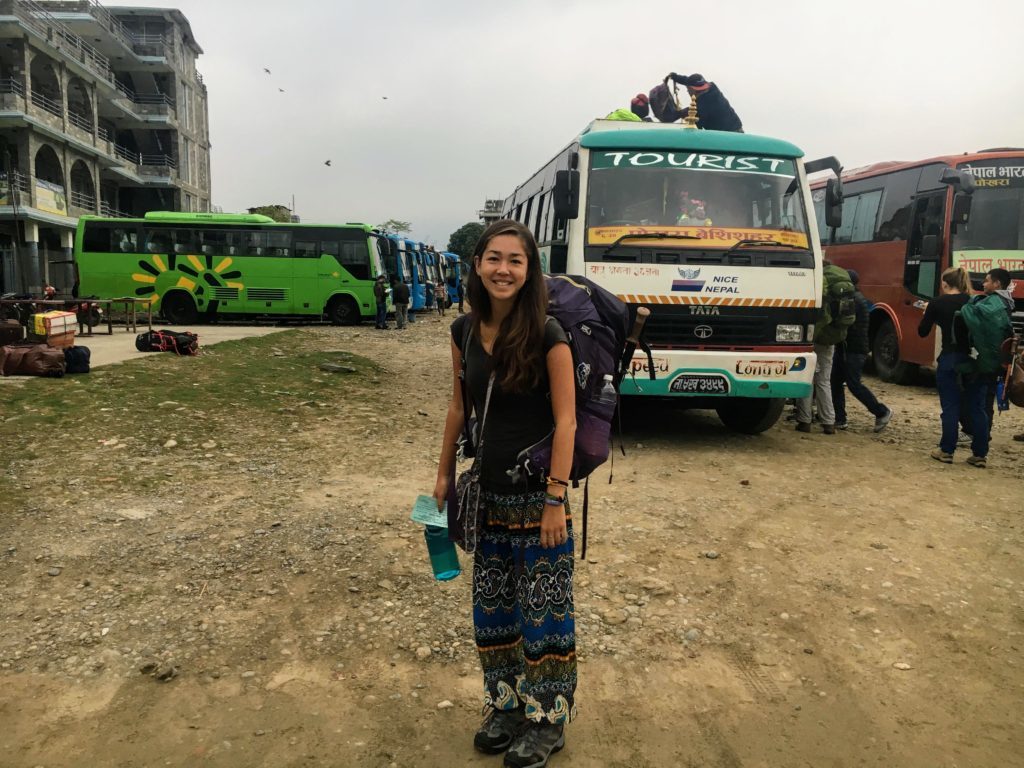
Annapurna Circuit
Getting To : Besisahar village is the official start of the Annapurna Circuit . It’s located 5 hours by local bus from Pokhara, and a similar distance by bus from Kathmandu.
Getting From : On the way back, take a bus or a taxi from Nayapul, the end of the Annapurna Circuit, to Pokhara. It takes less than 3 hours.
Many villages along the Annapurna Circuit can be accessed by a jeep road that has recently been built. If you’re on a tight schedule, you can jeep up the trail and skip a few days of trekking. On the way back you can also catch a flight, jeep, or bus from Jomsom to Pokhara.
Everest Base Camp
Getting To and From : the Everest Base Camp Trek starts from Lukla, home to a tiny airport that you reach by flight from Kathmandu. Flights are weather-dependent and are often cancelled.
You can also take a 10-hour jeep from Kathmandu to Salleri and spend three days walking to Lukla. You can also bus 9 hours to Jiri and spend five days walking to Lukla. On the way back, do the same thing all over again.
In terms of accessibility, it is much easier, and cheaper, to reach the Annapurna Circuit vs Everest Base Camp. The Annapurna Circuit is more accessible than EBC.
Annapurna Circuit 1 vs Everest Base Camp 0
2. comfort/facilities - annapurna circuit vs everest base camp.
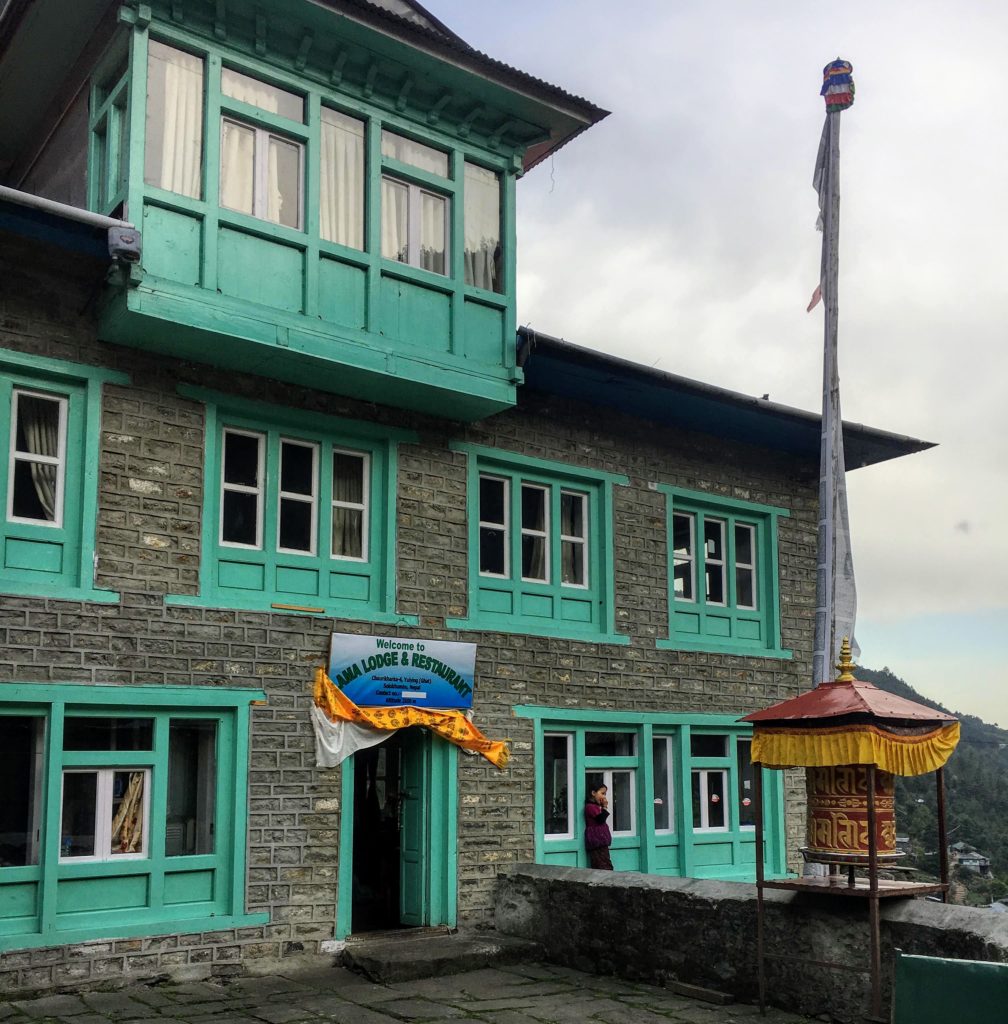
The Everest Base Camp trek is more commercialized. You’ll find many large, brick lodges with dozens of rooms, and with several staff members available to take care of guests.
Annapurna Circuit 1 vs Everest Base Camp 1
3. cost of the annapurna circuit vs everest base camp.
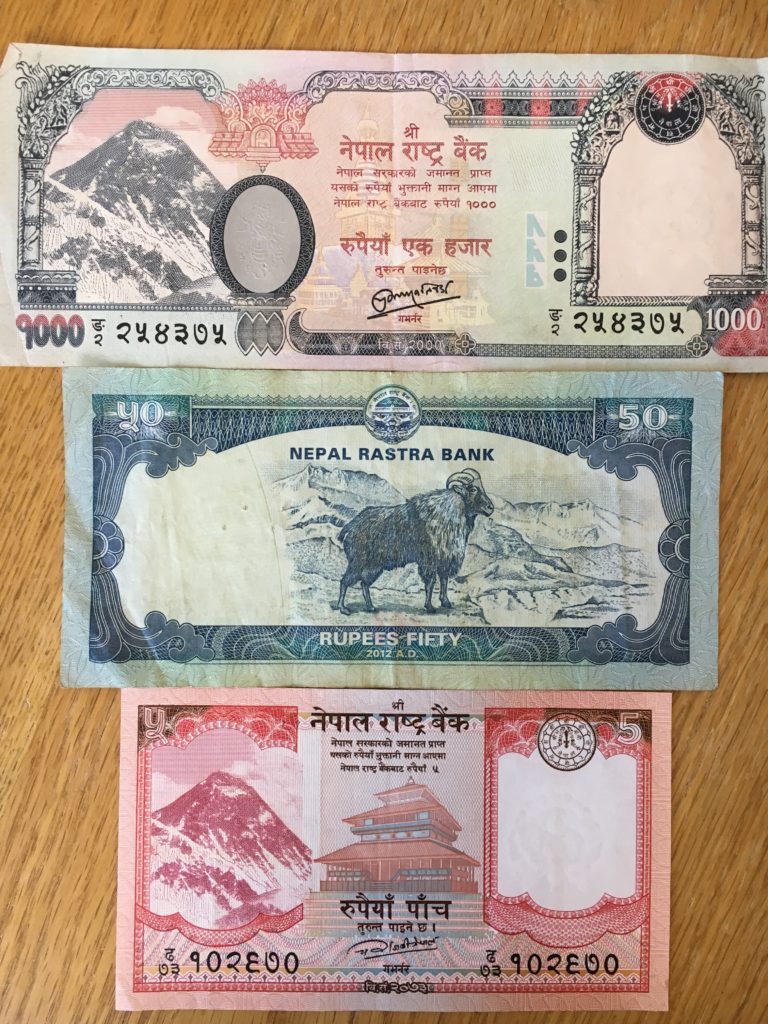
The cost for the Annapurna Circuit vs Everest Base Camp can be broken down into several categories. Here’s a breakdown:
- AC: 4300 rupees ($43)
- EBC: 5390 rupees ($54)
- AC: 150 rupees to 600 rupees
- EBC: 300 rupees to 800 rupees
- AC: free to 200 rupees
- EBC: 100 to 500 rupees
- AC: 500 rupees bus + 200 rupees bus = 700 rupees ($7)
- EBC: $320 flight OR $15 jeep there and back OR $10 bus there and back = $320
- EBC: 300 rupees, 500 rupees, 600 rupees = $$
All-in-all, I spent $250 over 13 days on the Annapurna Circuit Trek, averaging $19/day . In the Everest Region I spent over $700 in 25 days, or $28/day . (25 days because I hiked the Three Passes Trek route instead of just to EBC)
The Annapurna Circuit is much cheaper than the Everest Base Camp trek.
If saving money is extremely important to you, this is probably as far as you need to read in this article comparing the Annapurna Circuit vs Everest Base Camp. I’ll transfer you over to my Ultimate Guide to the Annapurna Circuit Trek .
Annapurna Circuit 2 vs Everest Base Camp 1
4. crowds - annapurna circuit vs everest base camp.
Who might find this important: Trekkers who enjoy being in the wilderness on their own, who get irritated when waiting in queues or to pass slow-walking trekkers. Others may feel safer if they are surrounded by other trekkers.
View this post on Instagram “Nothing behind me, everything ahead of me, as is ever so on the road” ~ Jack Kerouac . A post shared by Erika's Travelventures (@erikavtv) on Apr 25, 2018 at 4:40am PDT
Annapurna Circuit – Quiet, then crowded around the Thorong La Pass, then quiet again
- At the beginning of the trek, a lot of distance is covered each day, so the trekkers are few and far between.
- At the middle of the Circuit around Chame and Upper Pisang villages, the trail starts to get crowded. The elevation spikes here cause bottlenecks, because you’re covering short but strenuous distances.
- The most crowded sections on the AC are near Thorong Pedi, on Pass Day when everyone departs for Thorong La Pass at the same time, and at Muktinath’s pilgrimage site.
- After the transportation hub of Jomsom, the trail is quiet again because many people choose to fly or catch a bus or jeep back to Pokhara.
The Everest Base Camp Trek, vs the Annapurna Circuit, is overflowing with tour groups.
- If you start trekking from Jiri or Salleri, you can experience the calm before the storm. You’ll stay in local villages, meet few trekkers, and donkeys bringing goods to the mountain villages.
- From Lukla, comes the storm. For trekkers who fly into Lukla, their entire EBC trek will be crowded. There are tour groups after tour groups sharing the trail, as well as many yak and donkey trains.
- When you reach the finish line, Everest Base Camp, be prepared to push your way through the crowd to snap a picture.
- Since the EBC trek is one way up, and the same way down, you’ll meet the same crowds on the way down right, up until the end of the trek.
Annapurna Circuit 3 vs Everest Base Camp 1
5. cultural experiences - annapurna circuit vs everest base camp.
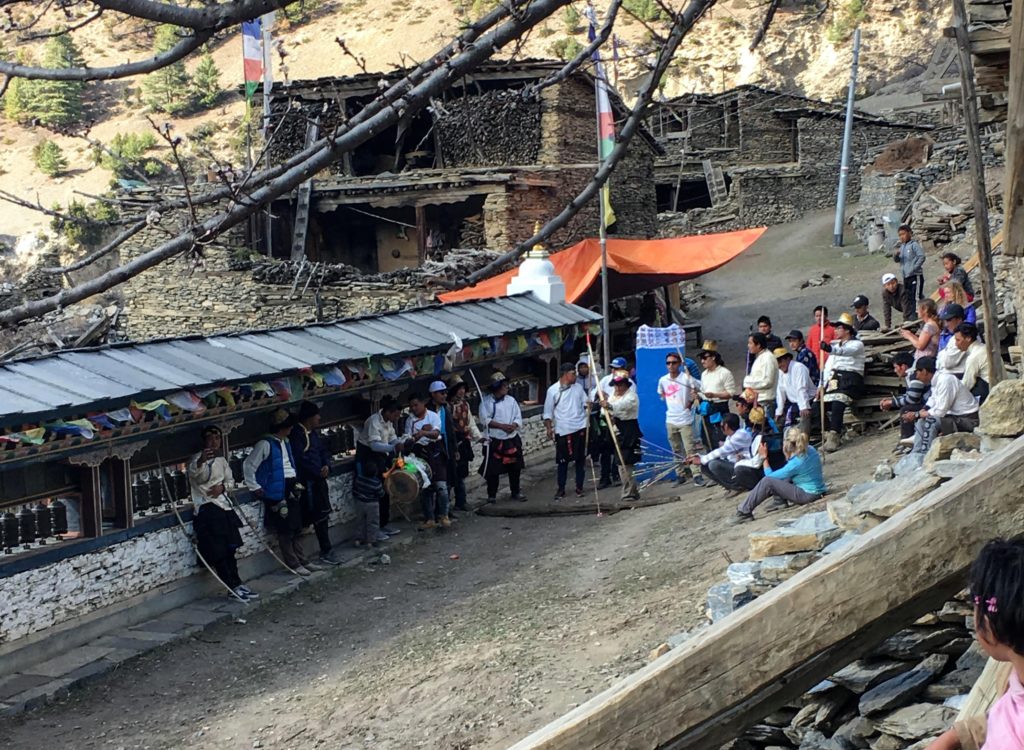
The great thing about both the Annapurna Circuit and Everest Base Camp treks is that you will are in a region that has been inhabited for centuries. You can experience what it’s like to live as a villager in the mountains.
- In Upper Pisang on the Annapurna Circuit, there was a Tibetan archery festival.
- In Thame, a village just outside of Namche Bazaar on the Three Passes Trek (you won’t pass through here on just EBC), I saw a Sherpa festival with traditional music and dancing.
View this post on Instagram Three Passes Trek Day 20: We were lucky enough to be passing through Thame during the once a year Sherpa festival, which took place in the Thame Monastery. There were music and dance performances by the monks and sherpas, plus free tea for those who brought a cup with them! A post shared by Erika's Travelventures (@erikavtv) on May 25, 2018 at 7:23pm PDT
I felt like a friend on the Annapurna Circuit, vs on the Everest Base Camp trek I felt like a customer.
If you want to interact with the locals and experience local nepali life, spend time on the annapurna circuit. , annapurna circuit 4 vs everest base camp 1, 6. difficulty of the annapurna circuit vs everest base camp.
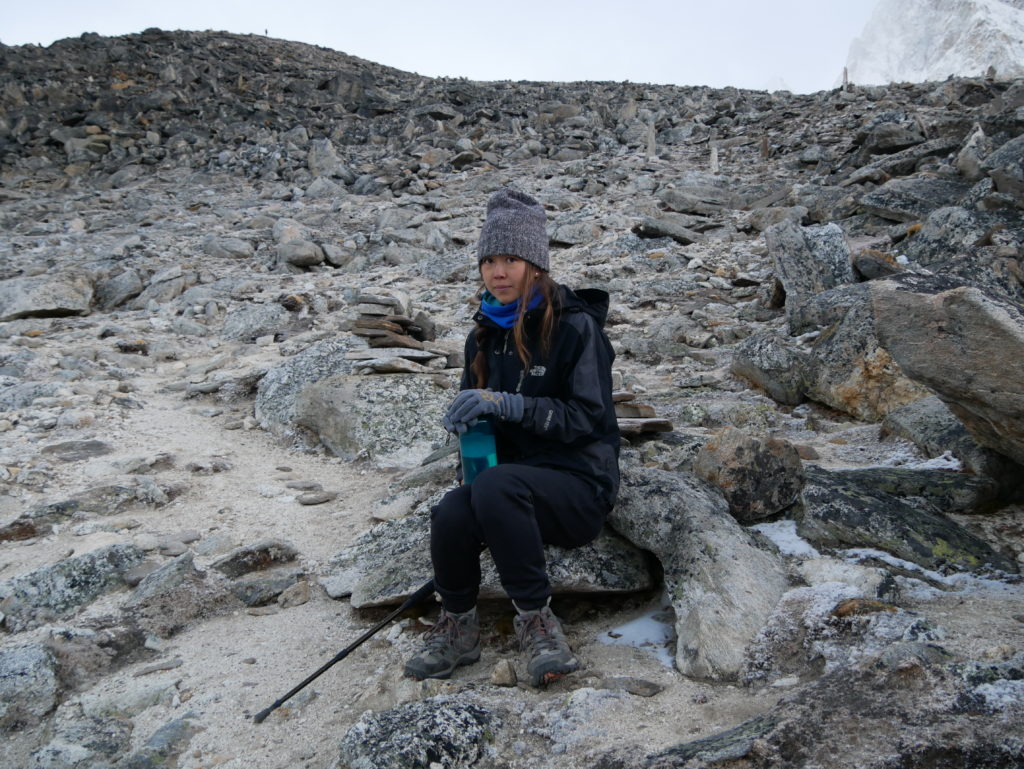
(Tie!) Annapurna Circuit 5 vs Everest Base Camp 2
7. itinerary certainty: annapurna circuit vs everest base camp.
Who might find this important: Trekkers who have a flight out of Kathmandu already purchased, and are planning on trekking right up until the day before their flight. Also people who want to be in complete control over their itinerary and their time in the mountains.
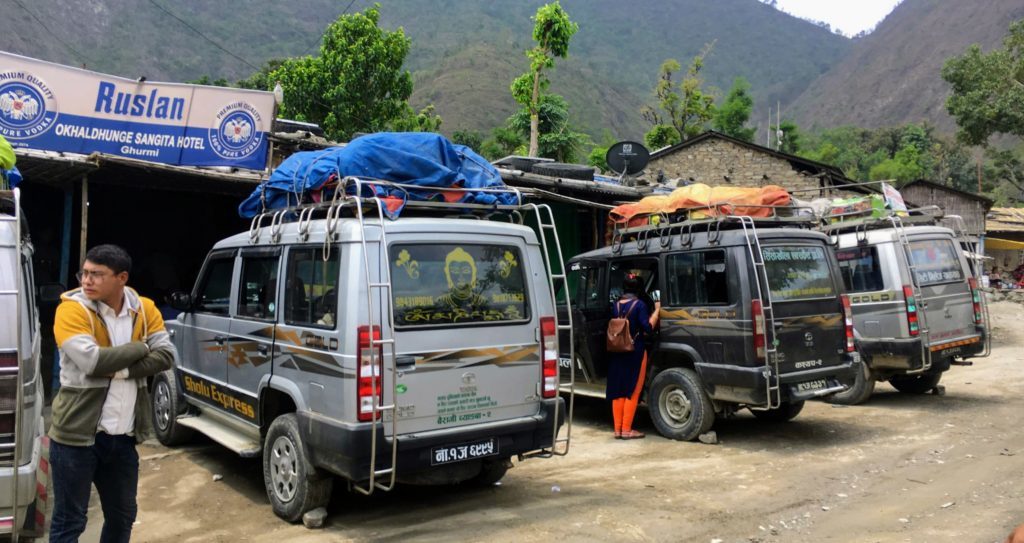
Bad weather could ruin your plans in an instant, cancelling flights to and from Lukla. This is not an uncommon occurrence, and if your flight is cancelled you’re not necessarily put at the top of the list for the next flight . Many people have been stranded one extra night in Kathmandu or Lukla because of the weather. I’m sure international flights have been missed as a result of this also.
Annapurna Circuit 6 vs Everest Base Camp 2
8. landscapes on the annapurna circuit vs everest base camp.
Who might find this important: Photographers who want to capture a variety of landscapes, not just mountains, while trekking. Trekkers who find value in experiencing different colored scenery, flora and fauna, and villages each day.
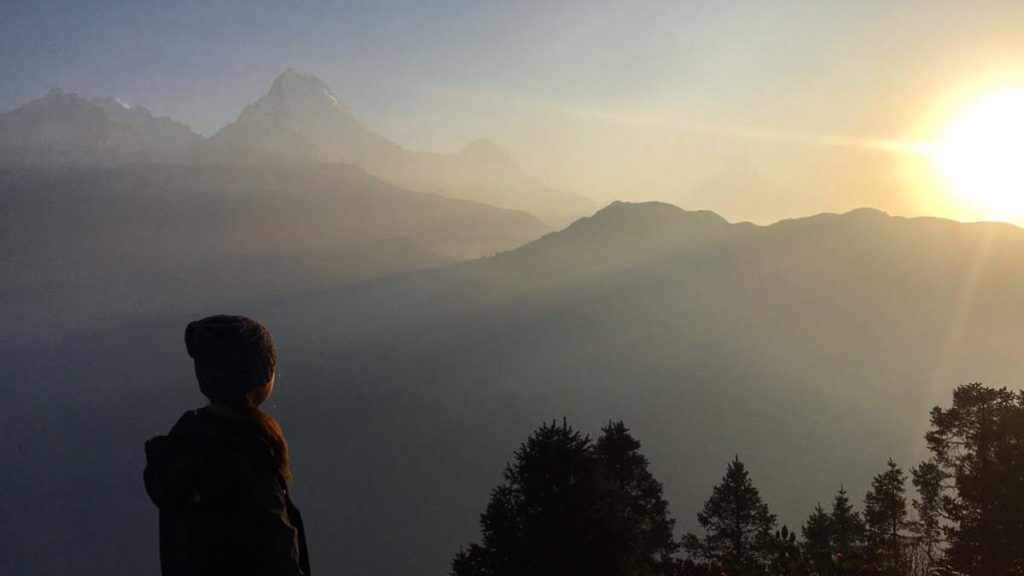
The Everest Base Camp region also starts with greenery around Lukla (even more from Jiri and Salleri). While there is a major river here, you won’t see much of it until you cross over the bridge to get to Namche.
The villages are filled with white and blue or green painted guesthouses. Namche Bazaar is the biggest gem in the jewelry box, with all the blocky buildings huddled in the small valley.
After Namche Bazaar the terrain starts to get rockier, the views gray and white, as you pass up above the tree line. The mountains are very in-your-face as you walk on gravel from old glaciers and around big boulders.
My Personal Preference: Annapurna Circuit
Because I felt the Annapurna Circuit had more variety in colorful scenery, villages, and terrain , I think the point here goes to the Annapurna Circuit vs Everest Base Camp.
However, the view from the top of Kala Patthar near EBC makes it a close one to call. If you are trekking in Nepal looking for the biggest, baddest mountains and nothing more though, EBC may be your best choice.
Annapurna Circuit 7 vs Everest Base Camp 2
9. navigability - annapurna circuit vs everest base camp.
Who might find this important: People who are ‘directionally-challenged’ or have extra concerns about getting lost.
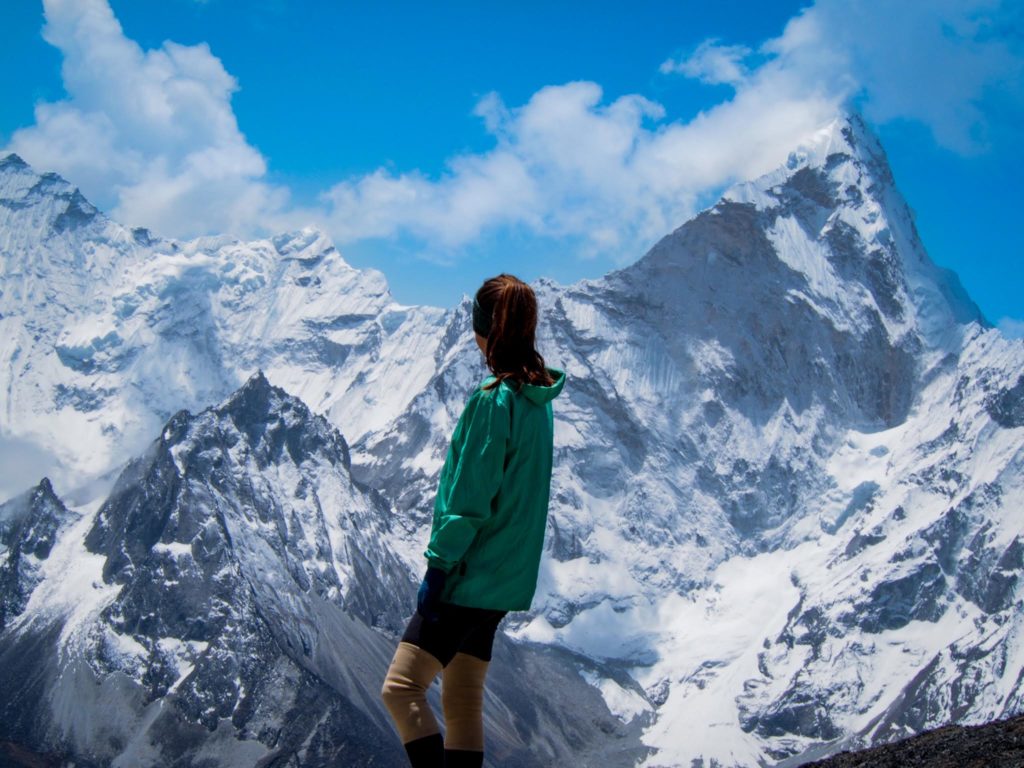
Annapurna Circuit 7 vs Everest Base Camp 3
10. prowess (bragging rights) - annapurna circuit vs everest base camp.
Who might find this important: Travelers who are interested in seeing the best, the first, the TALLEST attractions when they travel. Influencers who want to impress their followers with big-name adventures and accomplishments.
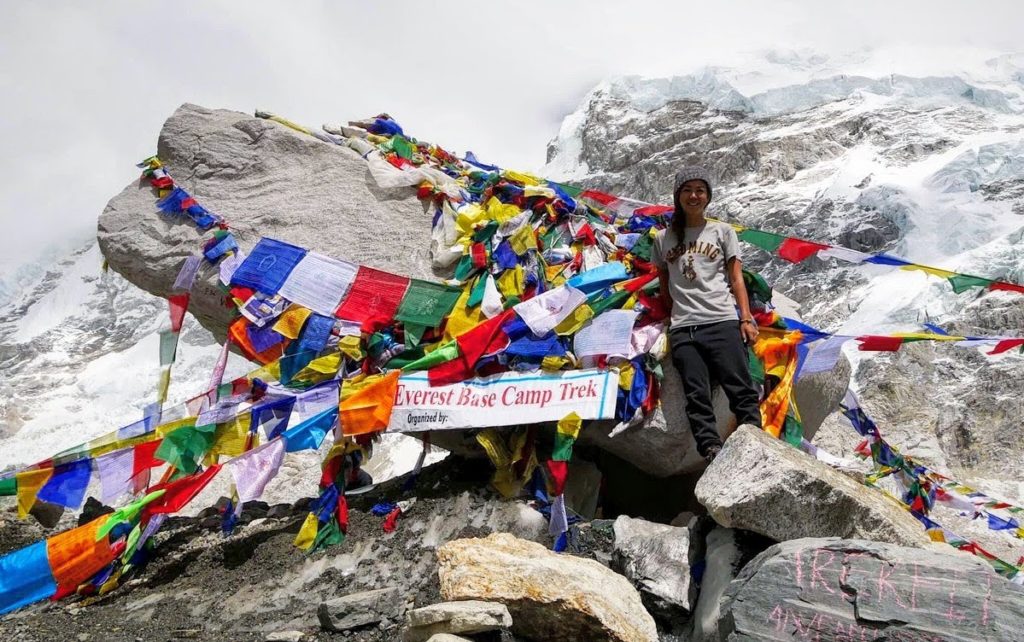
When you tell your friends at home that you completed the Annapurna Circuit in Nepal, you might get a lot of ‘huh?’s. Everyone knows Everest however, and are bound to be impressed by the fact you were in the presence of the tallest mountain in the world.
Everest Base Camp is a bucket list item for many, vs the Annapurna Circuit seems to be an afterthought.
If you’re in Nepal to wow others and check off bucket list destinations, get yourself to the Everest Region!
Annapurna Circuit 7 vs Everest Base Camp 4
11. safety on the annapurna circuit vs everest base camp.
View this post on Instagram Don’t look down - the Annapurna Circuit requires you to cross a dozen suspension bridges, some safer feeling than others, but all with gaps beneath your feet so you can peer into the raging river or abyss below you A post shared by Erika's Travelventures (@erikavtv) on Apr 26, 2018 at 6:53am PDT
If something goes wrong, you can be flown and driven out of the mountains faster from the Annapurna Circuit than Everest Base Camp. In my book, that makes the Annapurna Circuit a safer option than Everest Base Camp.
Annapurna Circuit 8 vs Everest Base Camp 4
Read my ultimate guides for the Annapurna Circuit or the Three Passes Trek (plus Everest Base Camp) for more in-depth tips on how to stay safe in the mountains.
Make sure to purchase insurance before you leave for the Himalayas! It’s especially important to get insurance that will cover high-altitude evacuations!!
12. side treks - annapurna circuit vs everest base camp.
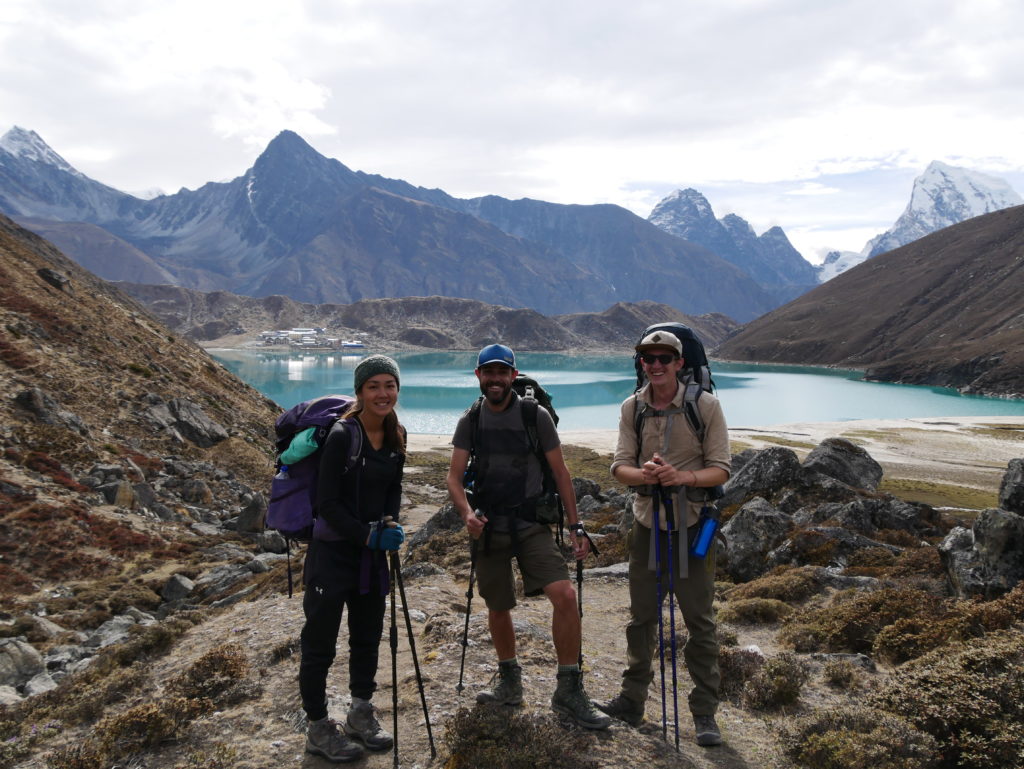
View this post on Instagram Annapurna Circuit Day 8: Detoured with the Yak Pak (the crew I’ve been trekking with since Tal) to Kagbeni, a picturesque oasis in the middle of a windy wasteland! A post shared by Erika's Travelventures (@erikavtv) on Apr 16, 2018 at 6:20am PDT
Everest Base Camp’s famous side trek is to Kala Patthar , a summit at 5550m. From here, you can look over at mighty Everest herself, as well as many of the most impressive mountains in the world.
Annapurna Circuit 8 vs Everest Base Camp 5
I didn’t even mention the Three Passes Trek in the Everest Region! (EBC is more of a side trek from the Three Passes Trek, not the other way around) If you take into account the incredible experiences on this 20+ day trek, the Everest Base Camp region is much better than the Annapurna Circuit in terms of side treks.
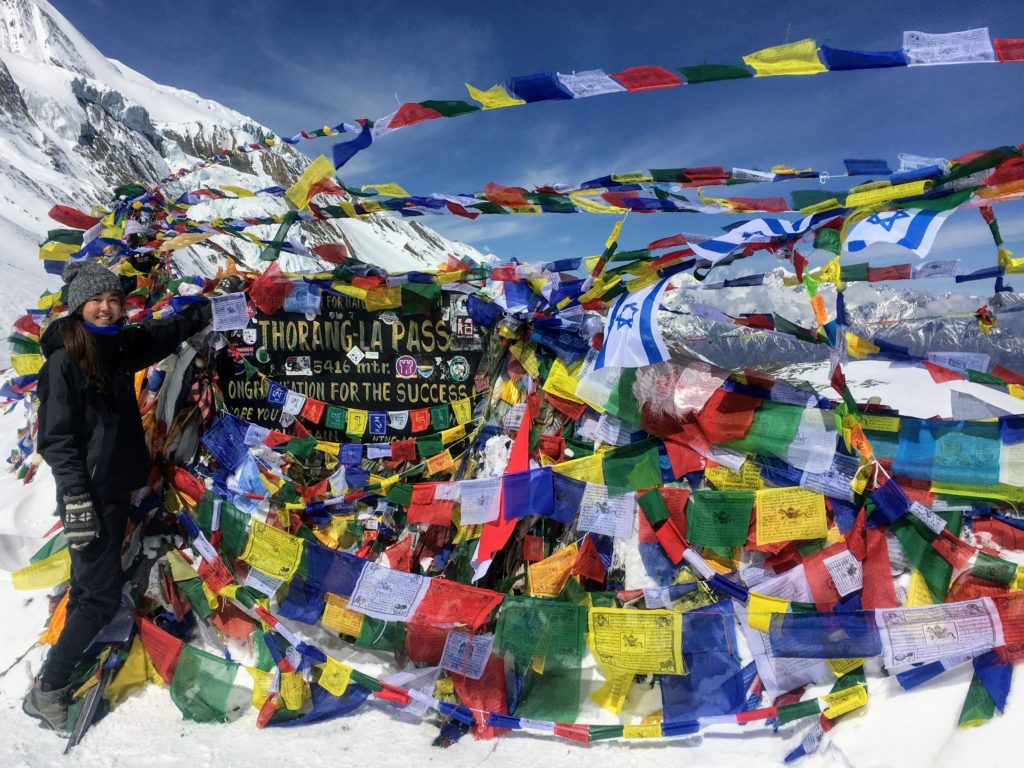
Here are the winners (in my opinion only!) for each category.
Annapurna Circuit vs Everest Base Camp (Final Results)
- Accessibility – Annapurna Circuit
- Comfort/Facilities – Everest Base Camp
- Cost – Annapurna Circuit
- (Fewer) Crowds – Annapurna Circuit
- Cultural Experiences – Annapurna Circuit
- Difficulty – Tie! Annapurna Circuit and Everest Base Camp
- Itinerary Certainty – Annapurna Circuit
- Landscapes (Instagram-worthiness) – Annapurna Circuit
- Navigability – Everest Base Camp
- Prowess (bragging rights) – Everest Base Camp
- Safety – Annapurna Circuit
- Side Treks – Everest Base Camp
Final Score: Annapurna Circuit 8 vs Everest Base Camp 5
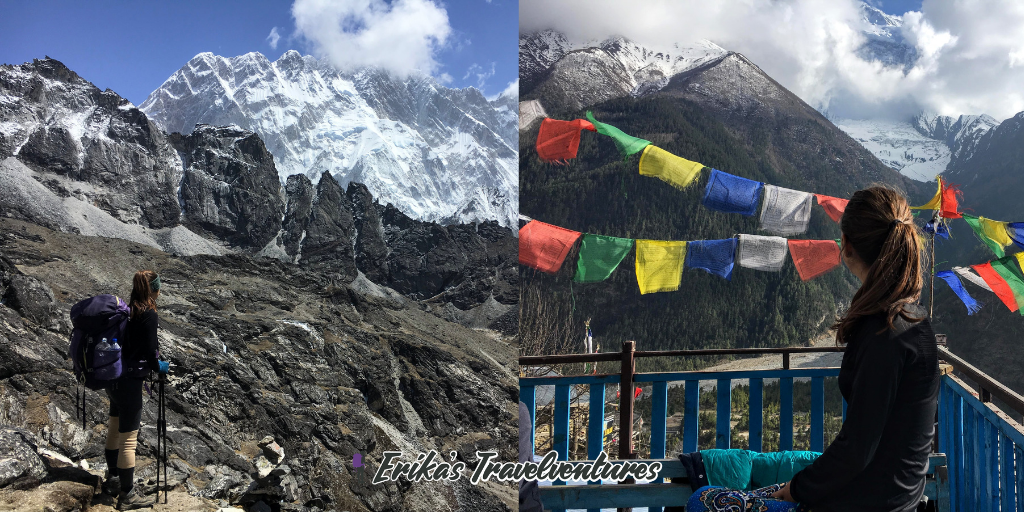
Decided between Everest Base Camp vs Annapurna Circuit? Read my other posts about Nepal !
- The Perfect Trekking in Nepal Packing List
- 20 Things to Know Before Trekking to Everest Base Camp
- Kala Patthar: The Side Trek from Everest Base Camp NOT to Miss!
- Annapurna Circuit Blog and Itinerary
- Ultimate Guide to the Annapurna Circuit Trek
- Check out the vlog from Intrepid Road about the Annapurna Circuit and Three Passes Trek!
Pin this Post: Annapurna Circuit vs Everest Base Camp!
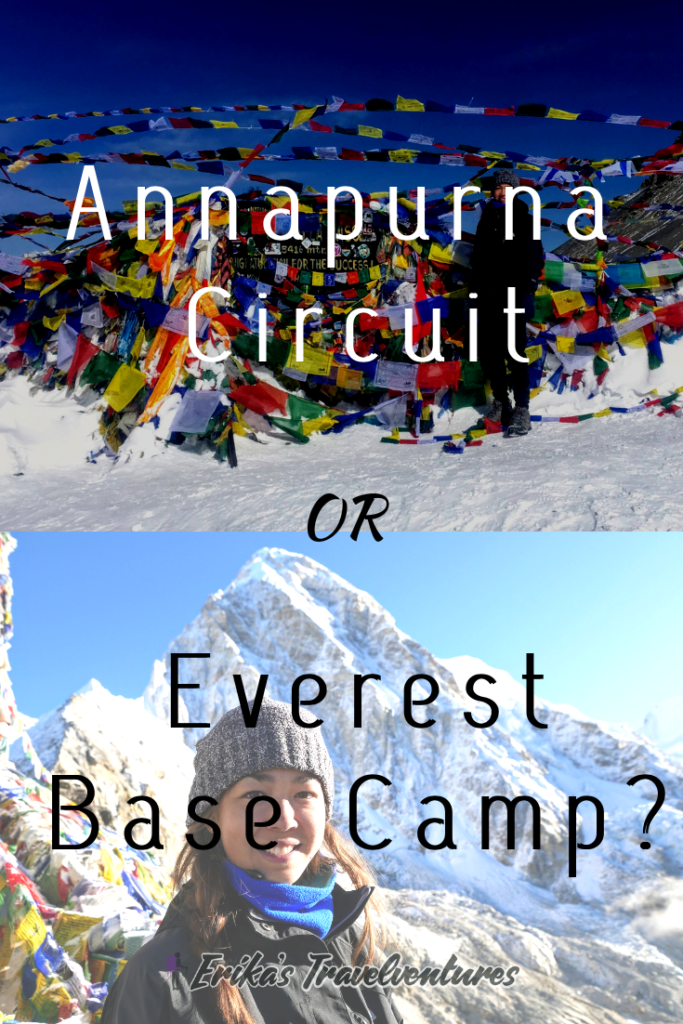
You might also like:
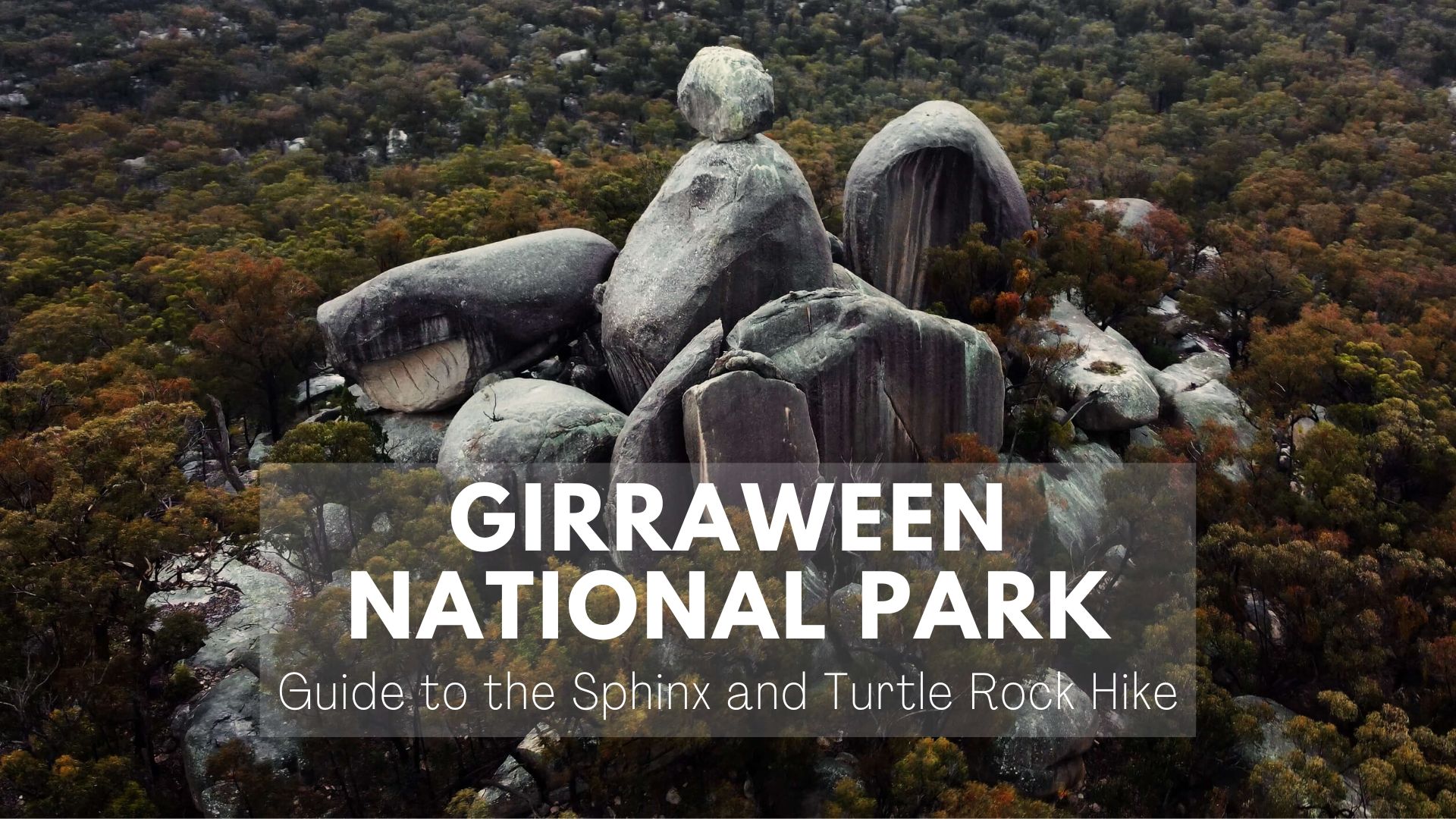
Turtle Rock and The Sphinx Hike at Girraween National Park
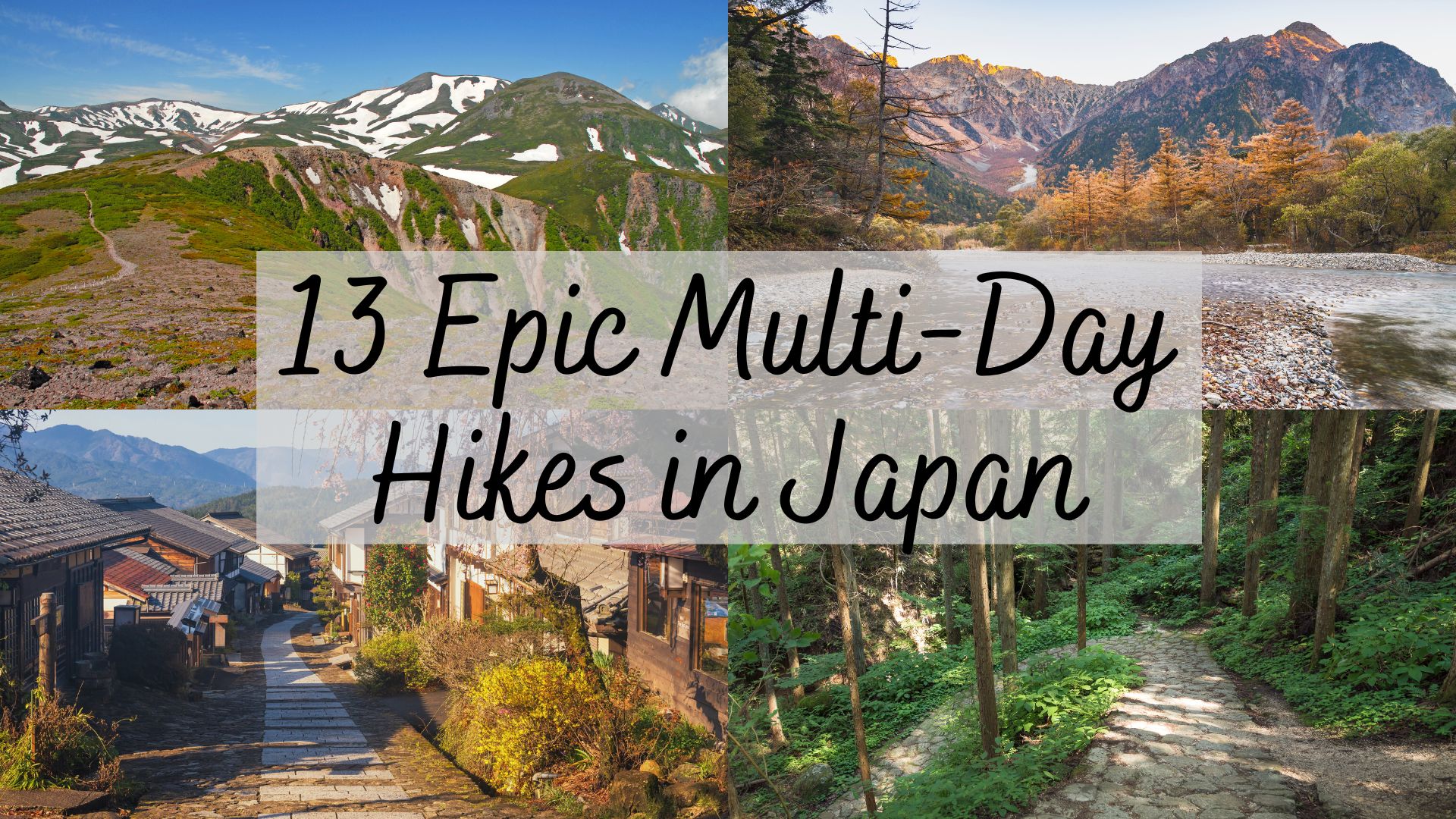
13 Best Multi-Day Hikes in Japan
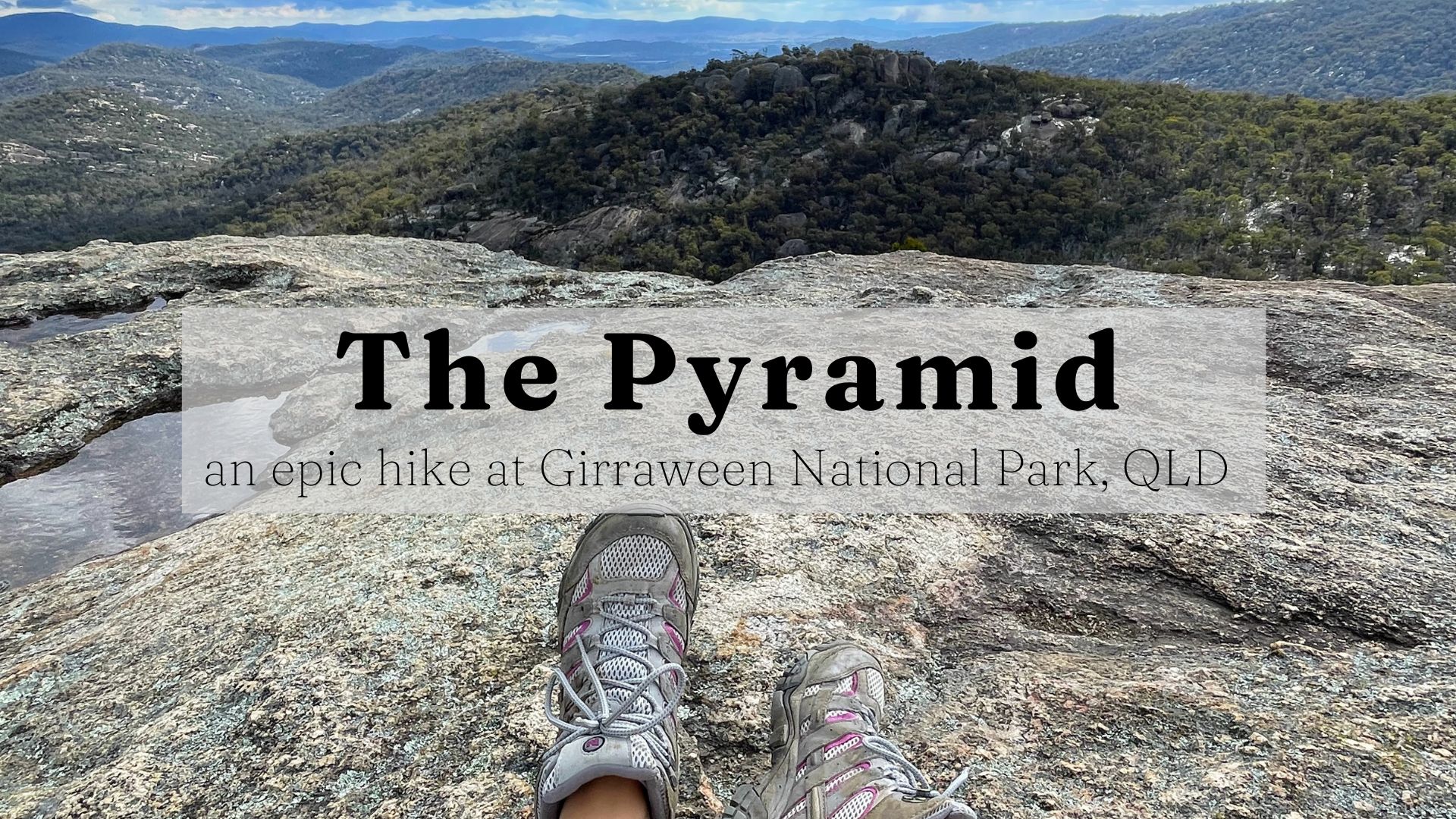
Guide to Hiking the Pyramid at Girraween National Park
0 thoughts on “ annapurna circuit vs everest base camp – which should you trek in nepal ”.
Awesome post! When you referred to the three passes, is Gokyo Ri part of it. I am contemplating to do it with friends next year but was torn between Annapurna and EBC. The photos I saw of Gokyo Ri side tracks are captivating!
Hi Chris! Yes, Gokyo Ri is part of the Three Passes Trek, which basically makes a circuit around the Everest Region instead of just going to Base Camp and back. If you are deciding between the Annapurna Circuit and the Three Passes Trek, I would definitely recommend the Three Passes Trek if you have time! Here’s a link to my blog post about it: https://erikastravelventures.com/ultimate-guide-to-the-three-passes-trek-everest-base-camp/ My friend made a vlog about it too: https://www.youtube.com/playlist?list=PLqQGefiR3AwFvj1u50wcmDvS-TYRWB1he
Leave a Reply Cancel reply
Your email address will not be published. Required fields are marked *
- Base Camp Trip

+977 98-430-35-522
Choosing Your Himalayan Adventure: Everest Base Camp Trek vs. Annapurna Base Camp Trek
Heading to the Himalayas for a trek is an amazing adventure. Two popular treks in Nepal are the Everest Base Camp Trek (EBC) and the Annapurna Base Camp Trek (ABC) . While both are incredible journeys, they have differences. In this comparison, we’ll help you understand them better so you can pick the right one for you.
Key Differences between Everest Base Camp trek and the Annapurna Base Camp trek
Scenery: The Everest Base Camp trek is all about towering mountains like Everest and Lhotse. You’ll walk through Sherpa villages and see ancient monasteries amidst rugged landscapes. On the other hand, the Annapurna Base Camp trek offers varied views, from lush forests to high mountains like Annapurna and Machhapuchhre . You’ll also pass through lovely villages.

The Everest Base Camp trek is synonymous with jaw-dropping mountain views, featuring the world’s highest peaks, including Mount Everest (8,848 meters), Lhotse (8,516 meters), and Nuptse (7,861 meters). Trekkers traverse through the rugged terrain of the Khumbu region, passing through Sherpa villages, ancient monasteries, and dramatic glacial moraines. The landscape is characterized by towering peaks, deep valleys, and pristine alpine lakes, offering unparalleled vistas at every turn. On the other hand, the Annapurna Base Camp trek showcases a diverse array of landscapes, from lush rhododendron forests and terraced fields to rugged mountain terrain and high-altitude glaciers. Trekkers are treated to panoramic views of the Annapurna massif, including Annapurna I (8,091 meters), Annapurna South (7,219 meters), and Machhapuchhre (6,993 meters). The route passes through charming Gurung and Magar villages, providing cultural insights and picturesque settings against the backdrop of majestic mountains.
Difficulty: The Everest trek is tougher because of higher altitudes and rough trails. You’ll climb really high and might feel altitude sickness. The path has steep climbs and tricky passes. The Annapurna trek is a bit easier. While it’s still a challenge, the altitudes are lower, and the trail is gentler. But you’ll still need to be fit.
Both treks present unique challenges, but the Everest Base Camp trek is generally considered more strenuous due to its higher altitude and more rugged terrain. Trekkers ascend to altitudes above 5,000 meters, facing acclimatization issues and harsh weather conditions. The trail includes steep ascents, rocky paths, and high mountain passes, such as the renowned Cho La Pass and Kala Patthar viewpoint. Altitude sickness is a common concern, requiring careful acclimatization, physical fitness, and proper hydration.

Comparatively, the Annapurna Base Camp trek is slightly less demanding in terms of altitude and overall difficulty. Trekkers ascend to altitudes around 4,130 meters, with more gradual ascents and descents along the route. The trail is well-established, with fewer technical challenges and a lower risk of altitude-related illnesses. However, trekkers still need a moderate level of fitness to tackle the long days of walking and occasional steep sections.
Cultural Experience: Both treks let you experience Himalayan culture. In Everest, you’ll meet Sherpa people, visit Buddhist monasteries, and see prayer flags. In Annapurna, you’ll encounter Gurung and Magar communities, enjoy local hospitality, and witness traditional ceremonies.
Both treks offer rich cultural experiences, allowing trekkers to immerse themselves in the local way of life and traditions of the Himalayan region. Along the Everest Base Camp trek, trekkers pass through Sherpa villages adorned with prayer flags, intricately carved mani stones, and Buddhist monasteries. The Sherpa people, known for their hospitality and mountaineering prowess, welcome trekkers with warm smiles and traditional Sherpa tea.
Cultural highlights include visits to Tengboche Monastery, the largest Buddhist monastery in the Khumbu region, and interactions with local Sherpa families. Similarly, the Annapurna Base Camp trek takes trekkers through traditional Gurung and Magar villages, where ancient customs and rituals are still practiced. Trekkers have the opportunity to stay in local teahouses, sample authentic Nepali cuisine, and participate in cultural ceremonies. Highlights include visits to Ghandruk, a picturesque Gurung village with stunning mountain views, and interactions with local villagers along the trail.
Sure, here’s a comparison of the Everest Base Camp trek and the Annapurna Base Camp trek in tabular form:
Both treks offer incredible experiences in the Himalayas, but they cater to different preferences and fitness levels. Consider your priorities and choose the trek that aligns best with your interests and abilities.
Deciding between Everest Base Camp and Annapurna Base Camp Trek depends on what you’re looking for. If you want Epic Mountain views and are ready for a tough trek, go for Everest. If you prefer a mix of landscapes, a slightly easier trek, and diverse cultural experiences, Annapurna might be the one for you. Either way, both treks promise unforgettable adventures in the Himalayas.
Please Follow Us For more Updates :
Instagram : Base Camp Trip
Facebook : Base Camp Trip
Website : Base Camp Trip
Comment (0)
Leave a comment cancel reply.
Your email address will not be published. Required fields are marked *
Lastest News
Learn More About Tours
- Uncategorized
- 18 Mar 2024
A Deep Dive into the Flora and Fauna Along the Annapurna Base Camp Trek
As you stand at the trailhead of the Annapurna Base Camp trek, surrounded by towering peaks and lush valleys, you’re on the threshold of an adventure unlike any other. Beyond the physical challenge and the breathtaking vistas lies a hidden world of biodiversity waiting to be discovered. Nepal’s Annapurna region isn’t just a destination for […]

- 15 Mar 2024
Solo Trekking vs. Group Trekking: A Detailed Comparison
Trekking, whether solo or in a group, offers unparalleled opportunities for adventure, self-discovery, and connection with nature. However, each approach comes with its own set of advantages and disadvantages. Deciding between solo trekking and group trekking depends on various factors, including personal preferences, experience level, safety considerations, and the nature of the trek itself. Let’s […]

- 01 Mar 2024
How Safe Is Everest Base Camp Trek?
Imagine yourself standing in the magnificent Himalayas, with breathtaking beauty and excitement everywhere you turn. However, before embarking on your thrilling trek towards Everest Base Camp, it’s natural to ask yourself: is it secure? The guide below will look at precisely this the security of the Everest Base Camp Trek. We’ll discuss the risks and dangers, and more […]
Select User Type
Enter the e-mail address associated with the account. We'll e-mail a link to reset your password.

Alpha Adventure Treks
Your Perfect Trekking Partner

Everest Base Camp Trek VS Annapurna Base Camp Trek

Last Updated on January 21, 2022 by Alpha Adventure Treks
Most trekkers who visit Nepal for the first time hope to reach the High Mountain base camp and begin their search there. This blog compares and contrasts the treks to Everest Base Camp and Annapurna Base Camp . The Everest Base Camp Trek and the Annapurna Base Camp Trek are two of Nepal’s most well-known base camp treks.
It can be challenging for a first-time trek planner to decide whether to trek Annapurna or Everest base camp. If you travel to Nepal for the first time to trek to one of the base camps with a professional company team, you will undoubtedly return for another. You keep recalling mountain views, charming people, cultural diversity, landscape, and exceptional care, all of which entice you to return. Here we compare and contrast Everest Base Camp and Annapurna Base Camp treks so you can simply decide which base camp to visit.
Table of Contents
Trekking Duration
The trek to Annapurna Base Camp takes between 8 and 12 days. ABC trip is a standard 10-day journey that follows the traditional trekking itinerary. There is no need to remain an extra day on the way for acclimatization.
The Everest Base Camp trek takes 12 days to complete, with two days of acclimatization along the way to Everest Base Camp and Kalapathar. If you are okay with the altitude, you can perform the minimum of 11 days by skipping one day of acclimatization. You can also complete an 8-day Everest base camp trek if you take a helicopter chartered flight back to Lukla or Kathmandu after reaching EBC, but this would increase the expense of your trip.
ACCESSIBILITY:
Accessibility of everest base camp:.
There is no vehicular access to the Everest trekking start site. The only way to get there is to fly from Kathmandu to Lukla. Lukla can only be reached by tiny planes. Only morning flights will be available, and flights may be disrupted due to inclement weather.
Due to its geographical location and mountainous weather, Lukla Airport is regarded as a dangerous airport. It’s only a 35-minute journey, but Lukla’s flight cost is one of the most expensive domestic flights. If you choose for an Everest Base Camp Walk without flying to Lukla, you may expect a 20-day journey and a drive to Phaplu hamlet to begin the trek.
Accessibility of Annapurna Base Camp:
There are various methods to get to the beginning location of ABC trekking. The trek begins at Nayapool or Ulleri, both of which are accessible by car. To get to Pokhara and other destinations, one can use a private car, fly, or take regular buses. It is dependent on your financial situation. It is simpler and less expensive than EBC.
Now there is a route up to Ulleri village, which is 1,960 meters above sea level and where the first day’s overnight will be held. With a private car, the journey from Pokhara to Nayapool takes about one and a half hours. It’s possible that local buses will take two and a half hours. If you begin your journey in Kathmandu, take a morning flight to Pokhara and then drive to Nayapool or Ulleri to reach the first-day camp for an overnight stay.
Accommodation in Everest Base Camp:
The Everest region is relatively well-equipped, with adequate lodging. You can select from a variety of lodging options based on your preferences. The Deluxe Guest Houses chain has developed accommodations for six nights of the trek’s total of 11 nights.
There are just 5 nights available near Everest base camp in modest tourist class guest rooms. (Even at Everest Base Camp/ Gorakhshep, there are new hotel buildings.) You can stay in one of three categories of lodging when staying in Phakding, Namche, Dibuche, and Lukla for six nights. Normal tourist grade guest houses with adjoining toilets, warm dining, a restaurant, and a bar are still available.
A good room with a hot water bath, the hitting system within the room, good eating, restaurant, and bar are all available in the middle category of guest homes. With the same facilities, high-end hotels provide greater service. The cost of high-category lodging has a significant impact on the entire cost of your expedition.
Accommodation in Annapurna base camp:
The entire Annapurna base camp location has nearly the same level of lodging. Three nights on altitude land near base camp, with more modest lodging and shared bath/toilet facilities.
The rest of the accommodations are equipped with tourist-standard rooms located within the toilet bath. Only one night of premium star rated lodging is offered at the end of this hike in Ghandruk.
Cost of EBC Trek VS ABC Trek:
Which trek is more trustworthy and cheap when comparing the costs of EBC and ABC treks? The cost of an Everest Base Camp journey is more than the expense of an Annapurna expedition. Everest base camp trek costs more than ABC because it includes a round-trip flight from Lukla, a permit, food, and lodging.
You can save money on your Annapurna base camp hike by using local transportation. Even hiring private transportation or flying does not come close to covering the cost of climbing Everest. Both hikes have similar costs for meals and drinks along the way.
Everest Vs Annapurna Altitude:
During Kalapather ascending, you will reach a maximum altitude of 5,545 meters, and at Everest base camp, you will reach a maximum altitude of 5,360 meters. When flying from Kathmandu to Lukla, you will arrive at a height of 2,860 meters. The altitude then begins to rise every day until it reaches EBC. This is a fantastic high-altitude trek.
The Annapurna Base Camp journey begins at an altitude of 800-meters and gradually ascends to 4,200 meters at Annapurna Base Camp. You will gain less altitude each day than EBC, therefore there will be no need for an acclimatization day along the route.
Mountain you will see during Everest Base camp trek:
You will reach the heart of the mountains on both treks. From the second day of the EBC journey, you will be able to see mountains. Other ranges can be explored with two mountains exceeding 8,000 meters (Mount Everest, 8,848 meters, and Mount Lhotse, 8,516 meters). Various views of the mountains can be seen along the journey.
Almost every day on this trek, Amadablam (6,812 meters) becomes more gleaming and appealing. From Kalapathar and Gorakshep, Mt Pumori (7,161) appears to be higher and more closed. The best view is from Kalapather, which requires an early morning climb for sunrise or an evening trek for the best sunset.
Mountain View during Annapurna Base Camp:
The hike begins with a view of the peak on the first day. Ulleri provides the first vista of Annapurna south and Himchuli. The all-mountain range surrounding you on the second-day journey to Ghorepani.
This journey can take you to two summits over 8,000 meters: Annapurna I (8,091m) and Mount Dhaulagiri (8,167m). Mount Fishtail (6,993m) shines even brighter on this climb, with its best shape. The nicest mountain views in this walk may be seen at Poonhill (3,210m) and Annapurna base camp (4,200m).
Everest Vs Annapurna Best season:
Spring and autumn are the finest seasons for trekking to Everest Base Camp. The warmest months in this region are March, April, May, and September through November. The best view of the region is on sunny days with a blue sky. Even so, the months of June and December are still suitable for an Everest base camp hike. During the rainy season, the Himalayan range is mostly shrouded in fog.
The best time to trek to Annapurna base camp is during the spring and autumn months. This journey is still better ideal in the winter months of December, January, and February, despite the fact that rainy months of June to August are challenging because to sleeping paths, landslides, and leeches.

Local Peoples and Cultures:
The Everest region, as well as Annapurna base camp, are culturally rich. Sherpa homage and traditional traditions can be explored almost entirely throughout your trip to EBC. Sherpa people pay honor to the Everest region. Tibetans and Sherpas have a lot in common. Their habits and language are Tibetan-influenced. The majority of people follow the Buddhist religion. During the major celebration, you may witness the traditional rites.
The Annapurna base camp is populated by a diverse group of people. They are also Nepalese indigenous peoples. Gurung people make up a large portion of the population in this area. One of the most important Gurkha tribes. In the evenings, local people perform traditional dances with folk songs in the main villages, which is a memorable experience on this Trek.
Annapurna vs Everest Base Camp Trek Safety:
The treks to Everest base camp and Annapurna base camp are both safe. Because of the high altitude, it is necessary to trek with someone to keep an eye on you. Trekkers must have high-quality trekking equipment.
It’s also a good idea to hire a porter to carry your belongings and a guide to lead these safer hikes. Do not set out on your journey alone.
Group Joining Trek:
In both treks, a group trek is not required. It is considerably easier to customize your itinerary if you bring your own guide and porter. It is simple to alter your plan according to your preferences and circumstances. Joining a small group tour instead of trekking alone will save you money on your trip.
Alpha Adventure treks also offers a small group Everest Base Camp trek. A group trek of up to ten persons is more pleasant. When it comes to offering quality services, groups of more than ten people are not encouraged. A small group hike to Annapurna base camp is another excellent option. The benefit is that you may communicate with folks from different nations and share diverse experiences.
Communication facilities in EBC and ABC Trek:
Up to Everest base camp and Kalapathar, internet and phone signals are available. The signal is a little tough one day at Lobuche and another day at Pheriche. To use the phone and access the internet, it is preferable to purchase a Nepali sim. Only up to Namche in Ebc hiking is local telephone and internet connectivity readily available.
Similarly, for a better communication experience on ABC journey, bring your own local SIM card. There is a scarcity of local telephone and internet cyber services. The telephone signal may not reach Deurali after a two-day trip.
Everest vs Annapurna Base Camp Trek FAQs:
The Everest Base Camp trek is more challenging than the Annapurna Circuit trek since it is a much longer route overall.
Annapurna is a somewhat less difficult circuit if you’re doubtful of your mountaineering abilities. The average altitude is substantially lower, and there are less hard climbs. You can also choose from a number of pathways, some of which do not surpass 2000 meters in altitude, rather than being funneled into the Khumbu Valley on Everest.
When compared to Everest Base Camp, Annapurna Base Camp is far more affordable for budget-conscious trekkers. The reasons are threefold: the location, the cost of transportation, and the time it takes to get there. Getting to the ABC trailhead is substantially less expensive in terms of transportation because it is accessible via roadway.
The journey to Annapurna Base Camp is not regarded difficult because it is highly adventurous and the main components of the trip are to walk slowly and carefully. As a result, this journey is classified as moderate.
The Annapurna Base Camp Trip is not the most expensive trek in Nepal due to its typical time and difficulty. Prices range from 700 USD to 1000 USD (600 EUR to 900 EUR).
Nowadays, commercial operators charge a wide range of rates for climbing Mount Everest, but a guided trip with bottled oxygen on the south side will cost roughly US$45,000, and on the north side would cost around $35,000. However, this is a broad average.
Feel Free To Contact Us
Share this:.
- Click to share on Twitter (Opens in new window)
- Click to share on Facebook (Opens in new window)
- Click to share on WhatsApp (Opens in new window)
Related Post
Author: Alpha Adventure Treks
You might want to explore the highest and coolest Himalayas of Nepal, explore Nepali cultures, and visit many beautiful places of Nepal. We are here to make your travel dream come true. There are so many thing you can do in Nepal. You can enroll in trekking, mountaineering, hiking, rafting, and jungle safari. We create best itinerary for our customers according to their travel plans. Our agents are very cooperative and they will contact you beforehand so that you can tell what to include in your travel itinerary. We have highly experienced and very professional team in our Company. They make sure about your safety and other travel things. With us, it will be easy for you to travel to your favorite destination. View all posts by Alpha Adventure Treks

- Everest Region Trek
- Annapurna Region Trek
- Manaslu Region Trek
- Mustang Region Trek
- Langtang Region Trek
- Makalu Region Trek
- Dolpo Region Trek
- Kanchenjunga Region Trek
- Best Selling Treks
- Nepal Trekking
- Luxury Treks in Nepal
- Challenging Treks in Nepal
- Family Treks in Nepal
- Peak Climbing
- Mountain Climbing in Nepal
- Nepal Tour Packages
- Luxury Tours in Nepal
- Helicopter Tours
- Nepal Family Tours
- Bhutan Tour
- Kailash Tour
- Pokhara Day Tour
- Kathmandu Day Tours
- Jungle Safari in Nepal
- Nepal Visa Information
- Packing List for Trekking
- Bhutan Visa
- Fitness Training
- 10 Comprehensive Nepal Trekking Tips
- Flight Cancellation
- Travel Insurance
- The Differences
- Terms & Conditions

Annapurna Base Camp Trek vs. Everest Base Camp Trek: A Comparison
: 2024-02-18
Last Updated : 2024-03-01
When it comes to trekking in Nepal, Annapurna Base Camp Trek vs. Everest Base Camp Trek always hits the mind. These two destinations stand out as popular choices for adventurers: Annapurna Base Camp and the famous Everest Base Camp.
Both offer breathtaking views, unique challenges, and unforgettable experiences.
Thus, in this article, we will compare the two very popular treks.
We will explore the differences in terrain, difficulty level, and overall trekking experience.
By the end, you will have a better understanding of what each trek has to offer.
This will help you decide which one is best suited to your preferences and abilities.
Table of Contents

The Annapurna Base Camp Trek is in the Annapurna Sanctuary region of the Himalayas in Nepal. Here, you will see stunning views of the Annapurna mountain range, dense green forests, and diverse flora and fauna.
The Everest Base Camp Trek is in the Khumbu region of Nepal, near Mount Everest . Trekkers can explore the unique Sherpa culture, high-altitude landscapes, and breathtaking views of the world’s famous highest peak.
Both treks offer a glimpse of the natural beauty and challenging terrain of the Himalayas. They provide adventurers with unforgettable experiences in different parts of Nepal.
Difficulty Level
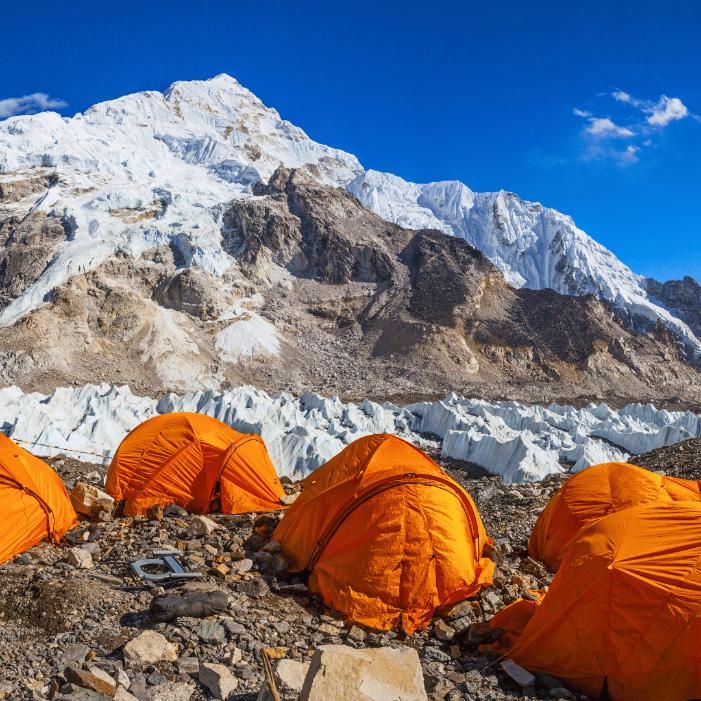
The Annapurna Base Camp Trek is less difficult than the Everest Base Camp Trek . Here’s why:
- Altitude, terrain, and duration affect how challenging a trek is.
- Annapurna Base Camp is at a lower altitude, making it easier on the body due to more oxygen.
- The terrain in Annapurna is gentler compared to the rough trails of Everest.
- The duration of the Annapurna trek is shorter, allowing for gradual acclimatization.
- The Everest Trek requires more walking and acclimatization, making it more physically demanding.
When talking about the scenery for Annapurna Base Camp Trek vs. Everest Base Camp Trek , we can see a lot of differences. Hikers heading for the Annapurna Base Camp Trek can expect diverse scenic views. They range from amazingly beautiful rhododendron forests to snow-covered, magnificent peaks.
Those trekking to Everest Base Camp will encounter uneven landscapes. The area is filled with pretty Sherpa villages.
The Annapurna region offers more varied vegetation and colorful landscapes. In contrast, the Everest region is barren yet astonishing in its beauty.
Popular photo spots along both treks include:
- The stunning sunrise views from Poon Hill on the Annapurna trek
- The panoramic vistas of Mount Everest from Kala Patthar on the Everest trek
These photo opportunities allow trekkers to capture the breathtaking scenery. It showcases the natural beauty that defines these iconic Himalayan trails.
Annapurna Base Camp Trek Highlights comparing with the Everest Base Camp Trek
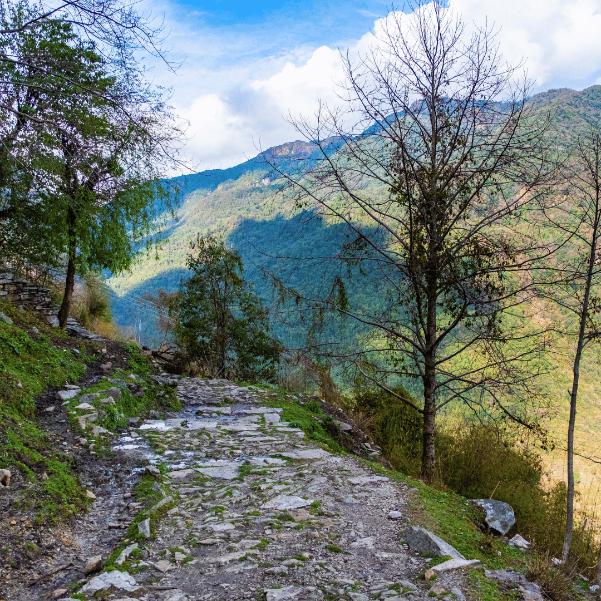
- Panoramic Views
The Annapurna Base Camp Trek offers panoramic views of the Annapurna mountain range, Machapuchare , and the diverse landscapes. Throughout the trek, you can enjoy a rich variety of natural beauty.
On the other hand, the Everest Base Camp Trek presents panoramic views of Everest, Lhotse, Nuptse, and the Khumbu Glacier. The Annapurna trek has dense greenery and terraced fields, while the Everest trek has rough terrain with snow-capped peaks that look beautiful.
When talking about Annapurna Base Camp Trek vs. Everest Base Camp Trek , both treks provide unique panoramic views of the Himalayas, each capturing the essence of this mountain range. These journeys are memorable and visually captivating, perfect for adventure and nature enthusiasts.
- Variety of Terrain
Hikers on the Annapurna Base Camp Trek can expect different terrain. They will encounter dense green forests, terraced fields, and alpine meadows. The trail passes through charming villages, giving a peek into local culture and the way of life over there.
The Everest Base Camp Trek , on the other hand, has a rougher landscape. It includes rocky paths, icy glaciers, and barren moraines. This trek goes through high-altitude areas, offering panoramic views of the world’s tallest peaks.
When talking about Annapurna Base Camp Trek vs. Everest Base Camp Trek , while they both have stunning scenery, the Annapurna region provides a wider variety. It ranges from subtropical forests to snowy peaks, offering very rich natural scenes for trekkers to enjoy.
- Cultural Experience
Engaging with the local culture on the Annapurna Base Camp Trek vs. Everest Base Camp Trek , they both offer unique insights.
Interacting with local villagers and experiencing traditional dances and rituals provided a firsthand look at Nepal’s rich cultural heritage.
Visiting ancient monasteries, participating in local festivals, and trying authentic cuisine immersed trekkers in local customs.
This cultural aspect added depth to the trekking experience, offering a deeper connection to the land and its people.
By embracing the cultural richness, trekkers can gain a greater appreciation for the environment and the communities in these majestic mountains.

Everest Base Camp Trek Highlights

- Close-up Views of Everest
Get ready to be amazed at the close-up views of Everest. It reveals its majestic peak in all its glory. The complete magnitude and beauty of the world’s tallest mountain become apparent. The intricate details of the snow-capped summit, surrounding peaks, and rugged terrain offer the most inspiring perspective.
Being in such close proximity during the trek allows trekkers to deeply appreciate nature’s grandeur. It helps in gaining a better understanding of the mountain’s significance. This intimate experience adds a sense of accomplishment to the journey. It also creates a profound connection with the mountain and its surroundings.
The close-up views of Everest serve as a constant reminder of the challenges faced and overcome during the trek. This makes the entire experience more meaningful and rewarding.
- Sherpa Culture
Sherpa culture shapes the Everest Base Camp Trek . It affects the experience and daily life of trekkers. The Sherpa people are skilled in mountaineering. They value the environment and follow traditional customs. This adds a unique touch to the trek. Their influence goes beyond the trails. It impacts the local community through rituals like prayer flags and celebrations. These traditions promote unity and well-being. Sherpa culture is evident in various aspects of trekking.
For example, yak caravans are used for transport. Stupa shrines dot the trekking route. Local Sherpa families run tea houses. These practices preserve their heritage and enhance the Himalayan exploration experience.
- Khumbu Glacier
The Khumbu Glacier is changing due to climate change. It’s melting and shrinking. Trekkers should be careful of hidden dangers like crevasses under the ice. To stay safe, they need good equipment, expert guides, and knowledge of the route. Scientists are studying the glacier’s movement, melting, and the effects of climate change on its health. This research helps us learn about the glacier and the impact of climate change in the area.
Accommodation Options
Accommodation options along the Annapurna Base Camp Trek and Everest Base Camp Trek routes vary.
While comparing the Annapurna Base Camp Trek vs. Everest Base Camp Trek, both treks offer similar types of places to stay, including tea houses, lodges, and basic guesthouses.
However, the Everest Base Camp Trek has a wider range of choices and more luxurious options than the Annapurna Base Camp Trek.
In terms of comfort, Everest Base Camp offers more amenities like attached bathrooms, hot showers, and electric blankets.
On the other hand, the Annapurna Base Camp Trek may have more basic facilities with shared bathrooms and limited hot water.
Accommodation costs are generally higher on the Everest Base Camp Trek due to the demand for more upscale lodges.
The Annapurna Base Camp Trek is usually more budget-friendly.
When deciding between the two routes, trekkers should consider their preferences for comfort, amenities, and budget.
Best Time to Trek
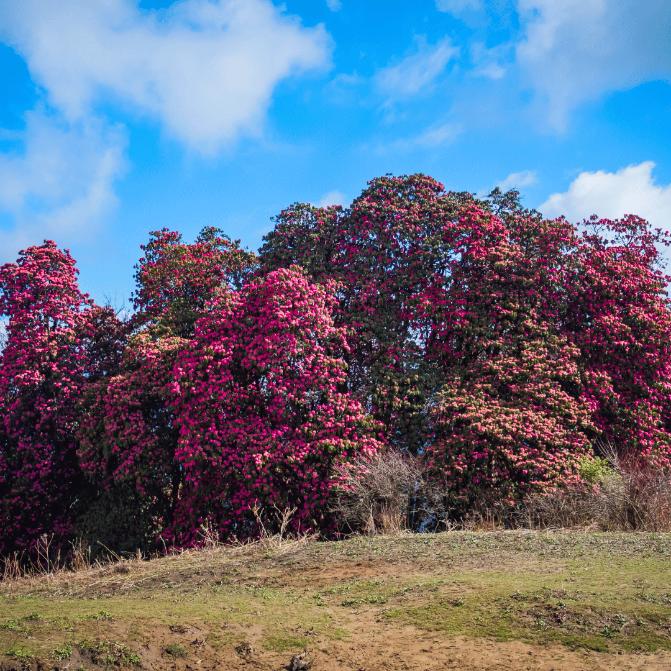
The best time to trek while comparing the Annapurna Base Camp Trek vs. Everest Base Camp Trek, there isn’t much debate. For the Annapurna Base Camp Trek and the Everest Base Camp Trek , it is important to consider weather conditions throughout the year.
Different seasons impact visibility and safety on these treks. Autumn (September to November) is generally ideal, with clear skies and moderate temperatures. Spring (March to May) also offers pleasant weather and blooming rhododendrons along the trails.
However, the monsoon season (June to August) brings heavy rainfall and slippery trails, making trekking challenging and potentially dangerous. Winter (December to February) can pose risks of snowstorms and extreme cold at higher altitudes.
Considering these seasonal variations is important when planning a trek for an enjoyable and safe experience.
Cost Comparison
The Annapurna Base Camp Trek costs less than the Everest Base Camp Trek . Prices can vary based on the operator and season.
Overall expenses for permits, accommodations, meals, and transportation are usually cheaper for the Annapurna trek. However, don’t forget about other costs like gear rentals, travel insurance, and tips for guides and porters. These additional expenses can accumulate during the trek.
Consider these hidden costs when comparing the total expenses of the Annapurna and Everest Base Camp Trek for a more accurate assessment.
Final thoughts
Are you deciding between trekking to Annapurna Base Camp or the Evere s t Base Camp Trek ?
Annapurna Base Camp has a shorter trek and stunning views of Machapuchare and Annapurna peaks.
Everest Base Camp is a more challenging trek with views of Mount Everest , the world’s highest peak.
When choosing between these two destinations in Nepal, it is recommended to think about your fitness level, trekking experience, and scenery preferences.
While comparing the Annapurna Base Camp Trek vs. Everest Base Camp Trek , the Annapurna Base Camp trek is generally considered less difficult than the Everest Base Camp trek. The Annapurna trek involves less elevation gain, a shorter duration, and milder weather conditions compared to the Everest trek.
Both Annapurna Base Camp and Everest Base Camp Trek offer stunning views, but Everest Base Camp provides more dramatic views of the world’s tallest peak, Mount Everest . Annapurna Base Camp offers diverse landscapes with closer views of the Annapurna Range.
Yes, there are altitude sickness concerns when trekking to Annapurna Base Camp or Everest Base Camp. It is important to acclimatize properly, stay hydrated, and descend if symptoms persist. Consider taking Diamox medication as a preventive measure.
The best time to trek to Annapurna Base Camp or Everest Base Camp is during the pre-monsoon season in Nepal, from late September to early November. This time offers clear skies, moderate temperatures, and stunning views of the Himalayas.
Annapurna Base Camp offers more cultural experiences compared to Everest Base Camp, with encounters with various ethnic groups like the Gurungs and Magars, and visits to traditional villages like Ghandruk.
Send an Enquiry
© 2024 - Himalayan Trekking and Tours (P) Ltd. All Rights Reserved.
--> For quick Inquiry: +977 98510 42334
Fixed Departure
--> +977 98510 42334
Annapurna Base Camp Vs Everest Base Camp Trek
Approx. Read Time: 5 Minutes
Publised at Jun 14, 2020
The one very question that always pops back in the mind while planning a trip to the Himalayas is the trekking trail you want to hike. Most people find it hard to choose between the famous route of Annapurna Base camp and Everest Base Camp.
Plus, an added confusion when you find tons of information as you walk the jam-packed avenues of Thamel with signs promoting both equally, and bloggers with their own arguments over which is the best, ABC or EBC?
Google adds more puzzles to the issue as well, providing compelling information on both destinations. Nevertheless, these are two trekking trails in the Himalayas, among the numerous treks in Nepal that stand out from the rest, and are the most famous for both amateur and experienced trekkers.
Here, today I will provide some aspects for both trekking trails and hope will help to decide which might suit your interest for time being. This article will cover aspects such as difficulty, the best time to visit, accommodation, scenic beauty, days required, accessibility, and a few other factors to consider.
Annapurna Base Camp vs Everest Base Camp: General Information
1. best time to visit.
The best time to visit both the trials to Annapurna and Everest Base camps are during Autumn (Sep – Nov) and Spring (Mar-May).
The climatic condition of both regions is particularly good with bright and warm days and no possible rain. View of blooming rhododendrons flowers can be seen as soon as you get past the 2500 meters mark, on both trails. Everest could be a bit crowded in May as this is a peak expedition season and some fascinating events could be observed at the moment.
This month also marks the remembrances of the first ascent of Mount Everest in 1953 by Tenzing Norgay and Edmund Hillary. Thus, a time for celebration!
On the other hand, Annapurna Base Camp is accessible throughout the year while climbing Everest, and trek to the trail is difficult during the months of Dec- Feb.
2. Days Required
Trek to Annapurna base camp is typically 14 days to and fro Kathmandu in general.
Everest base camp trek can also be around 14 to 21 days depending based upon your customization (add an extra day in Namche or if you choose multicountry packages combined with Tibet or Bhutan).
A short trek of Everest will lead you only up to Tengboche Monastery which will be around 8 days and Everest View Point Trek is 13 days. Days for both the trails can be customized as per your fitness level and vacation schedule.
Some other factors that determine the length of your trek are side trips, rest days, refreshing time in Kathmandu and Pokhara, before or after the trek.
Himalayan Trekkers has a wide range of packages if you would like to extend your trip one step further. Check out our Everest Base Camp Trek with Tibet tour as well as Everest Base Camp with Bhutan Tour .
3. Trek Starting Points
Annapurna base camp trek starts from Nayapul near Pokhara. You can either choose between 7 hours drive or a mere 30 min flight from Kathmandu which lands you in the city of lakes- Pokhara.
For the Everest base camp trek, you fly to Lukla, a 35-minute flight from Kathmandu. If you are looking for a longer trek in the Everest region (18-20 days), you can follow the path of Hillary and Tenzing via Jiri.
4. Accommodation / Facilities – Annapurna versus Everest Base Camp
With more rest stops, cafés, and Western toilets available to you, the Annapurna base camp trek feels progressively 'true' versus the EBC.
Both the trekking trails have a small family-owned guest house, but the Annapurna base camp trek passes through more dense settlements and has more guest houses and accommodation options. You may come across some very luxurious hotels and guest houses in the Everest region though.
In terms of facilities, both are comparable as you can access WIFI, hot shower, and quality food in both regions.
Pricing is a very relative topic, so we are comparing just the basics here. Since the Everest base camp trek involves a flight to Lukla, it will cost you more than ABC, which doesn’t necessarily require flying.
The longer duration also contributes to the higher cost of the trek in the Everest region. You will pay around USD 1200 for a typical Annapurna base camp trek (excluding international flights), whereas you will be paying around 400 more for a typical 16 days Everest base camp trek.
Both trails can be having plenty of tourists during the peak season. Everest is more crowded during spring. But you will have solitary moments in both the trek if you walk in the right place.
7. Social Experiences – ABC versus EBC
The Everest region is dominated by Sherpas with a very vibrant and interesting culture and traditions. On the other hand, the Annapurna base camp trek has varied settlements throughout the trail.
Annapurna region is home to Gurungs, Puns, Magars, Thakali, Chhetris, Brahmins, and other ethnicities. So you will get a more diverse cultural and social experience trekking to Annapurna Base Camp.
8. Difficulty level
Everest base camp is definitely a winner here as it goes more than 5000 m. Some landmarks such as Kala Patthar can go as high as 5600 m.
The trails of the Annapurna region reach up to altitudes of 4700 m. Though not an excessively big difference in the Himalayas, altitude can affect the speed and duration of the entire journey.
9. The X factors in Everest and Annapurna base camp trek
Everest region is famous for Mount Everest, the highest mountain on earth, also with Lhotse, Makalu, and various other peaks some of which are the highest on earth.
Annapurna Base Camp trek takes you closer to the 10th highest Mount Annapurna, Mt Dhaulagiri, and Manaslu, the other peaks such as Mt Fishtail ( Machhapuchre) , not as high as others but definitely very popular.
I could compare some of these topics but one thing that is incomparable is the immense love that Nepalese people will give you on both the trekking trials. If you are still finding it difficult to decide between both of these treks then visit the detailed itinerary of the Everest base camp trek and the Annapurna base camp trek.
Why next vacation should...
Must See Places in Kathma...
Travel Info 85
Travel Blog 14
Adventure Activities 8
Trekking & Hiking 8
News & Updates 17
Popular Tours
9 Nights 10 days Best of Nepal Tour
Everest Base Camp Helicopter Tour with Landing Cost
Popular Treks
Annapurna Base Camp Trek, Itinerary, Cost in 2024/25
Everest Base Camp Trek | EBC Trekking For 2024/25
Popular Reads
How to Choose a Reliable Tour and Trekking Agencies in Nepal?
How to Obtain Island Peak Climbing Permits ?
How to Travel to Nepal from Europe?
16 Min Read
How to Obtain a Mera Peak Climbing Permit?
How to Travel to Nepal from India?
12 Min Read
Associated With
Ways You Can Pay
© 2024 Himalayan Trekkers. All rights reserved.
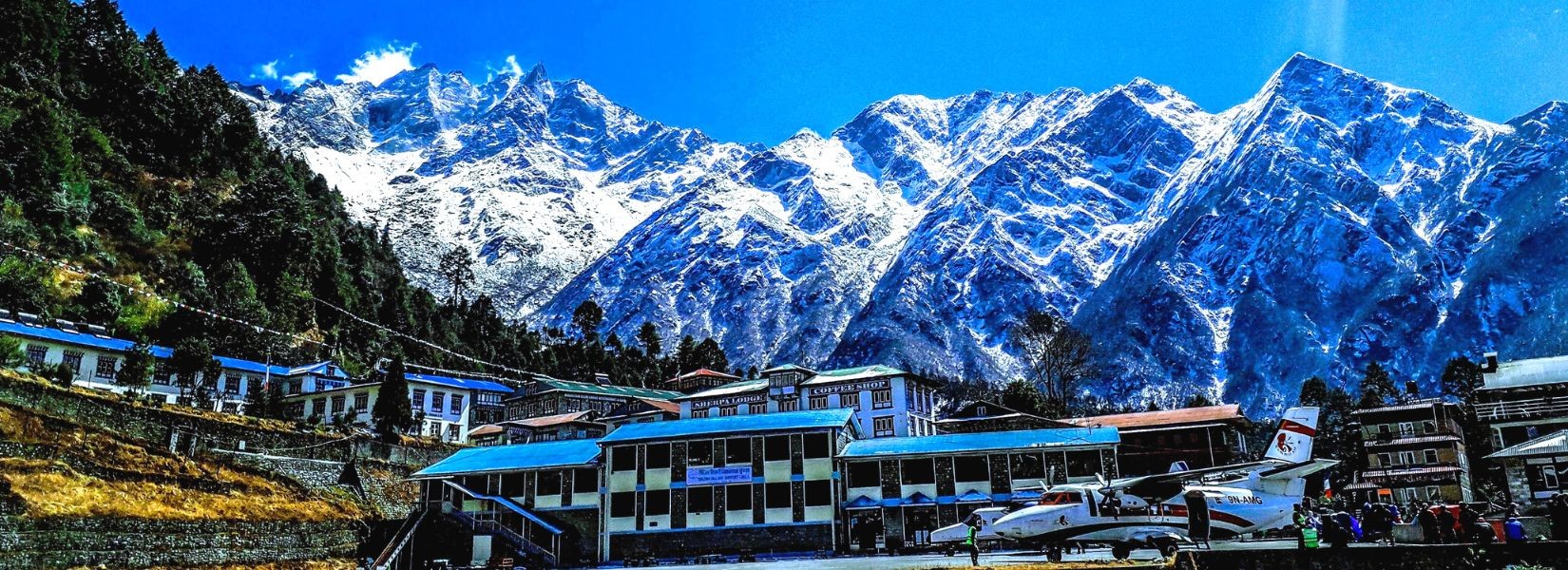
- Annapurna Base Camp Vs Everest Base Camp Treks : A Comprehensive Guide
- You are here:

- Mar 7, 2023
- Rubi Bhandari
You want to trek through the Himalayas, then? That's wonderful! And if you're still having trouble coming to a sane choice, you might want to keep reading.We will provide a detailed comparison between the Annapurna Base Camp and Everest Base Camp treks. These two treks are among the most popular and iconic trekking destinations in Nepal and are known for their breathtaking views of the Himalayas, unique cultural experiences, and challenging yet rewarding trails.
If you're planning a trek in Nepal, choosing between Annapurna and Everest can be a tough decision, as both offer different experiences and challenges. In this section, we aim to help you make an informed decision by providing a comprehensive guide to both treks, covering everything from the difficulty level of the trails to the best time to visit and accommodation options.
We'll start by comparing the two treks based on their difficulty level. While both treks are considered challenging, there are some key differences in terms of altitude, terrain, and trail conditions. We'll provide a detailed breakdown of the difficulty level of each trek, including the physical demands of the trails, the altitude sickness risks, and the availability of emergency medical services.
Next, we'll explore the scenic beauty of both treks. The Annapurna Base Camp trek offers stunning views of the Annapurna range, including the majestic Mount Annapurna and Machhapuchhre (also known as Fishtail). On the other hand, the Everest Base Camp trek offers panoramic views of Mount Everest, Lhotse, Nuptse, and Ama Dablam, among other peaks. We'll compare the two treks based on the scenic beauty, wildlife sightings, and cultural experiences.
In addition to the natural beauty, both treks offer unique cultural experiences. The Annapurna Base Camp trek takes you through traditional Gurung villages, where you can learn about their culture and way of life. The Everest Base Camp trek takes you through Sherpa villages, where you can experience the local hospitality and learn about their mountaineering history.
We'll also provide a detailed comparison of the routes and itinerary for both treks. This includes the starting points, the number of days required to complete each trek, and the accommodation options along the way. We'll also cover the best time to visit each trek, taking into account the weather conditions, temperature, and trail conditions.
By the end of this section, you'll have a clear understanding of the differences between the Annapurna Base Camp and Everest Base Camp treks and be able to choose the trek that best suits your interests, physical ability, and schedule. So, let's dive in and compare these two iconic treks in Nepal!
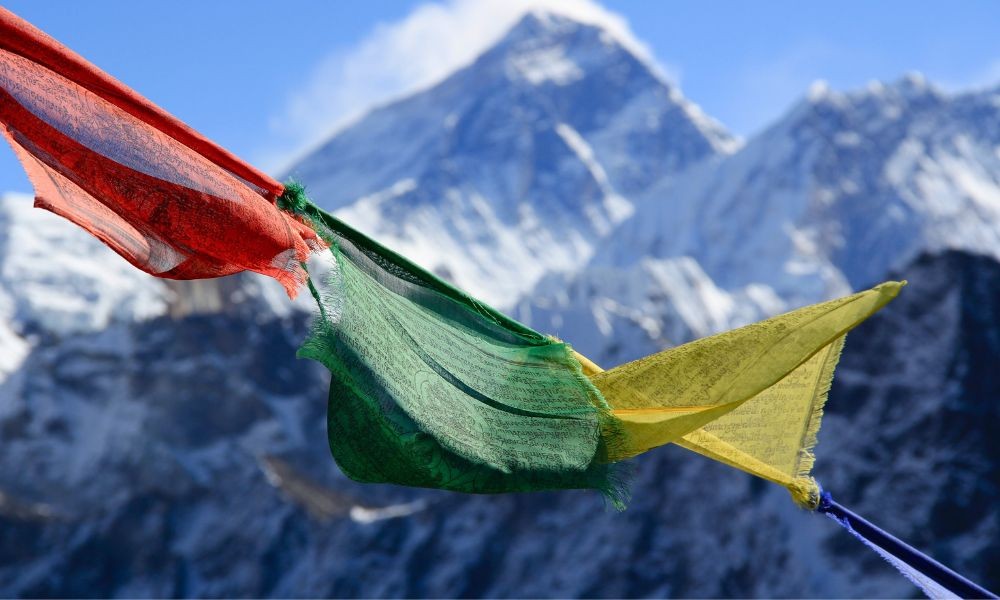
Table of Contents
Introduction, overview of the annapurna base camp trek and everest base camp trek.
The Annapurna Base Camp and Everest Base Camp treks are two of the most iconic and sought-after treks in Nepal. The Annapurna Base Camp trek takes trekkers through beautiful landscapes, traditional villages, and dense forests, culminating in the stunning Annapurna Base Camp. Meanwhile, the Everest Base Camp trek leads trekkers to the base camp of the world's highest mountain, Mount Everest, through the Khumbu region of Nepal. Both treks offer breathtaking views of snow-capped mountains, glaciers, and local cultures, making them a favorite among adventure seekers. However, each trek presents its unique challenges, such as different weather conditions and altitude sickness risks. This comprehensive guide provides valuable insights into both treks, including difficulty levels, trekking seasons, cultural experiences, accommodations, and costs, helping readers make an informed decision about which trek to choose. Whether you're a seasoned trekker or a first-timer, the Annapurna Base Camp and Everest Base Camp treks are sure to provide you with an unforgettable experience of a lifetime.
Purpose of the Guide
This guide's objective is to give readers a thorough contrast of the Nepali treks to Everest Base Camp and Annapurna Base Camp . This guide aims to assist readers in making an educated choice regarding which trek is most appropriate for them by providing useful insights into each trek, including trekking routes, difficulty levels, accommodations and facilities, cultural experiences, trekking costs, and more. This guide will give you important information to help you get ready for your trek and make the most of your adventure, whether you are an experienced trekker or a novice. In the end, this guide's goal is to help readers select a trek that matches their preferences, abilities, and goals while also ensuring a safe experience and enjoyable trekking experience in the beautiful Himalayan region of Nepal.
Trekking Duration Annapurna Base Camp Vs Everest Base Camp
The total amount of trekking days should be one of the main considerations when deciding between ABC and EBC. While the journey to Everest base camp takes between 14 and 16 days, the trek to Annapurna base camp lasts between 11 and 14 days. While they are not necessary for the ABC journey, the EBC trek includes two rest days.
For both of these areas, there are ways to reduce the time required. The number of hiking days would ideally be reduced, but it is wise to recognize the value of acclimating to new surroundings. The best choice is to tailor or customize your travel itinerary.
Trekking Seasons
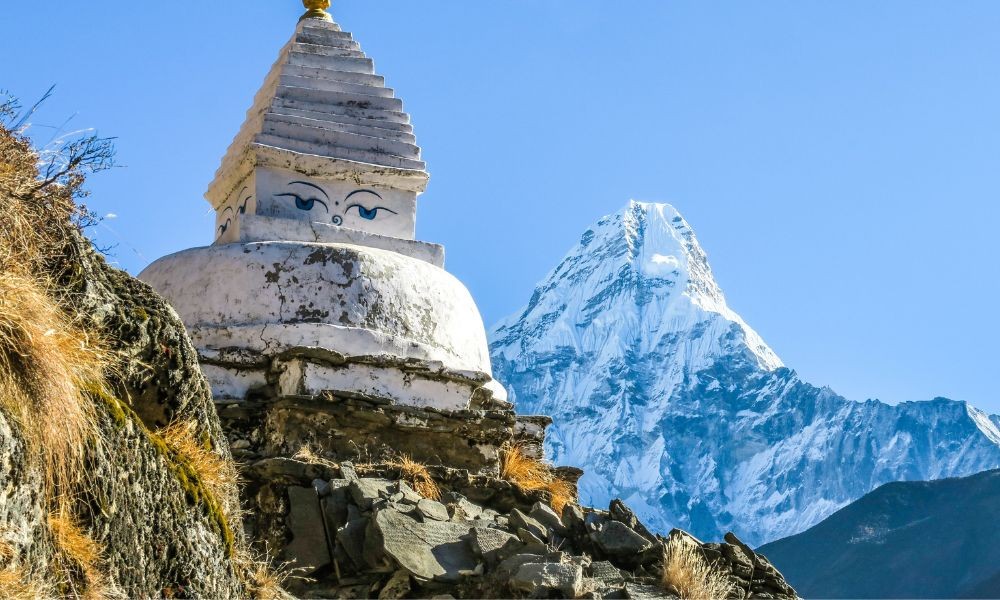
Best Time to Trek to Annapurna Base Camp
Autumn (September to November) and spring are the ideal seasons for a trek to Annapurna Base Camp (March to May). These months offer the best circumstances for trekking because the weather is typically dry and stable, with clear skies and comfortable temps. While the spring season offers the chance to see rhododendrons and other wildflowers blooming along the trekking path, the autumn season offers stunning views of clear blue skies, snow-capped mountains, and colorful landscapes.
Conversely, the winter season (December to February) and the summer monsoon season (June to August) are less suitable for hiking to Annapurna Base Camp. Trekking can be challenging and risky during the monsoon season due to heavy rain and slick trails, while during the winter, the trails may be blocked by snow and ice, making it hard to trek.
Consequently, it is advised to plan your trek during the autumn or spring seasons if you want to have the best possible trekking experience if you intend to hike to Annapurna Base Camp. The weather can be unpredictable in the mountains, so it's essential to remember that before starting the trek, you should check the forecast and be ready for any sudden changes in the weather.
Best Time to Trek to Everest Base Camp
Autumn (September to November) and spring (March to May) are the ideal seasons for hiking to Everest Base Camp because they provide dry, stable weather with clear skies and comfortable temps. Trekkers can take in breathtaking views of snow-capped mountains and gorgeous wildflowers during these months because the path is less strenuous. Due to hazardous weather conditions, it is advised to avoid hiking from December through February and June through August during the summer monsoon season. To reduce the risk of altitude sickness, it is crucial to be ready for any unforeseen weather shifts and to adhere to the right acclimatization techniques.
Weather Conditions in Annapurna Vs Everest Region
Weather conditions play a significant role in trekking to Annapurna Base Camp and Everest Base Camp. Both trekking regions experience different weather patterns throughout the year, which can affect the trekking experience.
In general, the autumn season (September to November) and the spring season (March to May) are the best times to trek to both Annapurna Base Camp and Everest Base Camp. During these seasons, the weather is usually stable and dry, with clear skies and moderate temperatures, providing ideal trekking conditions.
However, during the winter season (December to February) and the summer monsoon season (June to August), trekking can be more challenging due to weather conditions. In the winter season, there may be snow and ice on the trails, making them slippery and difficult to navigate. Meanwhile, during the monsoon season, there is heavy rainfall and cloudy weather, which can obstruct views and make trekking difficult.
Before starting the trek, it's crucial to check the weather forecast and prepare appropriately. In addition, since weather conditions can affect how the body reacts to high altitudes, it is essential to adhere to appropriate acclimatization procedures to reduce the risk of altitude sickness.
To guarantee the best weather for trekking, it is advised to schedule your trek to Annapurna Base Camp or Everest Base Camp during the autumn or spring seasons.
How Difficult are Annapurna Base Camp and Everest Base Camp?
Difficulty level of annapurna base camp trek.
The journey to Annapurna Base Camp is regarded as being of moderate difficulty. The journey entails walking through forests, river valleys, terraced fields, high altitude passes, and steep topography.
Depending on the speed and schedule of the hiker, the trek should be finished in 7 to 12 days. In order to finish the trek comfortably, hikers must be physically fit and have some prior hiking experience.
Trekkers will encounter challenging sections of steep uphill and downhill terrain throughout the course of the journey. The Annapurna Base Camp, which is situated at an elevation of 4,130 meters above sea level, marks the highest spot of the trek.
The Annapurna Base Camp trek is well-liked among hikers despite its moderate challenge level because of its breathtaking scenery and views of the Annapurna mountain range. The majority of trekkers should be able to finish the trek without too much difficulty with the right planning, training, and acclimatization.
Difficulty Level of Everest Base Camp Trek
The Everest Base Camp journey is regarded as a difficult trek that calls for participants to be in good physical and mental shape to handle the difficult terrain and high altitude.
The trek usually lasts 12 to 14 days, during which time hikers progressively climb to the base camp, which is situated at a height of 5,364 meters above sea level. Trekkers will face obstacles like rocky terrain, steep uphill and downhill portions, and river crossings along the way.
One of the main difficulties of the trek is the altitude gain, which can cause altitude sickness if trekkers do not properly acclimatize. Trekkers will need to take regular breaks, stay hydrated, and ascend gradually to allow their bodies to adjust to the altitude.
Despite the challenges, the Everest Base Camp trek is immensely rewarding, offering stunning views of the Himalayas and a glimpse into the local Sherpa culture. With proper preparation, training, and acclimatization, most trekkers should be able to complete the trek successfully. It is advisable to consult with a doctor before embarking on the trek and to hire a licensed guide for added support and safety.
Fitness Requirements For ABC Trek & EBC Trek
Both the A nnapurna Base Camp and Everest Base Camp treks require a certain level of fitness to complete comfortably. While the Annapurna Base Camp trek is considered moderately difficult, the Everest Base Camp trek is considered a challenging trek that requires a higher level of fitness.
To complete either trek, trekkers should engage in regular exercise and physical activity leading up to the trek to build endurance and strength. Cardiovascular exercise, such as running or cycling, is particularly important, as the trek involves prolonged walking and hiking at high altitudes.
Trekkers should also see a doctor before starting the journey to make sure they are in good physical condition and do not have any underlying medical conditions that could affect their ability to finish the trek.
Trekkers should take frequent pauses, drink plenty of water, and pay attention to their bodies to prevent overexertion. Altitude sickness, which can be a serious health issue at high altitudes, can be reduced by adhering to proper acclimatization procedures.
Hiring a licensed guide and porter can also help to alleviate some of the physical demands of the trek, allowing trekkers to focus on enjoying the scenery and completing the trek safely. Overall, while both treks require a certain level of fitness, with proper preparation and training, most trekkers should be able to complete the treks successfully.
Trekking Routes
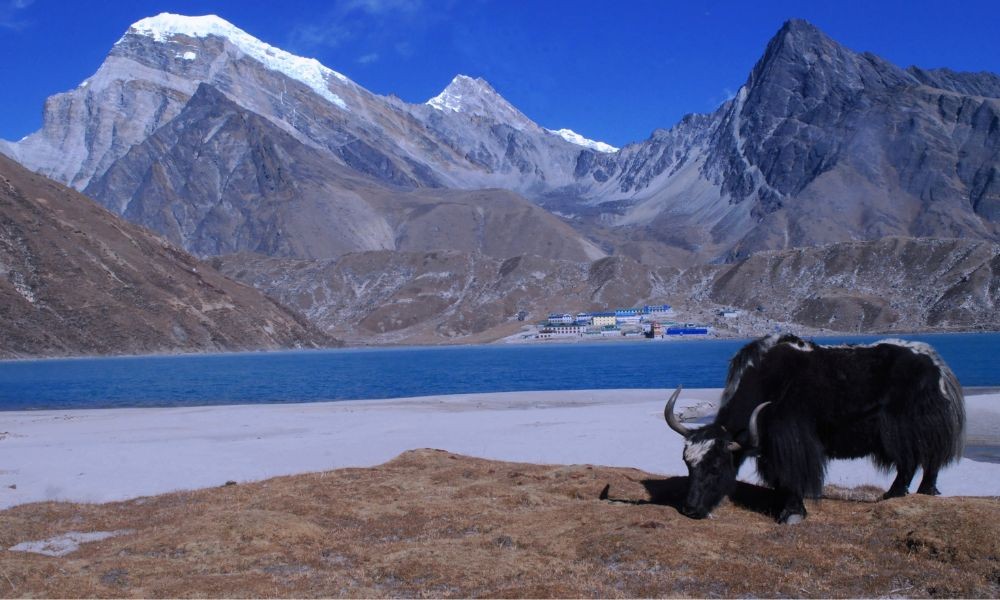
Trekking Routes to Annapurna Base Camp
There are several trekking routes that lead to Annapurna Base Camp, each offering a unique trekking experience with varying levels of difficulty and scenery.
One of the most popular routes is the Ghorepani Poon Hill trek, which is a shorter and less strenuous route that takes around 5-7 days to complete. This trek takes trekkers through traditional Nepalese villages, terraced fields, and dense forests before reaching the base camp.
The longer and more difficult Annapurna Sanctuary trek, which takes about 10 to 12 days to complete, is another well-liked path. Before arriving at the base camp, this journey takes hikers through a variety of landscapes, including river valleys, bamboo forests, and high altitude passes.
A lesser-known trek that takes about 5-7 days to finish and provides breathtaking views of the Annapurna mountain range is the Mardi Himal trek. Before arriving at the base camp, this journey takes hikers through rhododendron forests and high altitude pastures.
Regardless of the route, trekkers should be prepared to navigate steep terrain, river crossings, and high altitude passes. Trekkers will also need to take proper acclimatization breaks to minimize the risk of altitude sickness. Hiring a licensed guide and porter can also help trekkers navigate the route safely and comfortably.
Trekking Routes to Everest Base Camp
The various trekking routes that lead to Everest Base Camp each provide a distinctive trekking experience with different degrees of difficulty and scenery.
The traditional Everest Base Camp trek, which requires 12–14 days to finish, is one of the most well-known routes. Before reaching the base camp, this trek travels through traditional Sherpa villages, suspension bridges, and high-altitude passes. Mount Everest and other Himalayan peaks can be seen in stunning detail from this path.
The Gokyo Lakes trek, which takes 12–14 days to finish, is another well-liked route. The stunning Gokyo Lakes, a chain of turquoise glacial lakes surrounded by snow-capped hills, are reached by way of this journey. The path also provides breathtaking views of Mount Everest and other nearby peaks.
The Everest Three Passes trek is a longer and more challenging route that takes around 17-18 days to complete. This trek takes trekkers through three high altitude passes - Renjo La, Cho La, and Kongma La - and offers breathtaking views of the Himalayan range.
Different Difficulty Stages
Both the treks to Everest Base Camp and Annapurna Base Camp are regarded as difficult treks that call for a certain degree of physical preparedness and stamina. The difficulty degrees of the various routes within each trek do, however, vary.
The Ghorepani Poon Hill route is thought to be less difficult than the Annapurna Sanctuary journey when it comes to the Annapurna Base Camp trek. Less time is needed to finish the Ghorepani Poon Hill trek because there are fewer steep ascents and descents. The Annapurna Sanctuary trek, on the other hand, is more difficult and requires longer to complete.
Similar to how the Gokyo Lakes route is thought to be less taxing than the standard Everest Base Camp journey, it is part of the Everest Base Camp trek. There are fewer steep ascents and descents on the Gokyo Lakes journey, giving hikers more time to acclimate to the high altitude. The traditional Everest Base Camp trek, however, includes more difficult terrain and higher altitudes.
It is crucial for trekkers to have a certain degree of fitness and stamina regardless of the route in order to be able to complete the trek comfortably and safely. To reduce the risk of altitude sickness and other health problems, it's also critical to take the appropriate acclimatization breaks and adhere to a proper training schedule before the journey.
Altitude Sickness
Risk of altitude sickness in annapurna base camp trek.
Altitude sickness, also known as acute mountain sickness (AMS), is a common risk associated with high-altitude treks such as the Annapurna Base Camp trek. The risk of AMS increases as trekkers ascend to higher altitudes, and it is important for trekkers to be aware of the symptoms and take necessary precautions.
Symptoms of AMS include headache, nausea, fatigue, dizziness, shortness of breath, and loss of appetite. In severe cases, AMS can lead to more serious conditions such as high altitude pulmonary edema (HAPE) and high altitude cerebral edema (HACE), which can be life-threatening.
To minimize the risk of AMS, it is important for trekkers to follow a proper acclimatization schedule, which involves gradually ascending to higher altitudes and taking rest days to allow the body to adjust to the high altitude. It is also important to stay hydrated, avoid alcohol and smoking, and take necessary medications such as Diamox as prescribed by a doctor.
Trekkers should also be aware of the signs and symptoms of AMS and report any symptoms to their guide or trekking team immediately. In case of severe AMS, trekkers may need to descend to lower altitudes or seek medical attention. Overall, with proper precautions and awareness, the risk of altitude sickness can be minimized during the Annapurna Base Camp trek.
Risk of Altitude Sickness in Everest Base Camp Trek
Altitude sickness, also known as acute mountain sickness (AMS), is a common risk associated with high-altitude treks such as the Everest Base Camp trek. The risk of AMS increases as trekkers ascend to higher altitudes, and it is important for trekkers to be aware of the symptoms and take necessary precautions.
Trekkers should also be aware of the signs and symptoms of AMS and report any symptoms to their guide or trekking team immediately. In case of severe AMS, trekkers may need to descend to lower altitudes or seek medical attention.
The Everest Base Camp trek involves higher altitudes compared to other treks and therefore carries a higher risk of AMS. Trekkers should be particularly cautious during the ascent to high altitude passes such as the Cho La pass and the Kongma La pass. However, with proper precautions and awareness, the risk of altitude sickness can be minimized during the Everest Base Camp trek.
Symptoms and Prevention
Symptoms of altitude sickness include:
- Shortness of breath
In severe cases, altitude sickness can lead to:
- High altitude pulmonary edema (HAPE)
- High altitude cerebral edema (HACE)
Prevention of altitude sickness includes:
- Gradual ascent to higher altitudes
- Rest days to allow the body to acclimatize
- Staying hydrated by drinking plenty of water
- Avoiding alcohol and smoking
- Taking medications such as Diamox as prescribed by a doctor (consult a doctor before taking any medications)
In case of symptoms of altitude sickness, it is important to:
- Notify your guide or trekking team immediately
- Descend to lower altitudes if necessary
- Seek medical attention if symptoms are severe.
Accommodation and Facilities
Accommodation in annapurna base camp trek.
Accommodation is an important aspect of any trek, and the Annapurna Base Camp trek offers a variety of options for trekkers to choose from. The trek features teahouse accommodation, which are lodges run by local families that offer basic but comfortable rooms and meals.
Teahouses along the Annapurna Base Camp trek route are generally clean and cozy, with twin beds or double beds and shared bathrooms. Some teahouses offer attached bathrooms for an additional cost. Trekkers can expect to find warm blankets, pillows, and hot showers in most teahouses.
Depending on the time of year and the location, the expense of lodging in teahouses along the Annapurna Base Camp trek route can change. The price of lodging typically varies from USD 3 to USD 10 per night.
It is important to be aware that, particularly during the busiest trekking seasons, teahouses along the Annapurna Base Camp trek route can fill up rapidly. To guarantee a room, it is advised to make reservations for lodging in preparation or to arrive early in the day.
Overall, trekkers have a comfortable and affordable choice for resting and recharging during their trek with the teahouse lodging along the Annapurna Base Camp trek path.
Accommodation in Everest Base Camp Trek
Any journey must take accommodation into account, and the Everest Base Camp trek gives hikers a variety of lodging choices. There are teahouses, lodges, and guesthouses along the path that provide simple but comfortable lodging and meals.
The majority of lodging along the Everest Base Camp trek path are teahouses. They usually have twin or double beds with shared bathrooms and are run by local families. For an extra fee, some teahouses also provide attached bathrooms. Most teahouses provide warm blankets, pillows, and hot baths for trekkers.
Depending on the location and time of year, the expense of lodging in teahouses along the Everest Base Camp trek route can change. The average expense of lodging is USD 3 to USD 10 per night
In recent years, some teahouses along the Everest Base Camp trek route have begun offering more luxurious accommodations, including private bathrooms, hot tubs, and even WiFi. However, these options are more expensive and may not be available at every teahouse.
It is important to note that teahouses along the Everest Base Camp trek route can fill up quickly, especially during peak trekking seasons. It is recommended to book accommodation in advance or arrive early in the day to secure a room.
Overall, the teahouse accommodation along the Everest Base Camp trek route offers trekkers a comfortable and affordable option for resting and rejuvenating during their trek.
Availability of Food and Water during ABC Trek & EBC Trek

Any trek must take food and water availability into account, and both the Annapurna Base Camp and Everest Base Camp treks provide a variety of choices.
Teahouses, lodges, and guesthouses are located along both trek paths and serve meals and snacks to hikers. The food on the menus of these places is typically a blend of regional and foreign fare, including rice, noodles, soups, and curries. Western morning foods like pancakes and eggs are also available in some teahouses.
It is important to note that the availability of food options may vary depending on the location and season. In remote areas, the menu may be limited, and trekkers may need to bring their own snacks or energy bars.
Regarding water, it is recommended to avoid drinking untreated water in both trek routes to avoid waterborne illnesses. Trekkers can purchase bottled water or use water purification tablets or filters to treat water from streams or springs.
Overall, trekkers should be prepared to bring some of their own food and water supplies, especially in remote areas, but can rely on teahouses and lodges along the route for most of their food needs.
Scenery and Views
Scenery and views in annapurna base camp trek.
For its breathtaking landscape and views, the Annapurna Base Camp Trek is well-known. You will pass through a variety of landscapes on the journey, from verdant, green forests to bleak, high-altitude territory, and alpine meadows in between.
The trek starts in the picturesque town of Pokhara and proceeds along the Modi Khola river valley, traveling through a number of small settlements and terraced farmlands. You will travel through dense rhododendron, oak, and bamboo forests as the vegetation changes as you ascend in altitude.
One of the highlights of the trek is reaching Machhapuchhre Base Camp, where you'll get a close-up view of the stunning Machhapuchhre (Fishtail) mountain. As you continue towards Annapurna Base Camp, you'll pass through moraines and glacier valleys, with panoramic views of the Annapurna mountain range.
At Annapurna Base Camp, you'll be surrounded by towering peaks, including Annapurna South, Annapurna I, Hiunchuli, and Gangapurna. The sunrise and sunset views from the base camp are particularly spectacular.
Overall, the Annapurna Base Camp Trek offers a variety of stunning landscapes and views, making it a popular choice for trekkers looking for a scenic adventure.
Scenery and Views in Everest Base Camp Trek
The Everest Base Camp Trek is renowned for its stunning scenery and unmatched vistas of the tallest mountains in the world. Traditional Sherpa villages and Buddhist monasteries are passed through as you travel through the Khumbu region's center.
Stunning views of the Himalayan range, including Ama Dablam, Thamserku, and Lhotse, will be all around you as you make your way up towards Namche Bazaar on the journey, which starts in Lukla. The path winds through luxuriant rhododendron, pine, and fir forests as it follows the Dudh Koshi river.
The renowned settlements of Tengboche, Dingboche, and Gorak Shep will be encountered as you proceed towards Everest Base Camp. The trek's high point is arriving at Kala Patthar, a lookout from which you can take in breathtaking sweeping views of Mount Everest and the nearby mountains.
Standing at the base of the tallest mountain in the world, Nuptse, Lhotse, and Pumori rise above you as you are in Everest Base Camp. From base camp, one can see the Khumbu Icefall and Khumbu Glacier as well.
The Everest Base Camp Trek is a dream journey for many adventure enthusiasts because it provides unmatched views of the Himalayas.
Differences in Natural Beauty
Both the Annapurna Base Camp Trek and the Everest Base Camp Trek offer stunning natural beauty, but there are some differences between the two.
The Annapurna Base Camp Trek takes you through lush forests, terraced fields, and traditional Gurung and Magar villages. The trail passes through the Annapurna Conservation Area, which is home to diverse flora and fauna, including rhododendron forests and endangered species like the snow leopard and Himalayan tahr.
The Everest Base Camp Trek, on the other hand, takes you through the rugged and barren terrain of the Khumbu region, where you'll be surrounded by towering Himalayan peaks, glaciers, and icefalls. The trek offers stunning views of Mount Everest, Lhotse, Nuptse, and other peaks.
Both treks offer unique and breathtaking natural beauty, and it ultimately comes down to personal preference when choosing between the two.
Cultural Experience
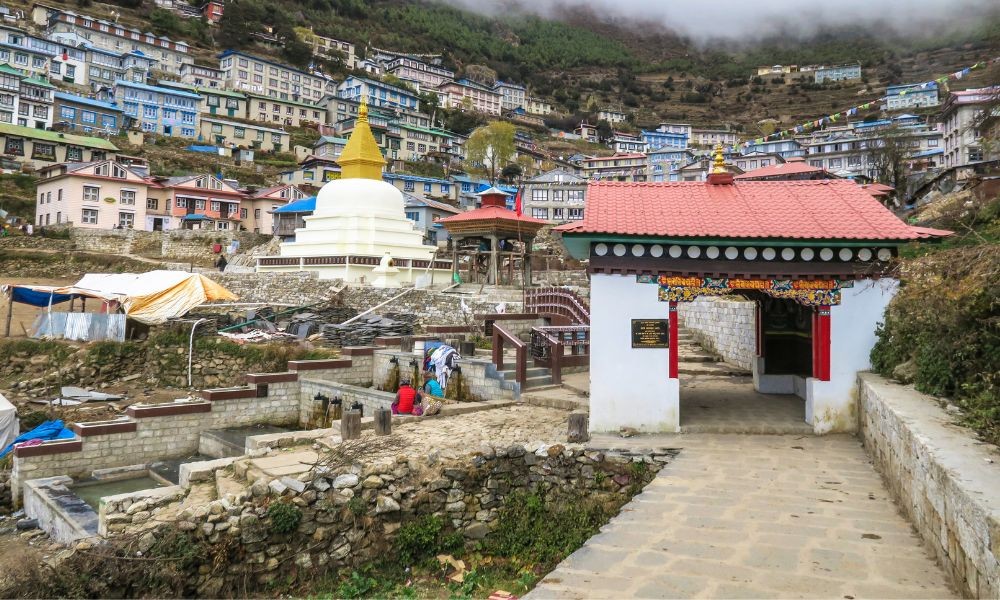
Cultural Experience in Annapurna Base Camp Trek
The Annapurna Base Camp Hike offers the opportunity to experience Nepal's diverse cultural heritage in addition to its stunning natural scenery. You'll pass through a number of traditional Gurung and Magar communities on the trek, where you can see for yourself how they live and behave.
As you engage with the locals, you'll discover more about their customs and society. From farming to traditional handicrafts, you can observe everyday life in these communities. You can also try some of the regional fare and beverages, like rakshi and dal bhat (lentil broth and rice) (a local alcoholic beverage).
Along the way, you'll come across several Buddhist monasteries and temples, where you can learn about the region's spiritual traditions. The trek also offers stunning views of the sacred Machhapuchhre mountain (also known as Fishtail), which holds a significant place in the local folklore and culture.
Overall, the Annapurna Base Camp Trek provides a unique opportunity to immerse yourself in the rich cultural heritage of Nepal while enjoying its natural beauty.
Cultural Experience in Everest Base Camp Trek
The Everest Base Camp Trek offers the opportunity to experience the area's distinctive cultural heritage in addition to being a strenuous adventure. The journey presents a chance to communicate with the Sherpa people, who are renowned for their fortitude, kindness, and mountaineering prowess.
You'll travel through a number of Sherpa villages on the trek, where you can learn about their way of life, culture, and traditions. You can observe their agricultural techniques and learn about the yak rearing process, both of which are crucial to their livelihoods.
Numerous Buddhist stupas and temples can be found, where you can discover more about the Sherpa people's spiritual practices. The Tengboche Monastery, one of the most significant Buddhist monasteries in the area, is the most notable of these.
You will have the chance to learn about the difficulties of mountaineering in the Everest area from the Sherpa people, who are known for their mountaineering prowess. Additionally, you can sample the delectable local fare, which includes meals like momos (dumplings), thukpa (noodle soup), and yak butter tea.
Overall, the Everest Base Camp Trek presents a rare chance to discover the natural grandeur of the area while immersing oneself in the Sherpa people's rich cultural heritage.
Traditions and Customs
During the Everest Base Camp Trek, it is worthwhile to learn more about the distinctive traditions and practices of the Sherpa community, who live in the Everest area. Some of the traditions and customs you might meet are listed below:
- Buddhism : The Sherpa people practice a form of Buddhism that is unique to the region, which is a blend of Buddhism and ancient shamanism. You'll come across many monasteries, chortens (stupas), and prayer flags along the trekking route.
- Mani Walls: Mani walls are long walls made of stones that are engraved with Buddhist mantras and prayers. You'll find these walls at several locations along the trek, and it's customary to walk around them in a clockwise direction while reciting the mantra "Om Mani Padme Hum."
- Sherpa Cuisine : A fusion of Tibetan and Nepali cuisine, momos, thukpa, and yak butter tea are just a few examples of the diet popular among the Sherpas. Along the trekking path, tea houses and lodges serve native cuisine.
- Sherpa Festivals: The Sherpa people hold a number of festivals throughout the year, such as the vibrant Mani Rimdu holiday, which is held at the Tengboche Monastery. Witnessing traditional dances, music, and cultural performances is possible at the event.
- Clothing: The Sherpa people have their own distinctive attire, which consists of a colorful apron, a woolen hat, and a long robe-like outfit called a chuba. On the trek, particularly in the villages, you'll see locals wearing their traditional attire.
Trekking Costs
Cost of annapurna base camp trek.
The cost of the Annapurna Base Camp Trek varies depending on several factors such as the duration of the trek, the route taken, the time of the year, the level of accommodation and services desired, and the trekking agency used. On average, a basic Annapurna Base Camp Trek of 7-10 days can cost around $500-$800 per person, while a more luxurious trek with better accommodations and services can cost upwards of $1500 per person.
The cost usually includes the necessary permits, transportation, food, accommodations, and a guide and porter. However, additional expenses such as tips, personal equipment, and travel insurance are not typically included.
It's important to choose a reputable trekking agency and clarify all costs and services included before booking a trek to ensure a safe and enjoyable experience.
Cost of Everest Base Camp Trek
The cost of the Everest Base Camp Trek varies depending on several factors such as the duration of the trek, the route taken, the time of the year, the level of accommodation and services desired, and the trekking agency used. On average, a basic Everest Base Camp Trek of 12-14 days can cost around $1000-$1500 per person, while a more luxurious trek with better accommodations and services can cost upwards of $4000 per person.
A comparison of costs
When comparing the expenses of the Annapurna Base Camp and Everest Base Camp treks , it's important to consider several factors such as the duration of the trek, the level of accommodation and services desired, and the trekking agency used.
On average, the cost of the Annapurna Base Camp Trek is generally lower than the Everest Base Camp Trek. A basic Annapurna Base Camp Trek of 7-10 days can cost around $600-$1000 per person, while a more luxurious trek can cost upwards of $2000 per person.
However, the cost of the Everest Base Camp Trek can vary widely depending on the factors mentioned above. A basic Everest Base Camp Trek of 12-14 days can cost around $1000-$1500 per person, while a more luxurious trek can cost upwards of $4000 per person.
It's important to keep in mind that additional expenses such as tips, personal equipment, and travel insurance are not typically included in the overall cost of either trek. Therefore, it's essential to do proper research, choose a reputable trekking agency, and clarify all costs and services included before booking a trek to ensure a safe and enjoyable experience.
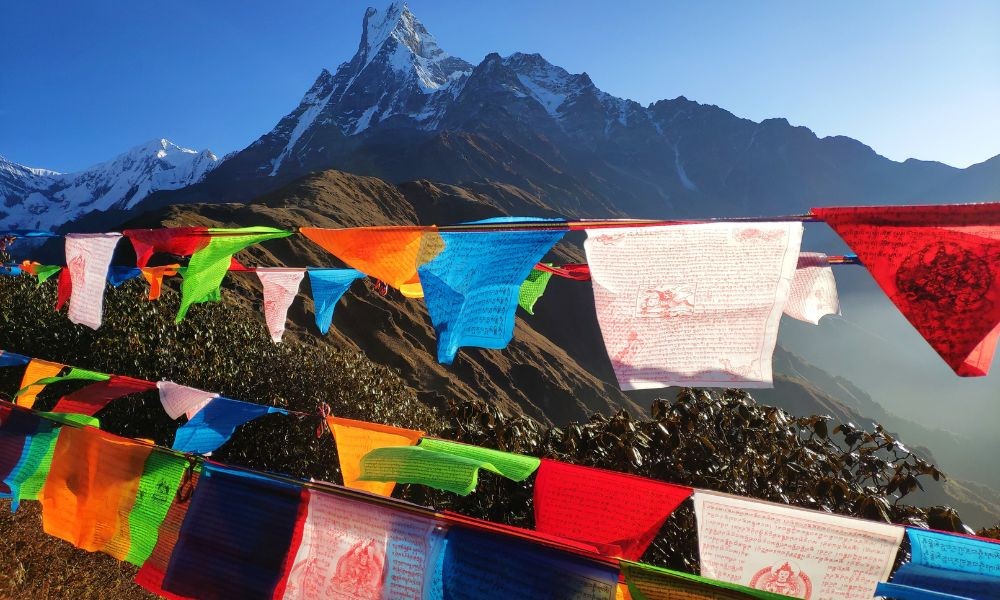
Comparison of the Annapurna Base Camp and Everest Base Camp Treks
In summation, the treks to Everest Base Camp and Annapurna Base Camp both provide unforgettable experiences that any hiker would treasure for a lifetime. The decision between the two treks eventually comes down to the trekker's preferences, interests, and physical capabilities, even though each has its own unique challenges, attractions, and requirements.
A shorter and easier journey that offers a variety of cultural encounters and breath-taking mountain scenery is the Annapurna Base Camp trek. Additionally, it is more reasonably priced, making it a well-liked option for backpackers. The Everest Base Camp journey, on the other hand, is a more difficult trek that provides unparalleled panoramic views of the highest peaks in the world. Additionally, it offers an opportunity to encounter the distinctive Sherpa culture and see the fabled Mount Everest.
Ultimately, whether you choose to embark on the Annapurna Base Camp trek or the Everest Base Camp trek, it is important to prepare well, understand the risks and challenges, and enjoy the journey. Both treks offer an unforgettable adventure that will stay with you long after you return home.
Which Trek to Choose?
Choosing between the Annapurna Base Camp and Everest Base Camp treks ultimately comes down to personal preference and goals.
If you're looking for a more challenging trek with higher altitude and breathtaking mountain views, then Everest Base Camp trek might be the better option for you. However, it does require a higher level of fitness and acclimatization, and it can be more expensive.
On the other hand, the Annapurna Base Camp trek is a great choice for those who want a more moderate trek with a combination of natural beauty, cultural experience, and lower elevation. It is also more budget-friendly and accessible for beginner trekkers.
Ultimately, both treks offer unique experiences and rewards for those who choose to embark on them. It's important to do your research, assess your fitness level and goals, and choose the trek that best fits your interests and capabilities.
Final Thoughts on Annapurna BAse Camp Trek Vs Everest Base Camp Trek
In conclusion, both the Annapurna Base Camp and Everest Base Camp treks offer incredible experiences for trekkers, but with unique features and challenges. The Annapurna Base Camp trek offers a relatively easier and more affordable option with diverse scenery and cultural experiences. On the other hand, the Everest Base Camp trek is more challenging with higher altitudes and offers stunning views of the world's highest peak.
When deciding which trek to choose, it is important to consider your fitness level, budget, time, and personal preferences. Whichever trek you choose, be sure to prepare well and take all necessary precautions to ensure a safe and enjoyable journey. Trekking in the Himalayas is a life-changing experience, and both of these treks are sure to leave you with unforgettable memories.
By this point, you probably feel confident about which trek to take. If you'd like to learn more about these treks, don't be afraid to get in touch with us or message us on WhatsApp (+977 9840092663). We'd be more than happy to share with you our knowledge and insights from both treks so you can create a unique vacation to the Himalayas!
- Annapurna Base Camp Trek Difficulty
- Annapurna Base Camp Trek Distance
- Annapurna Base Camp trek Blog
- Annapurna Base Camp Trek Accommodation
- Annapurna Trekking Region
- How Difficult is Annapurna Base Camp Trek
- Trekking in Nepal
- Treks in Nepal
- Trek in Nepal
- Annapurna Base Camp Trek
- Annapurna Trek
- Nepal Trekking
Send an Enquiry
Madan bhandari.
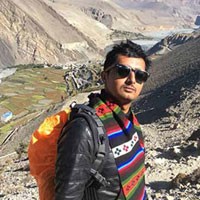
Recent Post

Festival of Colours Holi Celebration in Nepal
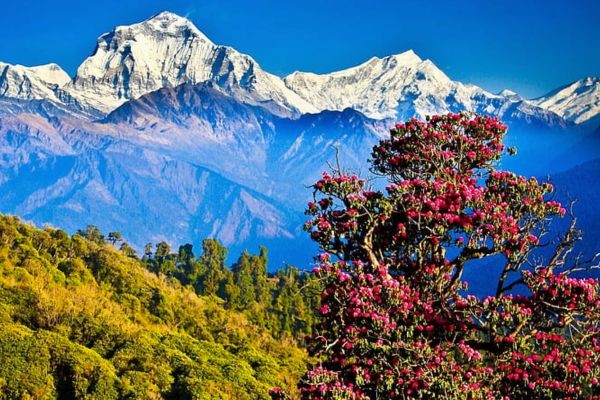
Unveiling the Mystique: 10 Reasons Why Nepal Should Top Your Travel List
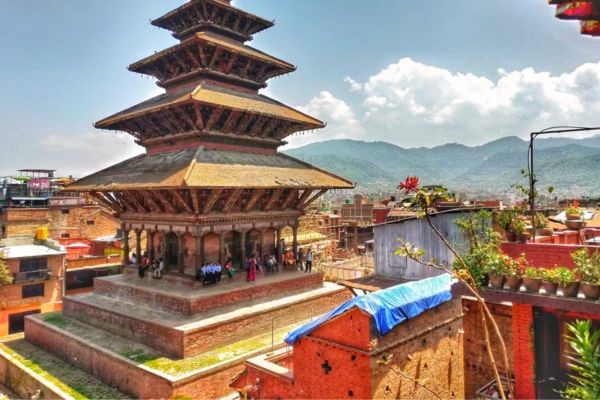
Top 12 Must-Visit Places in Enchanting Kathmandu
- About Langtang Region
- Annapurna Region trekking
- Everest Trekking
- Festivals in Nepal
- Travel and Tourism
- Uncategorized
Regulus Treks & Expedition P. Ltd

Everest Base Camp VS Annapurna Base Camp Trek
Hemanta budhathoki.
- Last Updated on Mar 24, 2024
Table of Contents
Most of the trekkers coming to Nepal for the first time want to reach up to the base camp of High Mountain and they start to search for it. Here on this blog, we discuss in details about Everest Base Camp Vs Annapurna Base Camp Trek. The most famous base camp trekking in Nepal is the Everest Base Camp trek and Annapurna base camp trek. For the first time trek planner, it might difficult to choose either to trek Annapurna or Everest base camp. Come to Nepal first time for trekking to one of the base camps with a professional company team, you definitely choose to come again for another one. You keep remembering mountain views, lovely peoples, cultural verities, landscape, and special taking care, that push you again to come back. Here we are clearly explaining Everest Base Camp VS Annapurna Base Camp treks so that you can easily choose which base camp is to go.
Trekking Duration Annapurna Base Camp trekking duration is from 8 to 12 days. Following the classical trekking route, ABC trek is a normal 10 days plan. You do not need any extra day staying for acclimatization on the way. Everest Base Camp trek duration is 12 days with 2 days acclimatization on the way before reaching to Everest Base Camp and Kalapathar. The minimum you can do is 11 days by skipping one-day acclimatization if you are feet with the altitude. There can be also 8 days Everest base camp trek if you do take a helicopter chartered flight back after reaching EBC to Lukla and Kathmandu which makes your trip cost high.

Accessibility of Annapurna Base Camp ABC trekking has got several ways to reach up to the trekking starting point. Trek starting point Nayapool or Ulleri is assessable of vehicle. Peoples can choose private car, flights, or regular buses to reach Pokhara and further. It depends on your budget level. It is easiest and cheapest then EBC. Now road facility is up to Ulleri village which altitude is 1,960 meters and place of the first day overnight. Pokhara to Nayapool is about one and a half hours driving distance with a private car. Local buses might take two and a half hours. If you start from Kathmandu, morning flight to Pokhara and drive to Nayapool or further to Ulleri to reach the first-day camp for an overnight in this trek. Driving from Kathmandu to Nayapool is about 8 hour’s journey.
Accommodation Accommodation in Everest Base Camp The Everest region is comparatively facilities with good accommodation. You can choose different accommodation facilities as per your wish. Deluxe guest houses chain has built to stay overnight for six nights in a total of 11 nights of this trek. Only 5 nights near Everest base camp are available simple tourist standard guest houses. (There are new hotel buildings even at Everest Base camp/ Gorakhshep) Overnight at Phakding, Namche, Dibuche, and Lukla for 6 nights, you can choose to stay in three categories of accommodation. Normal tourist standard guest houses which are still clean facilitate with attached toilet, warm dining, owed restaurant, and bar. Middle category guest houses are having a good room with a hot water bath, the hitting system inside the room, good dining, restaurant, and bar. High category hotels are providing better services with the same facilities. The cost of high category accommodation makes a huge difference in your total trekking cost.

Cost of EBC Trek VS ABC Trek
Comparing the Cost of EBC Trek Vs ABC Trek , Which trek is reliable and affordable? The cost of Everest Base Camp trek is more than you need to spend in Annapurna. Due to both way flight of Lukla, Permit, the cost of food, and accommodation, Everest base camp trek cost is higher than ABC. In Annapurna base camp trekking, you can choose local transportation to reduce the trek cost. Even using private transportation or flight does not meet the cost of Everest trekking. The cost of food and drinks on the way is similar in both treks.
Altitude The highest altitude you reach during Everest base camp is 5,545 meters Kalapather climbing and 5,360 meters at Everest base camp. When you fly to Lukla from Kathmandu, you land at 2,860-meter altitude. The altitude than start to be higher every day unless not reaching to EBC. This trek is a wonderful high altitude trek. During the Annapurna base camp trek, you start from 800-meter altitude and slowly reach up to 4,200 meters till Annapurna Base Camp. Every day you will gain less altitude than EBC so that no need any acclimatization day on the way.
Mountain View Mountain you will see during Everest Base camp trek Both trek, you will reach right into the heart of the mountains. In EBC trekking, you start to view mountains from the second day of the trek. Two mountains over 8 thousand meters (Mount Everest 8,848m, Mount Lhotse 8,516m, can be explored with other ranges. During the whole trekking, there are different views of the mountains. Amadablam (6,812 meters) is more shiny and attractive in this trek almost every day. Mt Pumori 7,161 seems higher and most closed from Kalapathar and Gorakshep. The best viewpoint is from Kalapather , where you have to climb early in the morning for sunrise or evening to explore the best sunset.

Landscape Annapurna and Everest base camp trekking region gives Nepal’s best divers landscape. The landscape of Annapurna base camp is dense forest, big hills with lots of ups and downs. Less vegetation area begins only from 3,500 meters near the base camp. The trekking trail is full of different Rhododendron forests. It blooms beautifully every spring season. Waterfall, White Water River, typically made bridges over Rivers. Landscape in the Everest Base Camp trek is a bit different than ABC region. The low land region is dense forest. Less vegetation area starts from the Dingboche area the elevation from 4,400 meters. There are ice crevasses to walk for two days nearby base camp. Trekking stars from an altitude of 2860 meters to reach 5,545 meters with lots of ups and downs.
Side trip Side trip in Everest Base Camp The main suitable side trip to EBC is Gokyo valley. The beautiful blue lakes and mountain views from Gokyo valley and from Gokyo-Ri is one of the best ever seen from any part of the Everest region. It is possible to view four 8000 – meter peaks, Mt Everest, Lhotse, Makalu, and Cho-Oyu. Another side trip to this trek is climbing some climbing peaks. Island peak (6,189m) and Lobuche Peak (6,119m) are climbing peaks for beginners and very closed from Everest Base Camp. Climbing Kalapathr is another side trip in this trek. Early in the morning climb for best sunrise and evening for best sunset view with the closer view of the high Himalaya including the best view of Mt Everest. Visit some of the famous monasteries in also good side trips in EBC. Tengboche monastery in on your on the way and spend a night very nearby.
Side trip in Annapurna base camp The classical trekking route is starting from Pokhara to Ghorepani Chhomrong. Back to Pokhara is via Chhomrong and Jhinu. Side trip in this trek is not many options like EBC. You still can add the Mardi Himal region and visit Lwang village to get a pure homestay experience. Ghandruk village, another unique Gurung village is another side trip in this trek.
Best season The best season for Everest Base Camp trekking is seasons of spring and autumn. The month of March, April, May, and September to November is the warm temperature in this region. Sunny days with blue sky make the best view of the region. Although the beginning of the June and December months are still suitable to make Everest base camp trek. Raining season weather is the fuggy covered the Himalayan range most of the time. The B est season for Annapurna base camp trekking is also in the same months of spring and autumn. Relatively, this trek is still more suitable in winter like the month of Dec, Jan and Feb. although raining moths Jun to Aug is difficult with sleeper path, landslide, and leeches.
Verity in Itinerary Both Everest and Annapurna base camp trek itinerary can be customized in different ways. If anyone looks to make a normal itinerary to short itinerary, there is a way to make it, and peoples who have enough days to explore more around, there are many ways to add activities to make a longer day plan. Minimum days can be made 8 days itinerary for Everest Base Camp trek, which can be trekking till base camp and Helicopter back. 8 days trek to ABC can be suitable for those who are used to in high altitudes and able to walk along every day.
Everest Base Camp VS Annapurna Base Camp! Which Trek is more Difficult?
What do you think, Which is more Difficult to Trek? on Everest Base Camp VS Annapurna Base Camp? We let you know that the Everest base camp Trek difficulty level is comparatively strong than Annapurna Base Camp due to its altitude level. Land at Lukla airport is already 2,860-meter altitude. The entire route is into high altitude trek with lots of ups and downs. Dryland with the heavy wind at the altitude up to 5,545 meters can be difficult for more trekkers. Annapurna base camp trek starts from 800 meters and gradually walking up to 4,200 meters only. Green trees are available at its highest level and busty lands up to the base camp so that still good oxygen level available up to base camp which helps easy breathing.
Which Trek is Crowdy? Everest Base Camp or Annapurna Base Camp?
Both trekking in the main season is a crowd of trekkers. Due to overcrowding, accommodation might not be enough in the area of base camp. There are only a few guesthouses accompany trekkers which sometimes not be able to provide rooms. By this result, trekkers have experience sleeping in dinning and sharing rooms. This kind of situation may come in Everest in Lobuche and in Gorakhshep that is for two nights. In Annapurna, Deurali, Dovan, Himalaya, Machhapuchhre, and Annapurna base camp for 2 nights can be difficult finding accommodation in heavy season. If you want to skip the crowd, choose to trek in off-season time. Winter and summer months are off-season and the region is with fewer peoples. Trekking to EBC in winter is better than in summer. Similar to ABC.
Local Peoples and Cultures Everest region is culturally rich and Annapurna base camp too. Homage of Sherpa, their traditional cultures can be explored nearly during your trek to EBC. The Everest region is the homage of Sherpa peoples. Sherpas are similar to Tibetan. Their customs, Language is similar to Tibetan. Mostly peoples are practicing Buddhist religion. The typical rituals can be seen during the main festival. Annapurna base camp is with a different cast of peoples. They are also indigenous peoples of Nepal. A big number of peoples in this region is Gurung. They are one of the main Gurkha tribes. Local peoples show traditional dance with their folk song at the evening in the main villages, which is a memorial experience in this trek.
Safety Everest base camp and Annapurna base camp both are safe to trek. Due to high altitude treks, it is important to trek with someone taking care. Trekkers have to have good trekking equipment. It is also best to take a porter to carry your goods and guide to lead these treks which are safer. Do not walk alone
Group Joining Trek Group trek is not compulsory in both treks. If you take your own guide and porter, it is much comfortable to customize your plan. It is easy to change your plan as per your interest and your condition. Trekking alone is better to join a small group tour which makes your trip cost less too. Nepal highland treks are also operating Everest Base camp small group trek . Group trek up to 10 peoples at a time is more comfortable. More than ten pax in a group is not recommended in the case of providing quality services. A small group trek to Annapurna base camp can be also the best idea. Getting in touch with other peoples from different countries, share different experiences is the benefit to join small group trek in Nepal.
Communication facilities Internet and telephone signals are available up to Everest base camp and Kalapathar. One day at Lobuche, another day at Pheriche is a bit difficult for the signal. It is better to buy a Nepali sim to use the telephone and data for the internet. Local telephone and internet cyber is only available easily up to Namche in Ebc trekking. Similarly in ABC trek, it is better to take your own local SIM card for a better communication facility. There is not much availability of local telephone and internet cyber. After Deurali for 2 days trekking, the telephone signal might not reach.
Trekking with guide Trek without a guide for both of this trek is not recommended. Both treks are high altitude trek and need someone to support. Have your own team; share the experience, get information from a guide is to make your trip memorial. It is highly suggest trekking with a guide in these both treks.

Hemanta Budhathoki is team leader of Nepal Highland Trekking and travel company.
Ask a Question

Kailash Charan Sparsha

Exploring the heart of the Everest Region: Namche Bazaar

The Beauty of Rara Lake Trek | Rara Lake Tour Package

Eagle Eye Treks And Expeditions

Annapurna vs Everest Base Camp Trek

Nepal, covered with hills and mountains, is the perfect destination for trekking. There are many trekking routes available in Nepal. The trek that takes to the base camps of different mountains is much popular.
The Annapurna Base Camp Trek and Everest Base Camp Trek are two most extensive trekking in Nepal.
Sharing the base of the highest peak in the world, the Everest Base Camp trek is the most popular one. But, Annapurna Base Camp is popular for its beauty and well enough to trek year round.
It is hard to choose the best trek among Annapurna and Everest Base Camp Trek.
Both of these treks are fabulous and remarkable and are the most desired trekking route.
Annapurna Base Camp Trek is a moderate trek with the beautiful scenery of villages, hills, forests and mountains, waterfalls etc all over the trekking trail. It is the perfect destination for novice trekkers.
While Everest Base Camp Trek is an adventurous and tough trekking route among all the trekking route in Nepal. It is the ideal trekking trail for the experienced trekkers.
Both the trekking routes take you to the high altitude, of about 5000 m from the sea level. You get to explore the diverse terrains in both the Annapurna region as well as the Everest trekking trails. The area of Annapurna Trekking trail is rich in its biodiversity.
As mentioned above, Annapurna Base Camp Trek is perfect for novice trekker. Everest Base Camp Trek is challenging trek so it is a bit harder for the first-time trekkers.
How to get there?

Annapurna Base Camp Trek
To get to Annapurna Base Camp you need to take a bus ride or flight from Kathmandu to Pokhara. The bus ride is approximately 6 hours along the river Trishuli.
You will reach directly to Tikhedhunga if you choose the bus ride. If you choose a flight from Kathmandu you will land at Pokhara Airport. And you have to travel by bus or taxi to Tikhedhunga from Pokhara. Tikhedhunga is the place where your Trekking Journey begins.
Everest Base Camp Trek
The first Mount Everest summiteer Sir Edmund Hillary and Tenzing Norgay summited the Mount Everest on foot from Kathmandu in the 1950s. No proper roads or proper transportation facility was available then.
The trekking route from Jiri is the trail from where Sir Edmund Hillary and Tenzing Norgay commenced their journey to Mount Everest.
To get to Everest Base Camp, the often-used starting point of actual trekking journey is Lukla. You take a 45 minutes flight from Kathmandu to Lukla.
Do you have any question or Confusion?
- Full Name *
- Your Email *
- Contact No.
- Nationality
- Your Message *
The Locals and the Ethnic Community
Annapurna Base camp trek
You will come across a lot of local ethnic communities on the trekking trail of Annapurna Base Camp Trek.
This trekking region includes diverse ethnic tribes such as Gurungs, Magars, Tamangs, Thakalis, Brahmins, and Chhetris.
A large village of Gurung is present in the Annapurna region. With the diversity in communities, there is diversity in the religion too.
You can observe Hinduism, Animism, and Buddhism in this region. A unique gesture of welcoming and respecting the visitors is the good part of the people in this region.
There isn’t such a variation in the ethnic community here. You will find the similar type of tradition and culture among the locals in the Everest region .
The whole region is the habitat of the Sherpas. Their culture and tradition are dependent on Tibetan culture.
People of this region totally depend on tourism. These days, tourism has contributed a lot to uplift the economic standard of the locals. Most people in this region are Buddhists. You will come across various Chortens, Mani walls, prayer wheels and flags, and Buddhist monasteries across the route.
Mountain Views and the Scenery

The Annapurna region is the most beautiful place with a picturesque scenario. You get to view wonderful landscapes of hills and mountains. And blooming forest of rhododendron in spring.
You will find magnificent waterfalls and the rivers on the way to Annapurna Base Camp.
You will get the panoramic view of Annapurna II (7937m), Annapurna III (7555m), Annapurna IV (7525m), Annapurna South (7219m), Tent Peak (5663m), Hiunchuli (6441m), and Gangapurna (7455) from the base camp.
On the day fifth of your trek, you will be hiking to Poon Hill-a photographer’s paradise. The view of sunrise from behind mountain ranges such as Dhaulagiri, Annapurna, and Fishtail Mountain is spectacular. And, the panoramic views of changing hues of peaks from Poon hill is breathtaking.

Everest Base Camp Trek is an adventurous trek that takes you to the footstep of Mount Everest.
It is a tough trekking route but the picturesque views from the entire trekking trail make it worth traveling. You will get to view the mountain scenery and small settlements somewhere between the huge rocky hills.
The alpine forest view in the lower region of trekking route is alluring.
Snow-capped mountains: Mt. Everest (8848 m), Mt. Lhotse (8,516 m), Mt. Nuptse (7,855 m), Mt. Changtse (7,550m), Mt. Pumori (7,161m), Mt. Amadablam (6,856 m), Mt. Lingtren (6,679 m), Mt. Thamserku (6,723 m), Mt. Kantega (6,685 m), Mt.Kusum Kanguru (6,367 m), Mt. Twitch peak (6,367 m), Mt. Cholatse (6,335 m), Island peak (6,179 m), Lobuche peak (6,145 m), Honku south peak (6,119 m), Mt.Kongde (6,011 m), Mt. Khumbila (5,761 m), and Pokalde peak (5,806 m) are visible from the different places of the trekking trail.
Buddhist monasteries, plenty of prayer flags and wheels, Mani walls on the trail add up the beauty to the Himalayan landscape.

Annapurna Base Camp trek
The lower region of Annapurna Base Camp Trek is nearer to the city, that’s why you will get to enjoy the variety of cuisines.
Most of the teahouses will provide you with breakfast, lunch, and dinner.
The local cuisine: Dal (lentils), Bhat (rice) and Tarkari (vegetables) is the most common in every tea house. If you wish to eat other items you can order it and you will get to eat if that is on their menu.
As Everest Base Camp Trek is the most popular trekking routes, you will get any kind of food there. Ranging from the local cuisine and other western cuisines.
Since it is the rural area, porters and mules carry the food to the higher elevation from the lower villages.
Although you can get varieties of food here, you cannot get fresh veggies and fruits here in the altitude.
Cost is somewhat the same in terms of quality and service in both these treks.
The cost of Annapurna Base Camp Trek is a lot more affordable in comparison to the Everest Base Camp Trek. The reasonable food and accommodation cost makes this trek more reasonable.
The cost is a lot different in the higher altitude than at the lower altitude.
Everest Base Camp Trekking is pretty expensive. The reason behind the expensive cost is, it’s remote geography. As the altitude rises the cost of food and accommodation also rises.
Plus, the trekking permits and other costs in the Everest region is quite expensive than Annapurna region.
Accommodation

With the growing tourism industry, a lot has changed since the early years. A lot of tea houses are available at both the trekking routes.
Annapurna Base Camp trekking route celebrates a bit standard facilities.
You will find a simple attached bathroom and a bedroom. Most of the tea houses offer the combined bathroom and separate bedrooms.
Everest Base Camp
Everest Base Camp trek facilitates trekkers with standard facilities. Because of the number of trekkers trekking to this region, the services are much better.
The trekking route is a lot more developed in comparison to other trekking routes in Nepal.
But, the stops at higher altitudes will only provide you with the basics.
In general, you get a single room with attached bathroom in lower altitudes. And at higher altitudes, the lodges and hotels provide you with the indoor but a shared bathroom.
Best seasons to trek
Annapurna Circuit Trek
Autumn season in Nepal is the best time to trek in Annapurna Base Camp Trek. Especially, the October trek is an appropriate one.
But you can trek in the Annapurna Base Camp in any season with some preparation. After autumn, spring is another great season to trek. The trekking route is beautiful with the blooming of rhododendron and magnolia.
The weather in the autumn season and spring season are quite similar and favorable. The days are warmer while the nights and morning are cold.
Alike Annapurna Base Camp Trek, the best season to trek in the Everest Base Camp Trek is during the autumn season.
It is best to trek Everest region in October and November. The weather will be moderate with the crystal clear skies and no traces of clouds.
Difficulty Level

Compared to Everest Base Camp Trek, Annapurna Base Camp Trek is not much challenging and is a lot less tough.
There is minimal chance of getting altitude sickness. This eases the trek in a long run.
This trek starts from the altitude of 1480 m (Ghandruk). And you may not need to acclimatize up to the elevation of 4130 m (Annapurna Base Camp). There is very less chance of altitude sickness.
But precautions are absolutely essential.
Everest Base Camp Trek is a lot more exciting and challenging. It is tougher than Annapurna Circuit Trek.
Altitude is the main reason in making this trek a lot challenging and adventurous. But Proper gear and equipment make it a lot easier.
The trek starts from 2860 m (Lukla) and takes you to the altitude of 5380m (Everest Base Camp). You need to acclimatize twice at several trek points. This is important and precautionary to avoid altitude sickness .
The Annapurna Base Camp Trek and Everest Base Camp Trek are two different trekking destinations that share some similarities as well as differences.
Both the treks direct you to the base camp of well-known Himalayas.
Annapurna Base Camp trek is less strenuous yet adventurous trekking. Whereas the Everest Base Camp Trek is tough and strenuous but the most adventurous trekking.
For the experienced trekkers, Everest Base Camp trek will be a perfect destination. Whereas, the Annapurna Base Camp Trek is great for the novice trekkers.
For further assistance and details please do contact us .
- Nationality *
You may also like...

Everest Base Camp Trek 16 Days

Annapurna Base Camp Trek Route

Mardi Himal Trekking Map

Himalayas on Foot
Local Trekking Company in Nepal
Annapurna Sanctuary Trek vs Everest Base Camp Trek

Without a doubt, the Everest Region and the Annapurna Regions are the most popular trekking regions in Nepal. The previous for having the tallest mountain in the world and the latter for being one of the most beautiful mountain ranges.
Thousands of trekkers from all over the world visit Nepal, only for the majestic views from both regions.
Most trekkers are always torn between taking an Everest Region Trek or the Annapurna Base Camp Trek. It is obvious that the choices would gravitate towards the Everest region treks. You get to the foothills of the highest mountain in the world.
Nothing to beat that!
But wait till you browse through the Annapurna Range and the region.
One look at those breathtaking views of the Annapurna Range and you will want to go there too. Now you are torn between choosing among two amazing regions.
Trekking to the Himalayas once is never enough.
The views and hospitality will leave you craving for more. Your appetite for the mountain, the culture, and the hospitality will only increase when you have experienced it once. If you choose to take the Everest route this time, you will definitely come back for the Annapurna Mountain Range Treks.
Everest and Annapurna region each have amazing trekking routes. You can choose any of these treks can get an up-close view of the mountain ranges. Here, we are going to compare two amazing treks – Annapurna Sanctuary Trek and Everest Base Camp Trek .
Getting to know the Regions
Annapurna region.

Besides having the stunning views of the mountain ranges, Annapurna region is also described as a paradise by nature lovers.
Trekking in this region will offer you a spectacular view of the Annapurna Range, Dhaulagiri Range, Mount Manaslu, and Mount Machhapuchhre. The landscape, wild animals, and monasteries along the way all make Annapurna region a very captivating and a memorable one.
You will be able to indulge in culturally diverse treks. Annapurna region has a very diverse population from Brahmins to Sherpas. So, the region offers you more chance to interact with the local people, their culture, and tradition.
Annapurna Region also has good tea houses with great service, since the region is one of the more popular ones.
- Contact Number *
- Your Message *
- Please press 5 to submit *
Everest Region
The Everest region lies in the north-east side of Nepal. The region is most famous for the gorgeous panoramic views of Mount Everest.
Besides this, Everest region has many Buddhist Monasteries spilled all over the region. Not to mention the warm hospitality of the Sherpa communities that live in the area.
Everest region treks are generally termed difficult in compared to the Annapurna region due to the altitude of the region. But you need not worry about altitude sickness as there many tea houses along the way providing luxurious accommodation and service.
Talking about the terrain you will experience everything from rugged rocky valleys to alpine forests and meadows to neat Sherpa Villages to glaciers and icefalls.
Trekking in Annapurna vs Everest
Annapurna sanctuary trek.
Comparatively, Annapurna Sanctuary Trek is a little less challenging and less difficult trek than the Everest Base Camp. The altitude of this trek is 4,130 meters at its highest point.
The trail is more achievable as it has fewer demanding uphill climbs. For this reason, the trek has merciful descends that do not hurt your joints in the longer run.
Annapurna Sanctuary Trek is a more favorable option for you if you are a novice trekker or want to test your trekking abilities in Nepal.
The Annapurna Region has many routes. So, you can opt to take a different route while you travel down Annapurna Sanctuary.
Everest Base Camp Trek

Everest Base Camp is the most iconic trek every trekker dreams of achieving. It is, however, more challenging and adventurous than the Annapurna Sanctuary trek.
The altitude of the trek is quite high which makes the trail a challenging in compared to the Annapurna Base Camp. The highest point of the trek stands at 5380 meters above sea level.
It is recommended that trekkers take proper breaks to adapt to the altitude as they climb their way up to the Everest Base Camp. This is to prevent altitude sickness.
Getting to Annapurna vs Everest
Your journey on foot to the Annapurna sanctuary trek starts from Nayapul. Nayapul is at least one and half hour bus ride away from Pokhara.
Pokhara is a small laid back valley, also known as the tourist capital of Nepal. The lakeside hotels and bars will give you many options to relax in the city.
You can easily get to Pokhara from Kathmandu via a bus ride or a flight.
You can start your Everest Base Camp experience in two ways.
First, a 40-minute scenic flight to the Tenzing–Hillary Airport in Lukla. The scenic journey to and from Kathmandu is worth the cost.
The second, you can also get on a bus ride to Jiri. A lot of local tourists walk from Jiri to avoid the Lukla flight expenses. The bus ride to Jiri is definitely cheaper than catching a flight to Lukla.
Opting to start your trek from Jiri, lets you enjoy five to seven more days of exploring the cultures of Nepal.
Mountain Ranges and Scenery of Annapurna vs Everest
Annapurna Sanctuary Trek offers a constant view of the snow-capped Himalayan range. The mountain ranges are a constant backdrop throughout the trail.
The mountain ranges you will be able to see Mount Annapurna South, Mount Annapurna I, Mount Annapurna III, Mount Himchuli, Mount Gandharva Chuli, Mount Gangapurna, Dhaulagiri ranges, Mount Manaslu and Mount Machhapuchhre.
You will find the gorgeous lowlands trail as captivating as the snow-capped mountain range vistas. The green terraced fields, the Dhampus ridge, the Gurung villages and the Hinko cave will all make the trail a perfect one.
The first few days of the trip you will be trekking into the deep canyon of the Modi Khola River. Not to mention that the dense forests you will walk through will be decorated with rhododendrons, roses, apricots, and other flowers. Most of the flowers, including rhododendron, will be in full bloom in April.
The rivers, waterfalls and suspension bridges will not let the trail lose its charm.

You get the stunning view of the highest, wildest and the most dramatic mountains in the world. Due to the altitude, it is definitely challenging but it should not be an issue if you acclimatize well. The views are spectacular.
The mountain ranges you will witness on the trek Mount Everest, Mount Lhotse, Mount Nuptse, Mount Pumori, Mount Changtse, Mount Lingtren, Mount Amadablam, Mount Thamserku, Mount Kantega, Mount Kusum Kanguru, Mount Kongde, Mount Khumbila, Mount Twitch peak, Mount Cholatse, Island peak, Lobuche peak, Pokalde peak, and Honku south peak.
The trail isn’t all barren until you see the mountains. You will pass by stunning landscapes, glacial lakes, foothills, and not to mention the peaceful Buddhist monasteries.
Communities and Culture of Annapurna vs Everest
Annapurna Sanctuary Trek is rich and diverse in terms of the cultural experience you will be able to take away. This makes exploring the trek a culturally rich experience.
The circuit will take you through numerous rural settlements that cling to the sides of the valleys.
These settlements are filled with local ethnic communities from Brahmins, Chettris to Thakalis, Magars, Tamangs, Gurungs to Tibetan Sherpas.
Although, the dominant communities you see throughout the trail are that of the Gurungs and Magars.
If you are looking to get more in touch with the culture of Nepal, Annapurna Sanctuary Trek is definitely the one for you. The trek will, obviously, give you a taste of the lifestyle and heritage of a wide range of cultures along with the view of the Mountain ranges.
The Everest Base Camp route is predominantly a Sherpa territory.
The Sherpas residing en route and on the Everest Base Camp are said to have moved from Tibet a long time ago. This is why the lifestyle, culture, and heritage in the area are heavily influenced by Tibetan cultures.
The Everest Base Camp is majorly inhabited by one culture. This lets you understand the one culture in a unique and close way.
Also due to the popularity of this region, you can experience the display of pseudo-culture as well.
Accommodation at Annapurna vs Everest
The accommodation throughout the Annapurna Sanctuary Trek is similar to the Everest Base Camp. Since the route is one of the more famous ones, the tea houses along the way have good quality and service.
The only difference you will notice is the Annapurna Sanctuary trek has traditional squat toilets as compared to the western toilets in Everest Base Camp.
Some of these tea houses have attached baths while other have a common bathroom system. The common bathroom is usually outside of the tea house. The thing about common toilets is you can talk to other trekkers while you wait your turn.
The Everest Base Camp trek is more popular than the Annapurna Sanctuary Trek. So naturally, the accommodation on this trek is better than Annapurna trek. The tea houses and the services they provide are more luxurious in this trek.
The tea houses have tourist standard bedrooms to accommodate the trekkers. Most of the tea houses have western toilet systems as opposed to the more prevalent squat toilets on the Annapurna Sanctuary Trek.
The tea houses in the lower altitude also have attached bathrooms. The bathrooms in the higher altitude are on sharing basis.
Food at Annapurna vs Everest
Both Annapurna Sanctuary Trek and Everest Base Camp are popular destinations. So, you will be able to get similar quality and service when it comes to the food menu.
The tea houses along both trails will all have the staple trekking food Dal Bhat on their menu for both lunch and dinner.
The tea houses also provide a selection of western dishes besides Dal Bhat on their menus. The tea houses will provide meals three times throughout the day – breakfast, lunch, and dinner.
Annapurna Sanctuary Trek comparatively has more fertile land. The terrain itself gives this away with the terrace farmings and vegetable patches you will pass and see near the tea houses.
Most items on the menu will be made of fresh and organic food. Along with plenty of fresh vegetables.
The food on Everest Base Camp is fresh in the lowers regions.
The harsh weather on the higher elevations hardly lets you grow anything other than potatoes. So the food in the menu won’t be as fresh as that of Annapurna Sanctuary Trek. The variety on the menu though more than makes up for it.
It is recommended to choose the vegetarian menu. But due to the modern influence, don’t be surprised if you get to enjoy western delicacies like pizzas or cakes
Cost of Annapurna vs Everest
Annapurna Sanctuary Trek is generally more affordable compared to Everest Base Camp.
The cost of the accommodation and food is more reasonable on this trail. The food is more reasonable because they are freshly grown in most parts.
The transportation is another variable that makes the cost more reasonable. The bus to Nayapul if far cheaper than the flight to Lukla. However, the roads on the route are a work in progress.
If you choose to take a flight to Pokhara then your overall cost could go a little high. It will not impact your budget too much though.
The cost of trekking in the footsteps of the highest mountain in the world is more expensive. There are various reasons that will have you spending a little more on the Everest Base Camp Trek. The first is the permits to the Sagarmatha National Park are higher.
The tea houses on this trek also provide the best accommodation and services, that makes it a little more expensive.
The food will be one of your biggest spending areas. The access to transportation via vehicle is almost nil in this region. So, the food and goods available on the trek need to be carried up to the level by porters. This is the reason why the food is more expensive in the Everest region.
Your budget will take a hike if you choose to take a scenic flight to and from Kathmandu to Lukla. You can choose to save up by taking the bus to Jiri.
Weather and Best Seasons of Annapurna vs Everest
Weather is another factor you need to take into consideration for both treks. These are long treks and you will want the best views!
For the best views, you should choose among the two peak seasons i.e Spring (March, April May) and Autumn (September, October, November). Also, these are safer weather choices. If the weather is not a problem for you, you can opt for winters too.
The best time to go on the Annapurna Sanctuary Trek is during the peak seasons. During these months the weather is at its best. You will get clear skies and a beautiful view of the landscape and the mountains.
Choosing the month is on you and what you like to see in your experience to the Himalayas. Do you prefer the flowers in their full bloom or when the leaves are decorating the path? The warm temperature or when the air is crisp and cool?
If you prefer the warmer temperature and the hills draped in blooming flowers, you should choose Spring Season. If you prefer the leaves painting the trails and cooler temperature you should choose the Autumn season.
The best time to trek in Nepal is during the peak seasons and the Everest region is not immune to that. The clear skies and the near-to-perfect views of the mountains are all you can expect during the peak months.
Everest Base Camp trails are the busiest during October and November.
P.S. The roads and the tea houses on both the treks will be crowded during the peak months. So, we would recommend you plan and book the room at different stops beforehand. This lets you enjoy the walk rather than hurry to your destination. Contact us for further details.
The Everest Base Camp Trek or the Annapurna Sanctuary Trek? This is a question every avid trekker asks themselves.
One offers to take you to the foothills of the highest mountain in the world – Mount Everest while other promises a beautiful journey complete with the picturesque view of the Annapurna Range. Both trails have diverse experiences and views to offer, which makes it an even harder decision.
Choosing one is a tricky decision to make.
If you are looking for a trek filled with challenges and epic mountain scenes, choose the Everest Base Camp Trek. But, if you are feeling like an easier trek with diverse cultural experience Annapurna Sanctuary Trek is up against your alley.
Either way, you will go back home with magical pictures, incredible experience, and bragging rights. You will also be back next time to triumph the next trek.
You may also like...

Ghorepani Poon Hill Trek Cost

3 Day Trek To Everest Base Camp

12 Day Everest Base Camp Trek

- Adventure Activities
- Festivals And Culture
Hiking And Trekking
- Peak Climbing
- Sightseeing Information
- Tourism Info
Trekking Information
Everest base camp trek vs annapurna base camp trek.
Which trek do you prefer: Everest Base Camp Trek vs Annapurna Base Camp Trek ? Approximately, every fresh enthusiastic trekker is confused, about which one is best, EBC or ABC? Amusing, this journey is not only about conquering mountain climbs but also boosting yourself for many other challenges.
Well, it’s the often asked question by most travel junkies and the reply is that neither should be avoided. I advise you to trek both. Oh, the big question ‘WHY’ might have crossed your mind. While both journeys have their aromas and distinctiveness, picking one and neglecting the other is a folly you’ll come to regret later. Both of the trekking is admirable and everyone’s fantasy vacation spot.
Annapurna Base Camp was classified as a “Once-in-lifetime experience excursion” by National Geographic and Tripadvisor, while Everest Base Camp was featured as a “Travel location” in 2020 by National Geographic and Tripadvisor. Since then, the majority of adventurous junkies end up hiking both. Adhere, exploring Nepal just once isn’t enough; you want to go back and discover more.
How to get there? – Everest vs Annapurna
How to go to everest base camp.
Lukla is the starting point for a tour of the Everest Region. To begin your Everest hiking journey in Nepal, fly from Kathmandu to Lukla via the picturesque Tribhuvan International Airport. This is the most usual way most trekkers pick to get to the Khumbu region, to explore the stunning Everest view.
Alternatively, you might take the typical 8-hour trip from Kathmandu to Jiri to begin your dream journey. This long though exciting way to reach Everest Base Camp takes you across the route of Tenzing and Hillary. You may continue your Everest Base Camp Trek via Jiri to Lukla by walking. However, if you opt to trek over this ancient path, you would require an extra week to reach Lukla or Namche. How long you stay at Everest base camp depends on the path you take.
How to go to Annapurna Base Camp?
Nayapul is the starting and ending location of the Annapurna Trek. To begin, fly from Kathmandu to Pokhara on a picturesque flight. From TIA, it takes about 20 minutes to get to Pokhara, Nepal’s most popular tourist destination. The breathtaking view of the mountain panorama, hills, and basin from above is a once-in-a-lifetime event.
The other way to reach the Annapurna region is to take a 6 to 8-hour drive to Pokhara. Following 45 min of driving from Pokhara, you will arrive in Nayapul or Tikhedhunga, where you can commence your trek to the Annapurna region. You may alternatively begin your Annapurna Circuit hike in Besisahar, about an 8-hour drive from Kathmandu.
Everest Base Camp Trek view:
The Kathmandu to Lukla flight allows passengers to float over the landscape and take in its breathtaking grandeur. Hiking to the peak of Everest is without a doubt the most popular hiking destination in the world. In addition, Kala Patthar is the perfect point from where you can spectate the greatest dawn or sunset and vista of the big Himalayas, including Mt. Everest.
If you’re just visiting Nepal for the highlands, the Everest Base Camp Trek will pique your interest. Every backpacker’s primary goal is to acquire a close-up photo of Mt Everest, the world’s highest peak. Also, this trek allows you to view the wowed vistas of Mt. Nuptse, Ama Dablam, Pumori, Lhotse, and other adjacent peaks. Hikers are also enticed to do the Gokyo Valley Trek by the valley’s calm lakes.
Thousands of holidaymakers are welcomed each year by fluttering devotional flags, suspension bridges, Mani walls, and historic monasteries on campgrounds. The trail runs past the little hamlet of Sherpa communities. You can get to see the large number of trekkers prepping to reach the pinnacle of Mt. Everest in peak season.

Annapurna Base Camp Trek view:
The stunning mountain views during the Annapurna Base Camp Trek will never cease to astound you. From the early day of this Annapurna Base Camp journey, you will be able to witness the staggeringly beautiful Himalayan panoramas. You’ll pass through woods, terraced rice fields, oak trees, rhododendron groves, and local folk’s small and major village valleys.
You’ll pass via woods, terraced rice fields, oak trees, rhododendron groves, and local folk’s small and major village valleys. During the spring season, the woodland of blossoming flora will delight you all along the walk. Following a few days of trekking, a dawn hike to Poonhill delivers the best picturesque vista. The golden glory snow-capped mountains i.e. Annapurna Himalayan range, which includes Mt. Dhaulagiri, Fishtail, and many other unrecognized summits can be glimpsed.
When you reach the peak of Annapurna, spin 360 degrees and you will be encircled by the spectacular Himalayas on all sides. Furthermore, high-altitude mountain lakes such as Tilicho and Ice Lake give a memorable trekking experience in the Annapurna region.
Required Permits for Everest Base Camp Trek Vs Annapurna Base Camp Trek:
Everest base camp trek permits:.
Trekkers induced to trek to Everest Base Camp require two permits:
- Sagarmatha National Park Entry Permit. (NRP 3000)
- Pasang Lhamu Rural Municipality of Khumbu Entry Permit. (NRP 2000)
Annapurna Base Camp Trek permits:
Trekkers who are compelled to trek to Everest Base Camp must get two permits:
- Trekkers Information Management System(TIMS). (NRP 1000)
- Annapurna Conservation Area permit. (NRP 3000)
You May Love this Trip:
Annapurna Vs Everest Difficulties:
Both the Everest Base Camp Trek and Annapurna Base Camp Trek are categorized as moderate to difficult grade trek in Nepal. You must be physically and mentally prepared to trek these popular trekking destinations.
EBC Trek Difficulty:
If we look at the trek in terms of the height of EBC vs ABC, the Everest Base Camp Trek is the most difficult. As you have to travel multiple days above the elevation of 4000m, it might cause head, shoulder, and knee pain. So, don’t rush to climb too high because you’ll suffer altitude sickness as you climb higher in height.
On the first day at Lukla, the trail ascends to a height of 5364 meters. You will hike up to a high-altitude location like Kala Patthar from where you can get to see a clear view of Mt. Everest. In addition, while trekking from Gokyo to EBC via Renjo La Pass you will step up to 5360m altitude.
Annapurna Sanctuary Trek Difficulty:
Compared to two great Himalayan treks Everest Base Camp vs Annapurna Base Camp Trek, it is considerably easier to trek at ABC. Because you should not have to spend more days at a greater altitude like the EBC trek. We will be ascending to an elevation of 4130 meters above sea level on the Annapurna Base Camp Journey.
Accommodations in Everest Base Camp Trek:
The Sherpa people and Buddhist monasteries have long resided in the foothills of the Everest region. You can sense their mysticism as you travel across the upper region of Everest. People in this region are known as Sherpas, and they are known for their mountaineering skills and stamina. From a young age, Sherpas have relied on tourism to supplement their income.
Tibetan merchants continue to frequent Namche Bazaar, as they have for millennia, and the moniker Sherpa signifies “eastern folk”. Sherpas folks migrated east from Tibet long ago and settled in this region.
Accommodations in Annapurna Base Camp Trek:
Annapurna region is the settlement of Brahmins, Chhetris, Gurungs, Thakali, and Magars communities. The majority, of Gurung people, are mostly found in this area, particularly in the Ghandruk hamlet.
If you want to learn about different cultures and traditions, the Annapurna Base Camp Trek is ideal for you. Because, along the journey to ABC in the Annapurna region, you might witness the lifestyle and culture of many different ethnic populations.
Cuisine (Everest Base Camp Vs Annapurna Base Camp):
You won’t notice much of a variation in the meals on any of the excursions. On both of these treks, you will be able to sample basic Nepalese cuisine. In some tea houses, you can find Thukpa, yak cheese, and varieties of vegetable soups. However, Dal, Bhat, and mixed veggies are common Nepali dishes.
You may stop at many tea establishments along both walking pathways for lemon drinks, green tea, hot water, and ginger tea, all of which are beneficial to your health. However, because the majority of people in the Annapurna region work in agriculture, veggies are more likely to be found there. In addition, non-vegetarian options are also available on the cuisine menu in both regions, although it is best to avoid them.
Hospitality and Communication:
When comparing Everest Base Camp vs Annapurna Base Camp, Annapurna offers more basic lodging options than Everest. There will be plenty of hot water, a nice shower, and a restroom nearby. During peak hiking season, you must acclimatize to sharing a room with other hikers and pay additional fees for extra facilities.
In the Everest Base Camp walk, there is a well-built teahouse, and in the Annapurna Base Camp trek, there is a well-established teahouse. Furthermore, both walking pathways offer excellent wifi, mobile data networks, and telephone services.
Independent or With the guide:
The popular high-altitude treks in Nepal can be done with or without a guide. There’s a strong chance you’ll suffer altitude sickness on this trip because it leads you above 4000m.
Talking about Everest Base Camp vs Annapurna Circuit, the Everest trip will take you to Kala Patthar, which is located at an elevation of 5545 meters in the Everest region. On the other hand, the peak of Annapurna reaches a height of 4130 meters. Although the Annapurna is lower in elevation than Everest, we recommend you hire a professional trekking guide. Because you may experience severe alpine illness.
You Might Also Like

8 Reasons To Trek Everest Base Camp
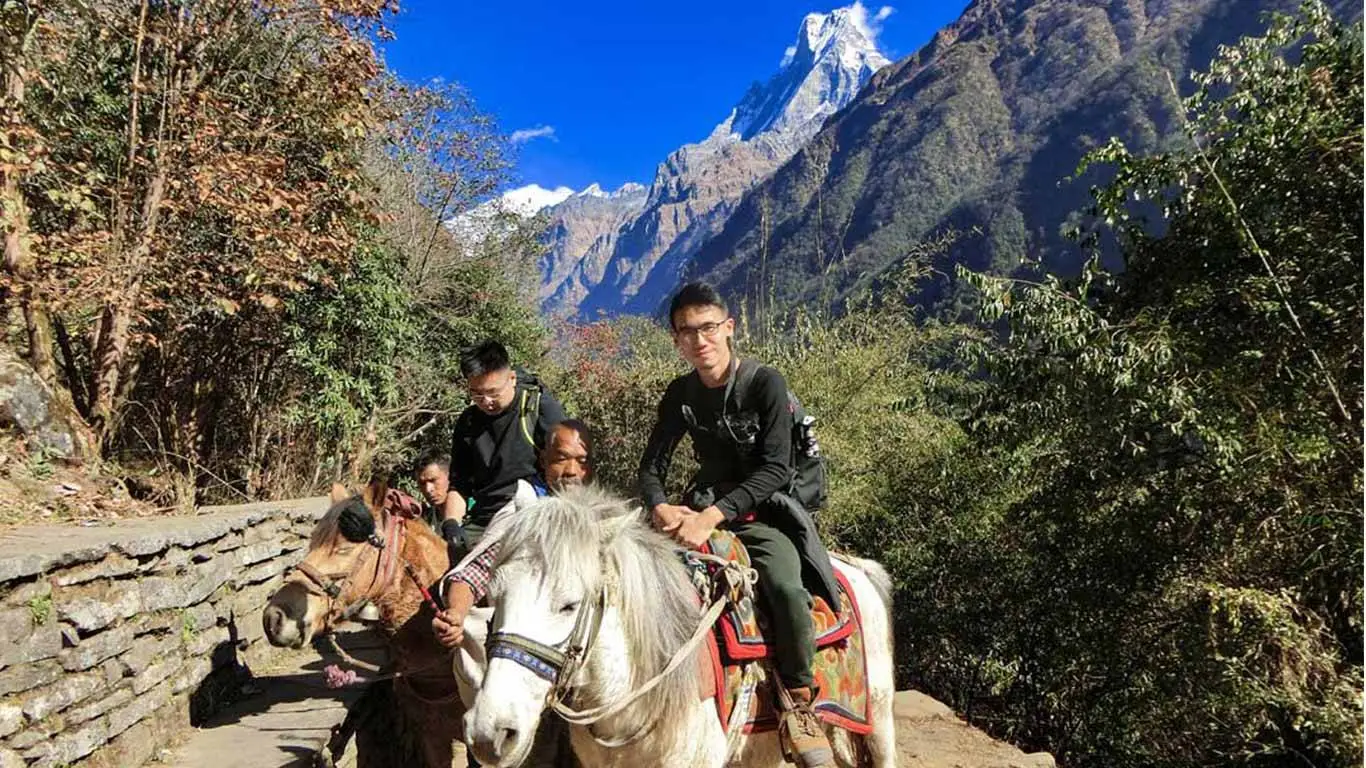
Annapurna Base Camp Trek Difficulty

Everest Base Camp Trek Itinerary and package
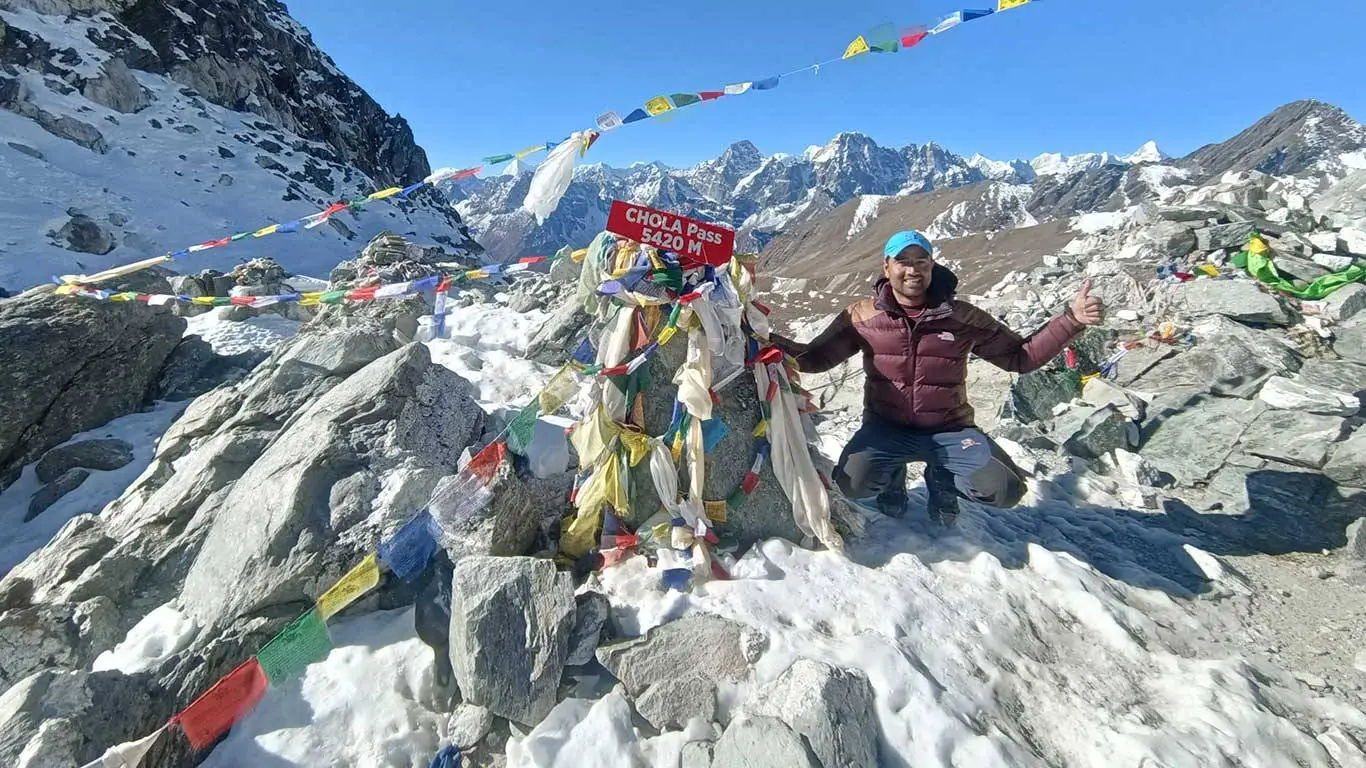
12 Tips To Prepare For High Altitude Trekking


Everest Base Camp Trek vs Annapurna Base Camp Trek, Which Is The Most Difficult?
- March 14, 2024
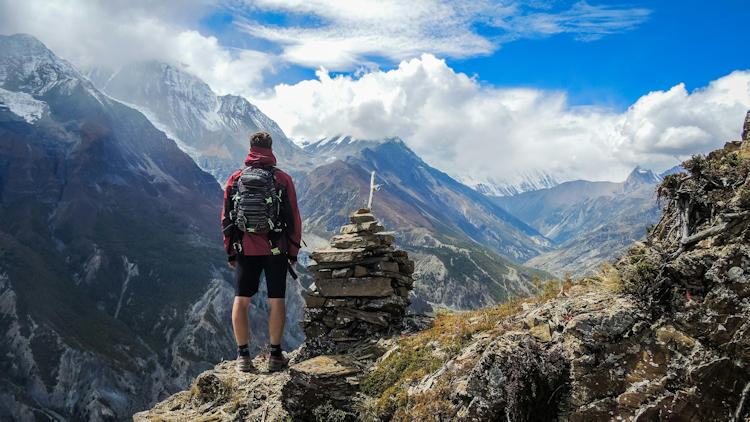
Nepal is widely known as a paradise for adventure seekers and travelers alike as it is home to some of the world’s majestic peaks. It has eight out of the ten highest mountains in the world. Among all those giants, the Mount Everest and Annapurna ranges offer a multitude of trekking trails.
Most of the trekkers often contemplate these two trekking options during their visit to Nepal, generally comparing one another to which one is more difficult. Although both of the journeys have their own identity and course, when it comes to difficulty level, the Everest Base Camp Trek is slightly more challenging than the Annapurna Base Camp Trek.
Having said that, the difficulty level depends on several factors at play such as trekking routes, trekking elevation, weather, and even duration. As both the trekking routes have vast differences and unique destinations, which journey to embark totally depends on what experience one wants to explore.
(Colorful Prayer Flags at the top of Annapurna Base Camp)
While we are at it, we will discuss the factors that make these treks difficult as well as other differences that both these journeys possess.
Trip Duration
Yes, it is indeed true that you can customize the base camp routes to both Everest and Annapurna. However, if we look at the classic route, the distance of the Annapurna Base Camp trek is 110 kilometers while the distance of the Everest Base Camp is 130 kilometers.
Hence, the ABC trek is much shorter than the EBC trek. The classic ABC trek can be accomplished in around 10 days while the classic EBC trek can be completed in around 14 days.
Having said that, you can customize an ABC trek that extends from 13 to 17 days. Similarly, you can extend the EBC trek that extends from as little as 12 to a total of 20 days.
Some of the other routes you can add to this trek are as mentioned below.
In EBC Trek;
- Everest Base Camp Trek and Helicopter Return (12 days)
- Everest Base Camp & Gokyo Lake (17 days)
- Everest Base Camp & Three Passes (20 days)
In ABC Trek;
- Annapurna Circuit Trek (12 days)
- Annapurna Circuit Trek & Nar Phu (16 days)
You can also opt to visit Muktinath and Tilicho Lake during the trek and extend the trip duration to a month.
Accessibility
Although both ABC and EBC treks are located in the Himalayas and have a high altitude, both of them have totally different routes with different starting points. There is no means of land transportation to start the EBC trek while you will have plenty of options to start the ABC trek.
Well, the starting point of the EBC trek is from Lukla which does not have the facility of land transportation. In this journey, you will have to take a 35-minute flight from Kathmandu to Lukla. Therefore, due to bad weather, you will be required to halt your journey.
Also, yes, the return point is the same as a flight from Lukla to Kathmandu. If you have limited time, you can choose to opt for Everest base trek and return by helicopter helicopter to Kathmandu.
Moving on to the ABC trek, you can either choose to transport by land or air. You can take either a local bus or a tourist bus to the starting point of the tour. Likewise, you can also choose to travel via air from Kathmandu to Pokhara but again, you will have to take a bus to reach the starting point.
Trails
While both EBC and ABC trails are in good condition with some steepness, the tracks of ABC are easier than those of the EBC. Apart from that, both of the tracks are heavily crowded during the hot seasons such as Spring and Autumn.
Also, during the off seasons such as Winter and Monsoon, while the trekking route to ABC is open, some of the routes to EBC are off-limits due to heavy snowfall and other risk factors.
Altitude
Both ABC and EBC treks take you quite high in altitude. The starting point of the ABC trek is in Nayapul (at 1,070 meters) while the starting point of the EBC trek is in Lukla (at 2,860 meters).
Moving on, by the time you reach the Annapurna Base Camp, its elevation is 4,130 meters while the Everest Base Camp is 5,364 meters above sea level. And those are not even the highest points of the treks.
Additionally, you can elevate up to 5,416 meters through the Annapurna trek at Thorung La. Similarly, you can elevate up to 5,643 meters through the Everest trek at Kala Patthar.
Trekkers and travelers have to spend more time above 5,000 meters during the EBC trek than in the ABC trek. This means trekkers at EBC trek have to be more physically and mentally prepared.
Often the higher you climb, the less oxygen there is, which creates more risk of facing altitude sickness. Keep in mind that you will have to ascend more and spend more time at high altitudes during the EBC trek, so it carries a higher risk of AMS.
Similarly, ABC trek is shorter than EBC with less acclimatization hence, even if you are suffering from AMS, you can relax and descend quickly to minimize the effect. Therefore, ABC trek can be a perfect point to start altitude trekking for beginners.
But having said that, it is important to note that even professionals can suffer from AMS. So, it is only wise to be prepared beforehand.
Nepal has four seasons; Spring, Summer or Monsoon, Autumn, and Winter. Though both the Everest and Annapurna regions have almost similar weather, it can get highly unpredictable at times.
The Spring season in Nepal usually starts in March and ends in mid-May. It is also called the peak season for trekking as the weather is nice with clear blue skies and moderate temperature. During this season, both the EBC and ABC trekking routes are heavily crowded and you should book everything beforehand to have a relaxing journey.
Likewise, the Summer or Monsoon season in Nepal starts right after Spring with heavy winds and ends in August. The days start to get hotter and bring tons of rainfall. In fact, it rains every single day which makes the trails slippery and prone to natural calamities like landslides. This often affects the lower regions of the trek and if you can push through it, you will be rewarded with the breathtaking views after the shower.
Moving on to Autumn, it is another peak trekking season that stretches from September to November. The days get clearer with mild temperatures and seasonal blooms. The trails start to recover from months-long rainfall and every trail is filled with greenery.
Lastly, the Winter season in Nepal starts in December and ends in February, which brings the coldest days of the year. The trails get lonely and the temperatures in the upper regions can drop up to negative 20 degree Celsius. Furthermore, due to heavy snowfall and risks of avalanches, most upper trails are beyond the limit. While some do embark on the journey during this time, it is only recommended to travel if you are a professional packed with every necessary item.
While you will have to spend a decent amount to embark on either one of the journeys, you should have the basic idea that the higher you climb, the more expensive the items get. The prices get expensive in higher altitudes because there is no proper transportation facility and people have to carry all the resources and materials themselves.
Altogether, we cannot pinpoint one of the treks to be more expensive or affordable as it hugely depends upon the trekking duration, destination, guides, means of transportation, accommodation options, and even the gear.
Trekking Region
The Everest trekking region takes you around Khumbu Valley and through the Sagarmatha National Park as most of the routes take place within it. It is also a sacred place and a natural world heritage site.
Also, inside the Everest region, you will encounter two climatic zones; the temperate zone in the lower Himalayas and the arid mountain zone in the higher Himalayas. The lower zone has flowering landscapes, waterfalls, gorges, and so on while the higher zone has snow-covered peaks, boulders, and many more.
Lastly, the Annapurna region has a conservation area which is seven times larger than that of the Everest region. Unlike the Everest region, the Annapurna Conservation Area has three zones; temperate zone, mountain zone, and subtropical zone.
Culture & Religion
The Everest region lies on the Eastern Himalayan side and is inhabited by the Sherpas. However, the Annapurna region lies in the Central Himalayan region which is inhabited by several ethnic groups such as Gurung, Magar, Tamang, Thakali, Brahmin, and Chhetri.
Hence, if you want to explore a single culture, EBC is the best choice; however, if you wish to explore multiple communities, ABC trek is perfect.
Talking about the Everest region, the Sherpas are known as the best mountaineers of the world. They often follow Tibetan and Buddhist culture. Additionally, they have colorful houses with multiple prayer flags and several cultural attractions such as stupas and monasteries.
Moving on to the Annapurna region, you will find a mix of Buddhism and Hinduism following people. They also have their unique languages and cultural attractions.
Highlights of The Everest Base Camp Trek
- A 35-minute scenic flight from Kathmandu to Lukla.
- Panoramic views of the world’s highest peak, Everest and many other mountains such as Nuptse, Lhotse, Cho Oyu, Ama Dablam, and so on.
- Stunning views from Kala Patthar (5,643 meters).
- Witness the world’s biggest glacier, the Khumbu Glacier.
- Explore the Tengboche Monastery, Gokyo Lake, and Gokyo Ri.
- Opt for Everest’s three highest passes; Kongma La, Cho La, and Renjo La.
- Explore Sagarmatha National Park, Namche Bazaar and Hillary Museum.
Highlights of The Annapurna Base Camp Trek
- Mesmerizing views of the Annapurna ranges, Hiuchuli, Dhaulagiri, Nilgiri, Chulu, Machhapuchhre, and so on.
- Enjoy the hot springs at Jhinu Danda.
- Stunning views from Poon Hill.
- Adventure sports such as paragliding from Sarangkot.
- Breathtaking sunrise and sunset views from high viewpoints.
- Explore the city of lights, Pokhara and enjoy boating in Phewa Lake.
- Witness local villages such as Ghandruk.
Preparation of The Trek
Whether it is the Everest Base Camp trek or Annapurna Base Camp, you will have to be mentally and physically prepared with all the necessary items. Before you embark on these journeys, you must start building your stamina level slowly and steadily by jogging, walking, swimming, or even going to the gym. You can also prepare mentally by doing some relaxing yoga and meditation.
Furthermore, you should also pack essential and right gear as it ensures both safety and comfort during your journey.
Below are the tips to pack your must-have gear.
- Layer your clothes that are quick-drying and comfortable. Examples are wool base layer, down vests or fleece jackets, waterproof jackets and pants, gloves, sun hats, and sunglasses.
- Wear quality and fitting trekking shoes and socks that are waterproof.
- Use a sturdy backpack with multiple compartments, a harness system, a rain cover, and padded hip belts.
- Comfortable, lightweight sleeping bag.
- Adjustable and shock-absorbing trekking poles with a firm grip.
In A Nutshell
Both EBC and ABC treks have their unique features and experiences to offer. If you are confused between any of the two trails to continue, trust us, there is no right or wrong choice for trekking.
Hope we have helped at some level to help you understand the difficulty levels of both treks.
Frequently Asked Questions (FAQs)
Which mode of trekking is suitable for EBC or ABC; independent or group?
While trekkers and travelers from around the world embark on these tours both independently and in a groups. We advise people to at least start this journey with a partner or even a professional guide.
Sign-up for Our Email Newsletter
Find a luxury hotel & book with exclusive perks.

- Luxury Partners
Villa Lala — Romantic Boutique Hotel in Puerto Vallarta

Cabo Platinum - Cabo San Lucas Luxury Villas, Yachts & Concierge Services

Villa Firenze Costa Rica

JUP - Personal Service for Buying and Selling Real Estate in Jupiter, Florida

Polaris Slingshot - A three-wheeled sensation that re-ignites your love for driving

Rancho Valencia Resort & Spa - Rancho Santa Fe, California - One of the West’s most sought-after five star resorts

Tuscan Dream - Immerse Yourself in the Tuscan Villa Vacation Experience

Grand Hotel Portovenere - Cinque Terre - Discover this beautiful region of Italy!

Dude Ranchers Association - An all-inclusive vacation experience like no other

El Encanto, A Belmond Hotel - Santa Barbara, California - Experience timeless Californian glamor.

The Ranch Italy at Palazzo Fiuggi - The Ranch Malibu brings its award winning wellness program just 50 minutes from Rome.

Grand Hyatt Kauai Resort & Spa - Poipu, Kauai, Hawaii - Beachfront Resort

Culture, Spirituality, and Wellness in Japan's Tochigi Prefecture

Blue Waters Resort & Spa - Antigua - A hidden gem nestled in a private bay on Antigua's northwestern coast with sunset views

A.M.A Selections - Luxury Villa Rentals throughout Europe

Come Together Wellness - Rest, Restore & Explore on Kauai
Red Savannah: Luxury Villas and Tailor-Made Holidays

Live Aqua Beach Resort Cancun, Mexico - Adults Only, All Inclusive

Argentario Golf & Wellness Resort - Porto Ercole, Tuscany, Italy

The Kayon Jungle Resort - Ubud, Bali, Indonesia - a sanctuary of tropical indulgence.

Porto Zante Villas & Spa - Zakynthos, Greece - The leading villa resort in Europe

Fairmont Le Château Frontenac - Quebec City, Canada - Breathtaking views of the St. Lawrence River and the UNESCO Old fortified city

IMAGES
COMMENTS
There are fewer steep climbs and the average altitude is much lower. Plus, instead of being funnelled into the Khumbu Valley on Everest, you can choose from a variety of trails, some of which don't exceed 2000m in altitude. The descents on Annapurna are also a bit gentler, which can help the knees in the long run.
The Everest trek gets you closer to the heart of the high mountains than the Circuit, which offers more in the way of traditional village life. Finally, Everest Base Camp is an out-and-back trek, so you'll repeat some sections, whereas Annapurna is by its nature an A to B loop. Annapurna's trails start an hour's drive from the town of Pokhara ...
Both the Everest Base Camp vs Annapurna Base Camp Trek are popular trekking routes, but they differ in terms of cost. The Everest Base Camp Trek is considered to be the more expensive of the two treks due to the high altitude and remote location. The cost of the trek can range from $1,000 to $2,500 depending on the type of package you choose.
How to reach Annapurna and Everest base camp? The table below gives full information about day-wise activity for Annapurna and Everest base camp trek. It takes 13 days for ABC trek and 15 days for the EBC trek. You should walk 3-7 hours regarding your destination per day in both trek ABC and EBC. Itinerary for Annapurna vs. Everest Base Camp Trek
The Annapurna Circuit requires us to trek to a slightly lower altitude than the Everest Base Camp trek, as shown in the graph below. The Annapurna trek begins in Upper Pisang, which is a village 3,300 m (10,827 ft) above sea level.
Annapurna Base Camp Trek. The Annapurna Base Camp (ABC) Trek is a captivating journey through the heart of Nepal's Annapurna region, renowned for its stunning landscapes and breathtaking mountain vistas. Beginning in the picturesque city of Pokhara, this trek offers a diverse range of experiences, from walking through lush subtropical forests and terraced fields to immersing yourself in ...
Annapurna Base Camp Trek vs. Everest Base Camp Trek: A Comprehensive Comparison by Sole Encounter Trek Introduction:
The standard Annapurna Base Camp Trek length is 110 km, while the Everest Base Camp is 130 km. So, the Annapurna Base Camp is shorter compared to Everest Base Camp. However, you can complete both of these treks through different routes, which can alter the number of days you will require to complete these treks.
The Everest Base Camp Trek is similar in duration to the Annapurna Circuit. It can be completed in about 12-14 days if flying in and out of Lukla. You could extend the trek by staying additional days in Namche Bazaar (highly recommended), or trekking to Gokyo Ri, for a total of 16-18 days in the mountains.
The Everest Base Camp trek is an out-and-back route, starting and ending in Lukla. It takes 12 - 13 days depending on your precise itinerary. The ascent to Everest Base Camp takes a min of 8-days, and the descent is at least half that time. Given its popularity, the route can get very busy, especially the first few days which is a bottleneck.
Heading to the Himalayas for a trek is an amazing adventure. Two popular treks in Nepal are the Everest Base Camp Trek (EBC) and the Annapurna Base Camp Trek
This journey can take you to two summits over 8,000 meters: Annapurna I (8,091m) and Mount Dhaulagiri (8,167m). Mount Fishtail (6,993m) shines even brighter on this climb, with its best shape. The nicest mountain views in this walk may be seen at Poonhill (3,210m) and Annapurna base camp (4,200m).
Annapurna Base Camp. Annapurna Base Camp is a different kettle of fish. Located in the heart of the Annapurna's some 200km to the west of Everest, the area is accessed through Pokhara, a 6 hr drive or 30 min flight from Kathmandu. The trek length is similar but at 4130m, the maximum altitude on this trek is much lower.
Annapurna Base Camp is at a lower altitude, making it easier on the body due to more oxygen. The terrain in Annapurna is gentler compared to the rough trails of Everest. The duration of the Annapurna trek is shorter, allowing for gradual acclimatization. The Everest Trek requires more walking and acclimatization, making it more physically ...
The longer duration also contributes to the higher cost of the trek in the Everest region. You will pay around USD 1200 for a typical Annapurna base camp trek (excluding international flights), whereas you will be paying around 400 more for a typical 16 days Everest base camp trek. 6.
On average, a basic Annapurna Base Camp Trek of 7-10 days can cost around $500-$800 per person, while a more luxurious trek with better accommodations and services can cost upwards of $1500 per person. The cost usually includes the necessary permits, transportation, food, accommodations, and a guide and porter.
The cost of Everest Base Camp trek is more than you need to spend in Annapurna. Due to both way flight of Lukla, Permit, the cost of food, and accommodation, Everest base camp trek cost is higher than ABC. In Annapurna base camp trekking, you can choose local transportation to reduce the trek cost.
In contrast, the Annapurna Himalaya are only a short drive from Pokhara. The Everest Base Camp trek, however, is far from the only trekking option in the area. If you're seeking a greater challenge, or want to avoid the busiest trails, check out one of the following options instead: Everest Panorama. Gokyo Lakes & Everest Base Camp.
It is hard to choose the best trek among Annapurna and Everest Base Camp Trek. Both of these treks are fabulous and remarkable and are the most desired trekking route. Annapurna Base Camp Trek is a moderate trek with the beautiful scenery of villages, hills, forests and mountains, waterfalls etc all over the trekking trail.
The Annapurna Circuit Trek vs Everest Base Camp Trek offers incredible Himalayan adventures. However, the choice depends on your preferences, interests, and the kind of experience you are seeking. Whether it is the cultural immersion of the Annapurna Circuit or the iconic height of the Everest Base Camp, both journeys offer unforgettable mountaineering experiences.
Annapurna Sanctuary Trek. Comparatively, Annapurna Sanctuary Trek is a little less challenging and less difficult trek than the Everest Base Camp. The altitude of this trek is 4,130 meters at its highest point. The trail is more achievable as it has fewer demanding uphill climbs.
There's a strong chance you'll suffer altitude sickness on this trip because it leads you above 4000m. Talking about Everest Base Camp vs Annapurna Circuit, the Everest trip will take you to Kala Patthar, which is located at an elevation of 5545 meters in the Everest region. On the other hand, the peak of Annapurna reaches a height of 4130 ...
However, if we look at the classic route, the distance of the Annapurna Base Camp trek is 110 kilometers while the distance of the Everest Base Camp is 130 kilometers. Hence, the ABC trek is much shorter than the EBC trek. The classic ABC trek can be accomplished in around 10 days while the classic EBC trek can be completed in around 14 days.